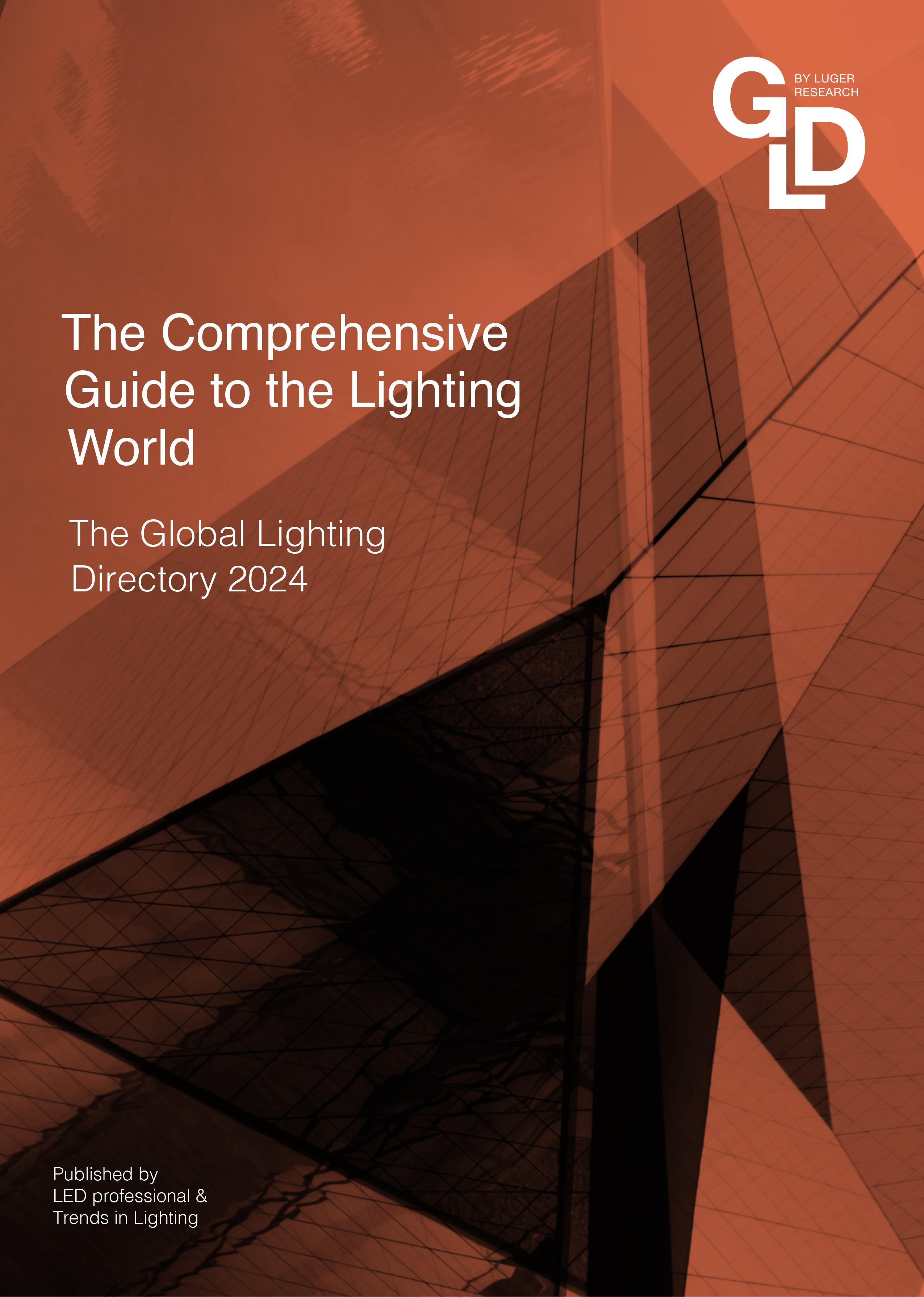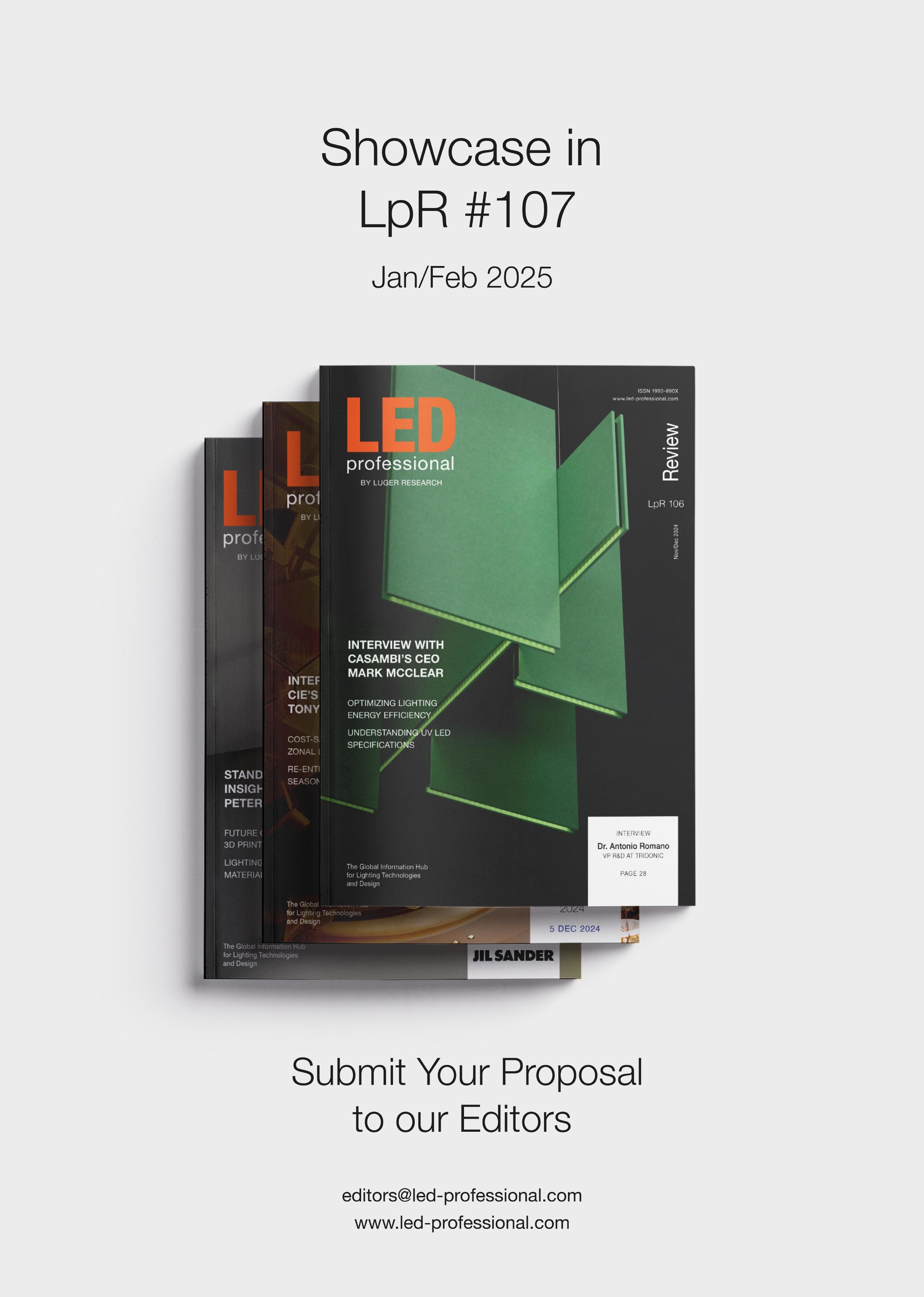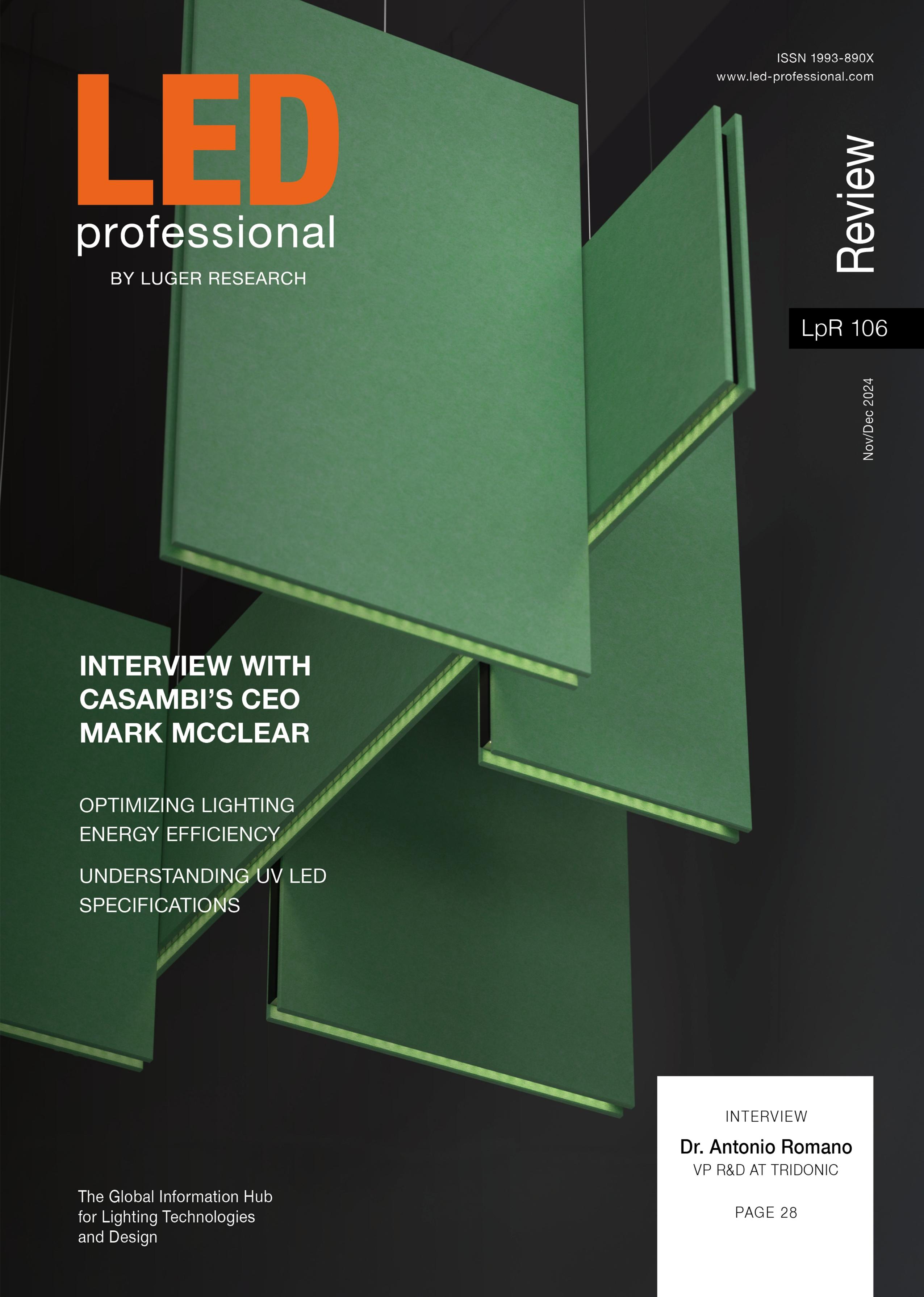
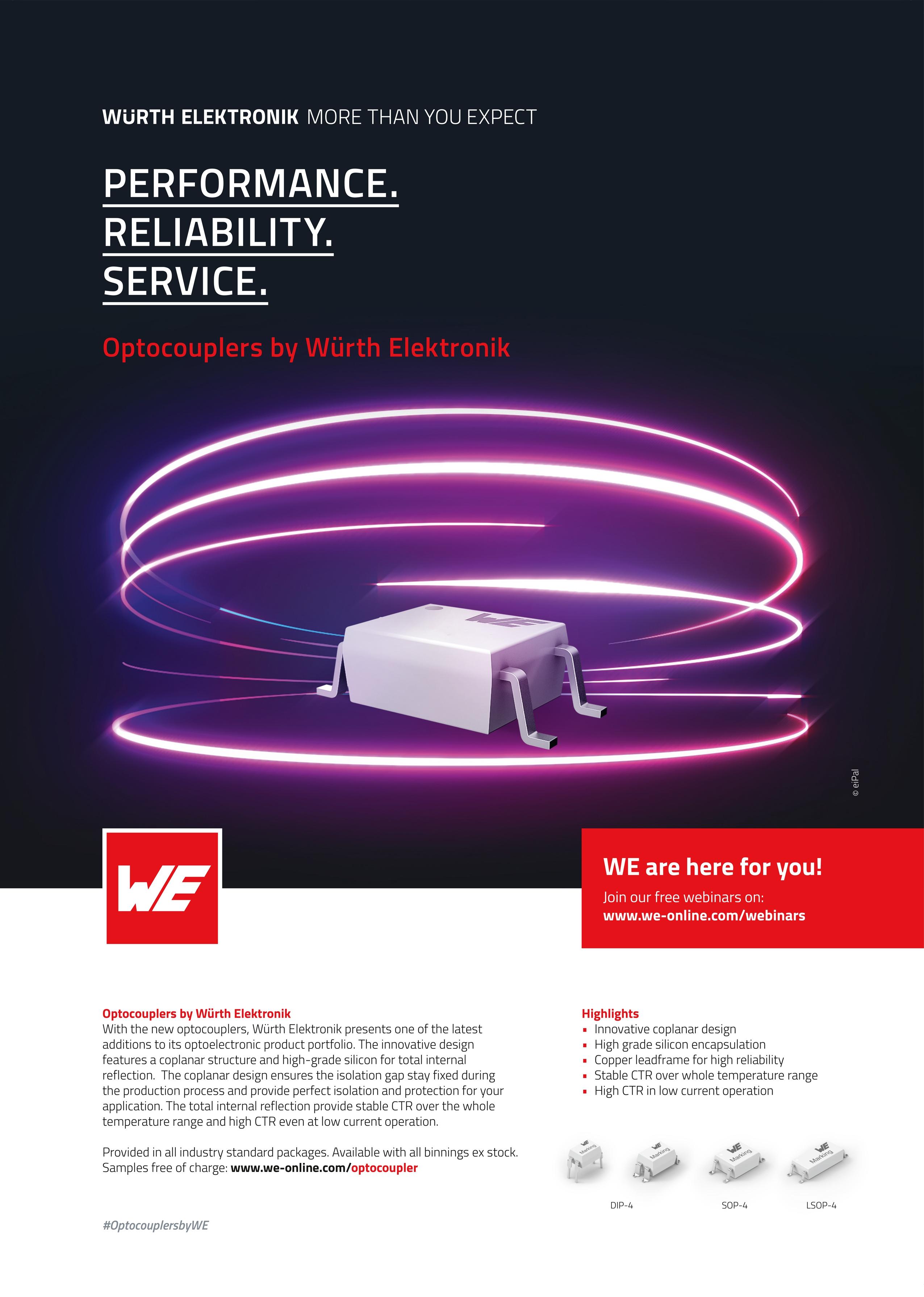
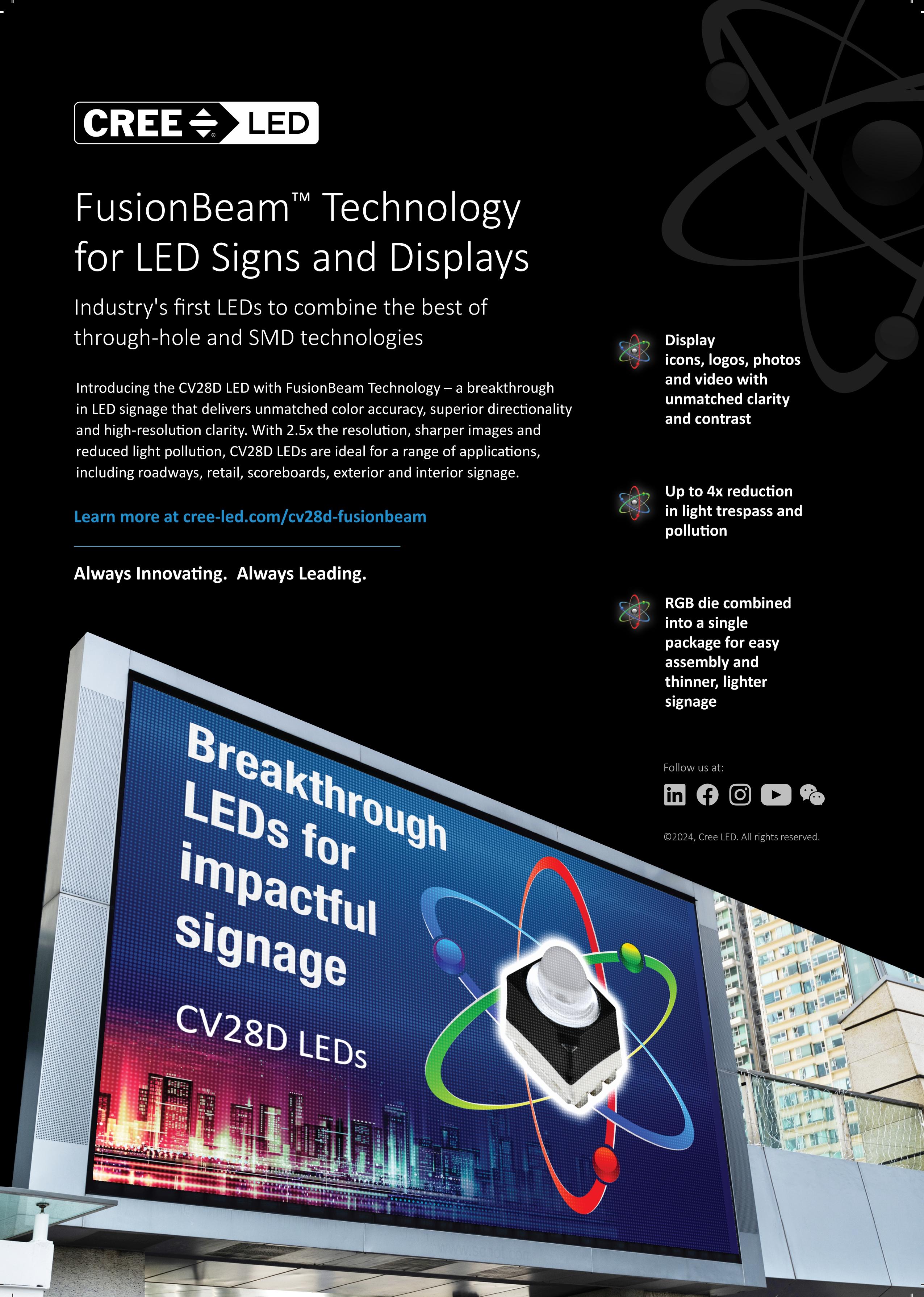
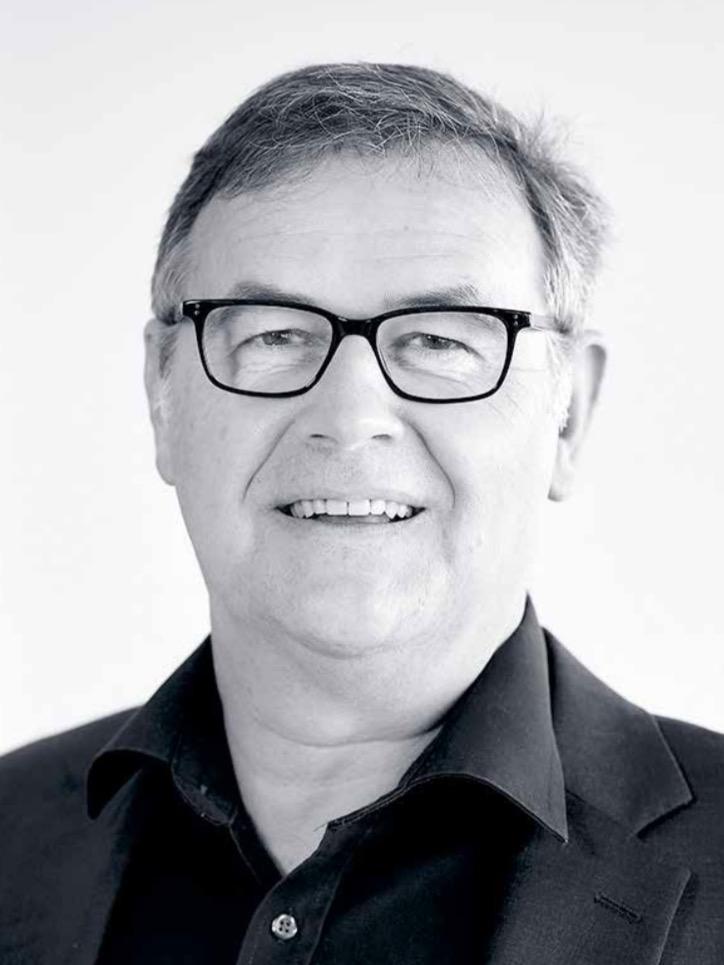
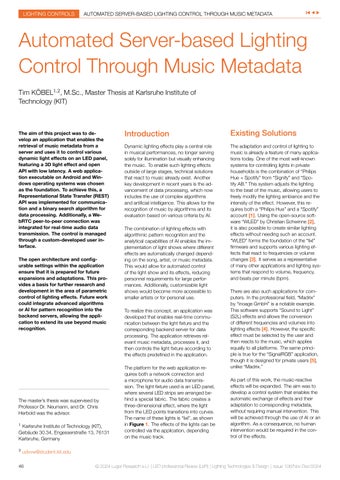




InthisissueofLEDprofessionalReview(LpR),we’reshiningaspotlighton lightingcontrolinnovations.MarkMcClearandAntonioRomanoshare theirexpertperspectivesontheworldofcontrolsandthesolutions shapingthefutureoflighting.
Wealsofeaturethefirstsegmentofatwo-partresearchreportfrom Bartenbach,detailingtheirgroundbreakingapproachestooptimizing energyefficiencyinlightingsystems.Thesecondinstallmentwillappearin theJanuary/Februaryissue.Twoengineering-focusedarticlesshowcase excitingadvancements:modernmethodsandadeeperunderstandingof thermaldesign,aswellasUVLEDspecifications,openingdoorstonew applicationsandproductinnovations.
TimKöbelfromKITintroducesustoararelyexploredfrontier—lighting controlsthatare,themselves,managedbylight.Thisserver-based approachisfascinatingandcouldserveasablueprintforentirelynew lightingcontrolsystems.Inourvideochapter,we’reexcitedtopresent threebrand-newYouTuberecordingsonLpSDigital.Inthisthree-part series,LuminusDevicestakesusthroughthecompany’soriginsandtheir keyfocuses:LightforLivingandLightforWorking.
InPeterDehoff’scommentaryitbecomesclearthatachieving‘good lighting’isacomplexprocessrequiringbothtechnicalexpertiseanda deepunderstandingoftheneedsandexpectationsofall stakeholders—frommanufacturerstoarchitectstoendusers.
Withthisinstallment,wewrapupoursix-issueseriesfor2024.Wethank youforyourtrustandwishyouallahappyandsuccessfulstartto2025!
Enjoyyourread!
YoursSincerely,
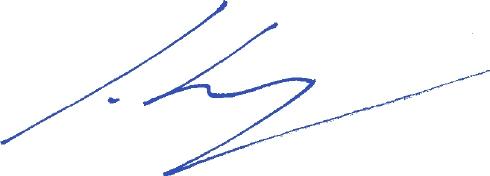
SiegfriedLuger
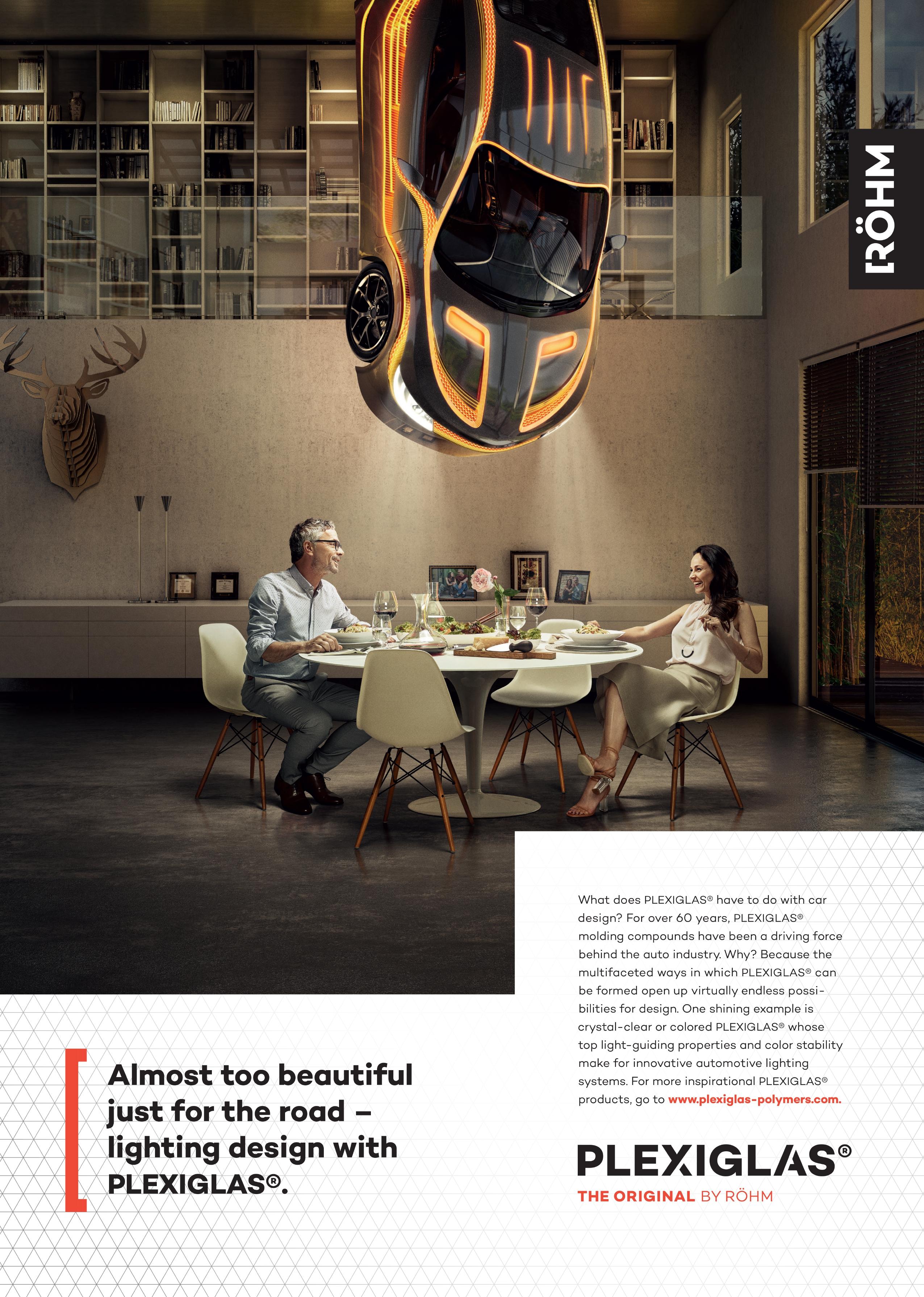
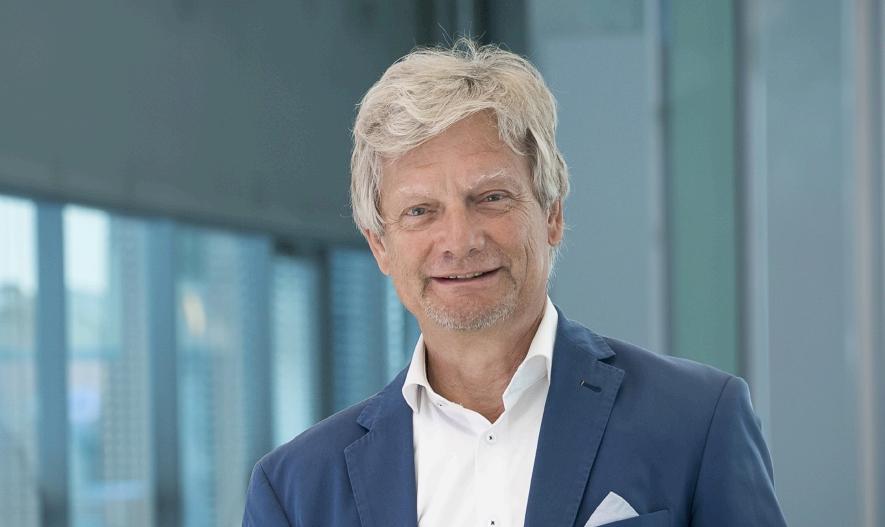


AntonioA.ROMANO,VPR&DatTridonic
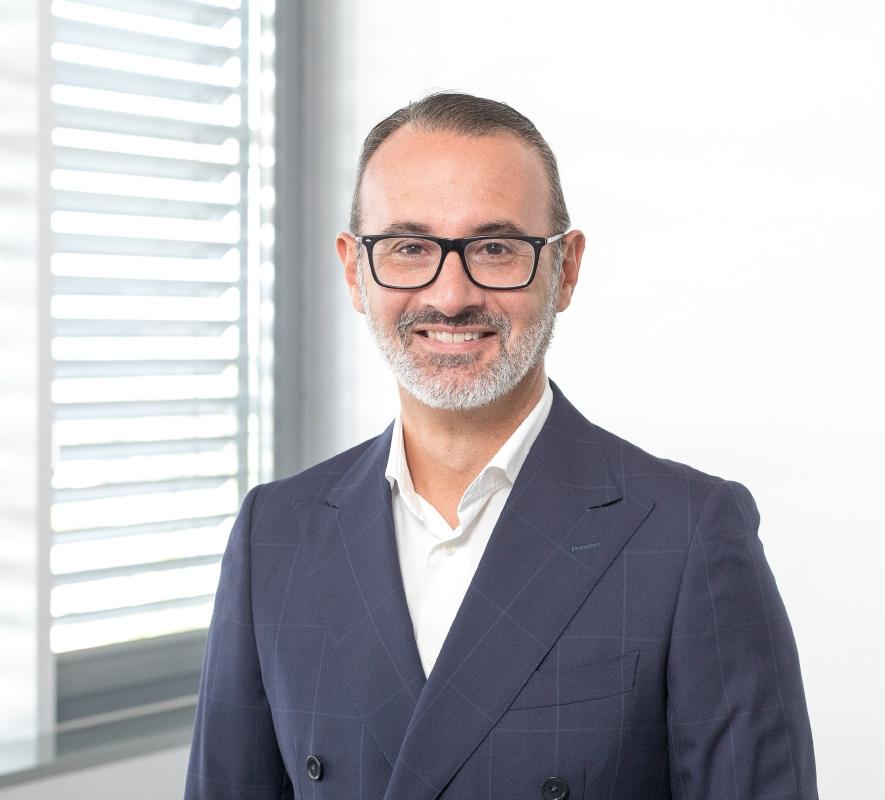
OptimizingLightingEnergyEfficiency (PartI)–BehavioralAspectsofEnergy Consumption byDipl.-Ing.JohannesWENINGER,Dr.techn. SaschaHAMMES,M.Sc.,Bartenbach
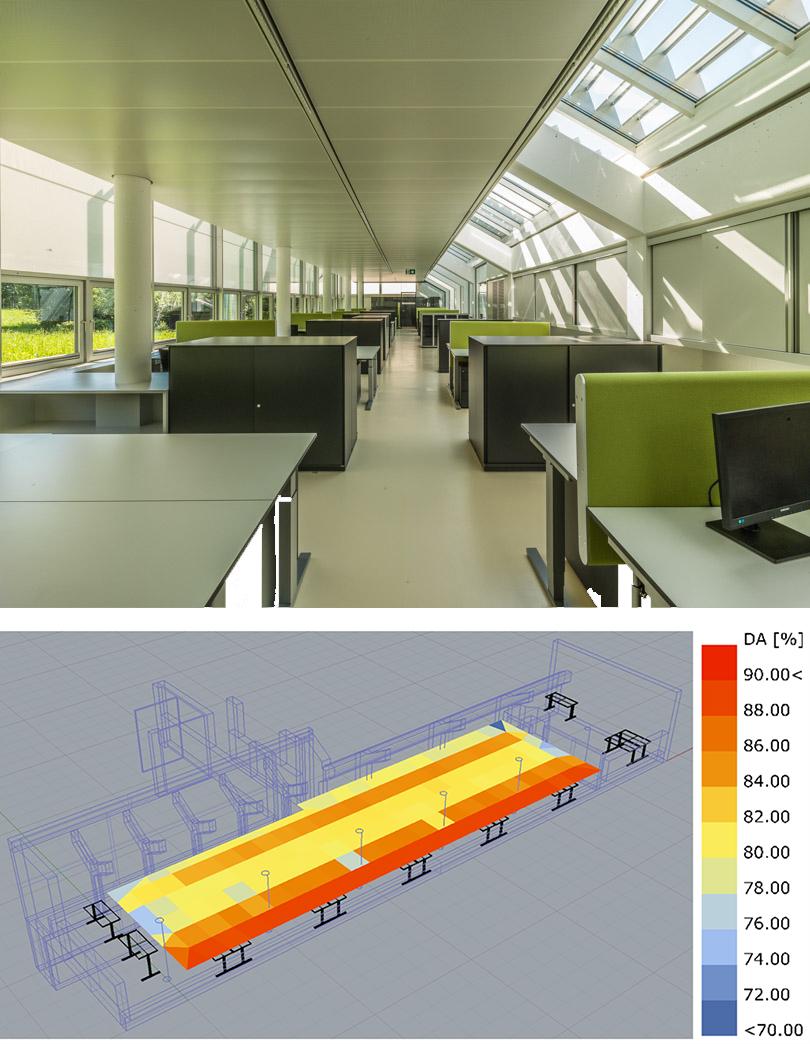
44 InnovativeLightingMeetsAdvanced Engineering:InsidetheCreationofthe LuvoLEDLamp byOmidJAVANMARDI,DesignEngineeratLuke RobertsLightingandAlexFISCHER,Product ManageratSimScale

46 AutomatedServer-basedLighting ControlThroughMusicMetadata byTimKÖBEL,M.Sc.,KarlsruheInstituteof Technology(KIT)

52 UnderstandingUVLEDSpecifications:A SelectionBlueprint byDr.PratibhaSHARMA,Directorof ApplicationsR&DandSayaHAN,Director BusinessDevelopment;Violumas

56 ExpertTalksonLight–LUMINUS,ImprovingLifewithPhotons

58 ABOUT|IMPRINT
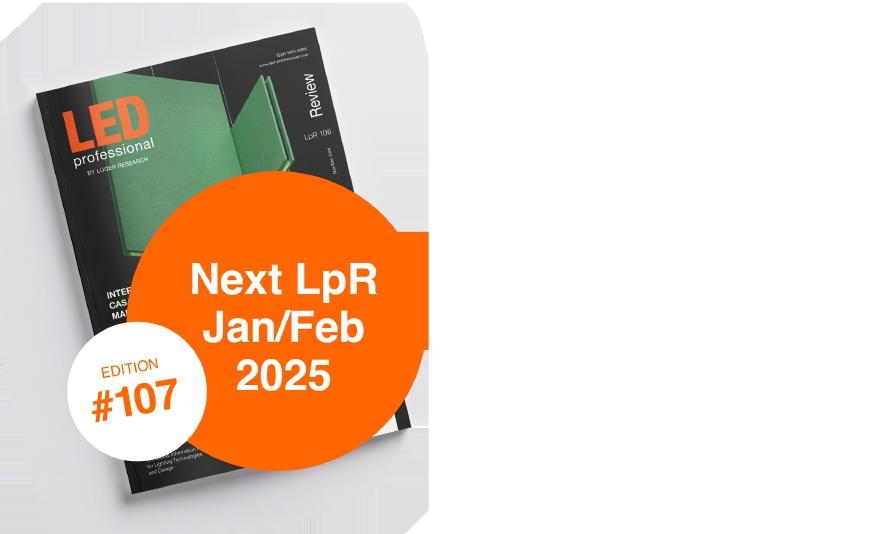
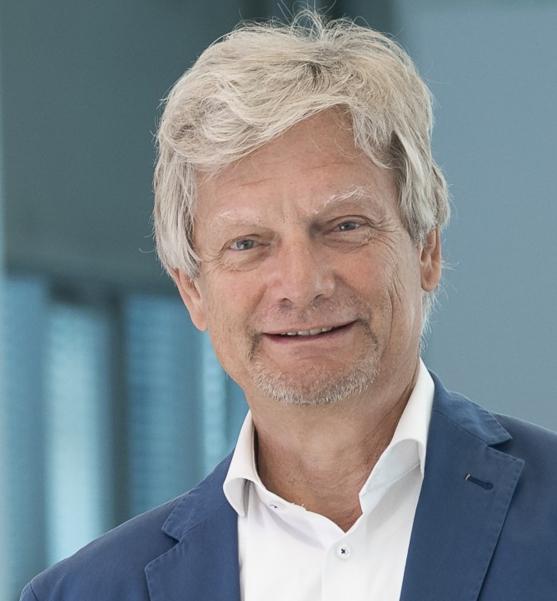
PeterDehoffisDirector ProfessionalAssociationsand StandardizationatZumtobel Lighting,Austria,andismember ofnumerousassociationsand standardizationorganizationsand chairofseveralworkinggroups (CIE,ISO,CEN,ASI,DIN,ZVEI, AKlicht.de,LiTG,LTG,FEEI,Lux Europa).
HeisalsoPresidentofthe AustrianNationalCommitteeof CIE,ConvenorofCENTC169 WG2“Lightingofworkplaces”, ConvenorofISOJWG5“Lighting ofworkplaces”,ConvenorofAK licht.de(ZVEIGermany),and Boardmemberoflightingsocieties LiTGandLTG.Lecturer
/1/TUKarlsruhe,Lighting Engineering:education
/2/ZumtobelLightingDornbirn: employeesince1987
/3/TUGraz,lecturersince1994
/4/TUDarmstadt:lecturersince 2011
/5/LiTG36LightingQuality–a processratherthananumber
/6/EN12464Lightingofwork places
/7/CENTS17165Lighting SystemDesignProcess
/8/CIE222Decisionschemesfor lightingcontrols
/9/licht.wissen19:Nonvisual effectsoflight
/10/licht.wissen21:Guidefor HumancentricLighting
linkedin.com/in/peter-dehoff90806449
Itdependsonwhoisaskedthis question.Manufacturersofluminaires andcomponentssayawell-shaped productwithLEDs,modernelectronics andsensorsistheprerequisiteforgood lighting.Architectsandlighting designerssaylightingthatiswell integratedintothebuildingisgood lighting.Ausermaysayaluminairethat Ilikeisgoodlighting.Soiseverything clearandsimple?Ihaveconstantly pursuedthequestion‘Whatisgood lighting?’inmyprofessionallifeandwill takeyouwithmetothestages/x/,that documentmypathandmyinvolvement.
Atuniversity/1/andinthecourseofmy professionalcareer/2/,expert knowledgehasmaturedwithtechnical terms,definitionsandanetworkof people.Isknowledgeenoughforgood light?Withmystudentsofarchitecture whoonlyhaveashortcourseforlighting design/3,4/Istartfromscratchand firstask‘questionsaboutlight’:initially without,thenwithreferenceto architecture.Thisintuitiveapproach revealsobviousknowledgeanda surprisinglackofknowledge.Thenthey askthemselvesquestionsaboutlight andtheystarttolookforanswers.They becomecuriousaboutgoodlight. Lightingqualityisaprocess/5/:without beingexperts,thearchitect,clientand customermakefunctional,biological, psychologicalandarchitectural demandsonlight-wehaveformulated 30possiblerequirementsinasimple wayandfreefromexperttermsthat formthespecificationsforlighting design.Later,afterlightingdesignand inarealizedproject,thelightingquality canbeevaluatedonthebasisofthese demandsandexpectations.Cangood lightbepredicted?Lightingdesigners candrawontheirexperience,butalso onstandards/6/.Whenwritingthe standardsasexperts,werecommend measuresasmaintainedilluminances, theirmodifiers,glarelimitation,color, daylightandmoretofulfilvisualtasksin anappropriatelyilluminatedroom.Does compliancewiththecriteriaguarantee goodlight?Itisalsoadvisedtomake lightingcontrollable,i.e.togivetheuser theoptiontochangelightinglevelsor lightingscenes.Thisisasimple
requirement,butonethatisoftennot realizedinpractice.Decisionsonlighting controlandluminaireselectionaremade atdifferenttimesandlightingisoftena verylateadditiontotheconstruction process.Alightingconceptwith controlsshouldbedrawnupveryearly andthenputintoservicebyall responsiblepartiesi.e.lightingand electricalplanningandinstallationwhich includeluminaireselection.Thelighting systemdesignprocess/7/startswith theclient’srequirementsforlighting quality.Atthisstage,theoptionsfuture userswillhavetointerveneinthelighting shouldalreadybeestablished/8/.A decisionschemehelpstoselectthe controlsystemwithaviewtoenergy efficiency,lightingqualityanduser acceptance.Ideally,theavailable lightingscenesshouldalreadybegiven anameduringthedesignphase.The lightingcontrolconceptshouldbe knownandimplementedbythe electricalplannerandlaterbythe electricalinstaller.Referenceshouldbe madeheretoHumanCentricLighting, whichrequiresplanningand considerationofthelong-termvisual andnon-visualeffectsoflightonpeople /9,10/.Well-plannedlightingscenes and,inparticular,comprehensible operabilitybyusersareessential componentsoftheconcept.Thereis stillagreatdealofdesignpotentialhere forlightingdesignersandproductsfrom thelightingindustry.
Inthis,mybeautifulworldofgood lighting,itisthereforeimportantfor everyoneinvolvedintheprocessto worktogether.Itisimportantto recognizetheinterfacesandreduce possiblesourcesoferror.Clientsare oftennotlightingexpertsandyetthey haveanideaofalightingsolution. Architectsandlightingplannerstranslate requirementsintolightingconceptsand ideallycoordinatethemwithelectrical planners.Installersrealizelightingwith suitableluminairesandcomprehensible lightingcontrolandputthesysteminto operation.Knowingthelightingscenes, theylabeltheoperatingdevices.Thus, usershaveaccesstogoodlight. Thatistheidealworld. ■

GreenDealLegislationto SupportMembersin Compliance
www.lightingeurope.org
LightingEuropeisprovidingacompendiumof keyEUGreenDeallegislationforthelighting industry,aimedathelpingmembers, particularlysmallercompanies,complywith newsustainabilityregulations.
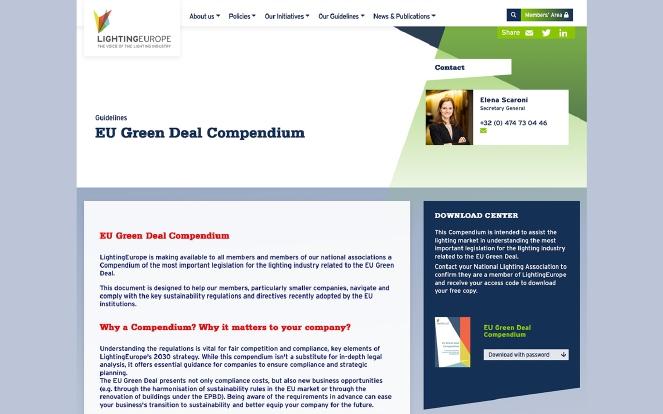
Thisdocumentsupportsunderstandingof essentialrulesforeffectiveenforcementand faircompetition,inlinewiththe LightingEurope2030strategy.Whileitdoes notreplacedetailedlegislativeanalysis,itisa valuableresourceforcomplianceand strategicplanning.
ElenaScaroni,LightingEurope’sSecretary General,stated:“Ourteamhasactively participatedinthelegislativeprocessandis nowassistingmemberswithimplementation byprovidingtheknowledgeandinsightwe haveaccumulatedovertheyearsinasingle document.Byunderstandingthese requirements,companiescannotonlycomply butalsograbnewopportunitiesinthegreen economy.”
TheCompendiumincludeslinkstoofficialEU textsandcommentedsummaries.
TeresaSelvaggio,LightingEurope’sDirectorof PublicAffairsadded:“Thesummariesand commentsarebasedoninputfromourstaff, othertradeassociationsweregularlywork with,andevenfeedbackfromEUofficials duringlegislativediscussions.”
TheinformationrepresentsLightingEurope’s readingoftherequirementsanddoesnot constituteanofficialinterpretationofthe legislativetexts.
HowtoAccessYourCopy
• LightingEuropeMembers:Downloadfrom theMember’sarea,Causeway.
• NationalAssociationMembers:Requesta passwordfromyourassociationtoaccess
theCompendiumontheLEpublicwebsite atthislink.
Contact:ElenaScaroni,SecretaryGeneral (elena.scaroni@lightingeurope.org)
AboutLightingEurope
LightingEuropeisthevoiceofthelighting industry,basedinBrusselsandrepresenting 32companiesandnationalassociations. Togetherthesemembersaccountforover 1,000Europeancompanies,amajorityof whicharesmallormedium-sized.They representatotalEuropeanworkforceofover 100,000peopleandanannualturnover exceeding20billioneuro.LightingEuropeis committedtopromotingefficientlightingthat benefitshumancomfort,safetyand well-being,andtheenvironment. LightingEuropeadvocatesapositivebusiness andregulatoryenvironmenttofosterfair competitionandgrowthfortheEuropean lightingindustry.Moreinformationisavailable atwww.lightingeurope.org. ■
www.lightingeurope.org
TheundersignedNGO’s,consumer organizationsandbusinessandtrade associationsareseverelyimpactedbytherole ofonlinemarketplacesine-commerce.We areunitedtorequestalevelplayingfieldfor onlinemarketplacesandeffective enforcement.
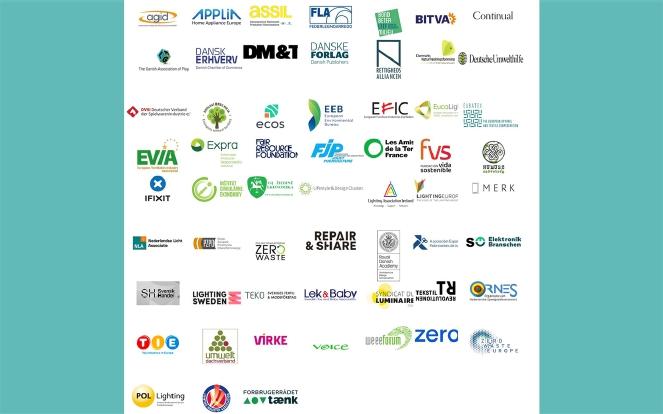
Itisaprioritytocloselegalloopholesinthe regulationandenforcementofonlinetradevia onlinemarketplacesduringthe2024-2029 mandate.Insufficientresponsibilitiesforonline marketplacesandtheineffectiveenforcement ofexistingEUrequirementsharmthe environment,consumers,thecompetitiveness ofEuropeanbusinesses,thefunctioningofthe internalmarket,andthecredibilityandimpact ofEUlegislation.
Whileweunderstandthattheroleofonline marketplacesissignificantfortheEU’s economy,wewanttodrawattentiontothe
ever-increasingnumberofnon-compliant productsavailableontheEUmarketthrough onlinemarketplaces.
Themassivedirectimportsviaonline marketplacesareveryrelevantintheEU internalmarket.However,insufficient responsibilitiesforonlinemarketplacesand theineffectiveenforcementofexistingEU requirementsharmtheenvironment, consumers,thecompetitivenessofEuropean businesses,thefunctioningoftheinternal market,andthecredibilityandimpactofEU legislation,asforexample,intheGreenDeal andtraditionalproductandchemical legislation.
NeithertheDigitalServicesAct(DSA),nor ProductSafetylegislationnortheGreenDeal haveaddressedthiscriticalloophole:Online marketplacesarenotconsideredeconomic operatorsnortobeplacingproductsonthe market.
Weurgetoaddressthisloophole,andwe proposesomerecommendations,toensure thatEUlegislationensuresthatalloperatorsin theEUInternalMarketcomplywithEU standards,fosteringafairandcompetitive Europeanmarket,preventingunfairpractices andenhancingenforcementbybothMember StatesandEuropeanauthorities.Those recommendationsare:
• Recognitionofonlinemarketplacesas economicoperators,andrecognitionthat theonlinemarketplacesareconsideredto beplacingtheproductsonthemarketif thereisnoothereconomicoperatorinthe EUthatcanbeconsideredtohaveplaced theproductontheEUmarket;
• EnhancedObligationsforonline marketplaces;
• ImprovedProductTraceability;
• EquipCustomsAuthoritieswithbetterrules tostopillegalimportsthroughsmall packages;
Thankingyouforyourconsideration,we remainatyourdisposalshouldyouhaveany questions.Pleasenotethatthestatementis attachedandalsoavailablehere.
Yourssincerely, ElenaScaroni,Secretary-Generalof LightingEuropeonbehalfoftheundersigned signatories.
AGID;Applia;Assil;Assoluce;BBLV;BITVA; Continual;DanishAssociationofPlay;Danish ChamberofCommerce;DanishConsumer Council;DanishFashion&Textile;Danish Publishers;DanishRightsAlliance;Danmarks Nature;DUH;DutchToyIndustryFederation; DVSI;EcologistsWithoutBordersAssociation; Ecos;EEB;EFIC;Eucolight;EURATEX; EuropeanVentilationAssociation;Expra;Fair ResourcesFoundation;FrenchToy Association;FriendsoftheEarthFrance; FundaciónVidaSostenible;Humusz;Ifixit;

INCIEN-Inštitútcirkulárnejekonomiky; InstituteCircularEconomyLithuania;LAI;LIA; LifestyleandDesignCluster;LightingEurope; Merk;NLA;PolishAssociationofLighting Industry;PolishZeroWasteAssociation; PZPO;Repair&Share;RoyalDanishAcademy; SpanishAssociationofToyManufacturers; SwedishAssociationofTechnologies; SwedishCommerce;SwedishLighting Industry;SwedishTextileandFashion Industries;SwedishToyandBaby Association;SyndicatduLuminaire;Textiles Revolution;TIE;Umweltdachverband;Virke, theNorwegianFederationofCommerce; VoiceofIrishConcernfortheEnvironment, VOICE;WEEEForum;ZERO;ZeroWaste Europe. ■
www.casambi.com
Globalleaderinwirelesssmartlightingcontrol, Casambi,ispleasedtoannounceasignificant leadershiptransitionaspartofitsbroader strategyforacceleratedgrowth.Effective November1,2024,KayPawlikhasassumed theroleofChairmanoftheBoard,succeeding long-standingchairmanAnttiKokkinen.This changemarksagenerationalshiftin Casambi’sleadership,aimedatsupporting thecompany’scontinuedexpansioninitscore marketsofEMEA,NorthAmerica,andAPAC.

Overthepastyear,Casambihasseen remarkablegrowthandispoisedforeven fasterexpansioninthecomingyear.Recent strategicdecisions,bothfromtheBoardof DirectorsandManagementTeam,haveset thestageforthisnextphase,whichfocuses onincreasingmarketshare,deepening expertiseinlightingapplications,and
strengtheningtheorganizationtomeetfuture demand.
AnttiKokkinen,whohasservedasChairman formorethanadecade,playedapivotalrole inshapingCasambi’ssuccess.Underhis leadership,thecompanytransformedfroma softwarestartupwithzerorevenueintoa globalleaderinwirelesslightingcontrols.
”Antti’sleadershiphasbeeninstrumentalin ourjourneytobecomingthegloballeaderin wirelesslightingcontrol.Onbehalfofthe entireCasambiteam,togetherwithour shareholders,Iwouldliketoextendour deepestthankstoAnttiKokkinenforhis invaluablecontributionsoverthepast decade,”saidCasambiCEO,MarkMcClear. ”Weareincrediblygratefulforhiscommitment andguidanceovertheyears,andweare excitedtowelcomeKayasournewChairman asweenterthisnewphaseofgrowth.”
KayPawlik,whohasservedonCasambi’s Boardsince2023,bringsover25yearsof managementandadvisoryboardexperience inthelightingindustry,includingleadership rolesatERCOandDIAL.Hepossessesdeep expertiseinbothlightingapplicationsand controls,combiningstrategicleadershipwith technicalknowledge.Thisbroadindustry experiencepositionshimwelltotakeonthe roleofChairman,wherehewillguideCasambi throughitsnextphaseofgrowthand innovation.
”Iamhonoredtotakeonthisnew responsibilityatsuchanexcitingtimefor Casambi,”saidKayPawlik,thenewChairman oftheBoard.”Thecompanyhaslaidastrong foundationforthefuture,andIlookforwardto workingcloselywithMarkandtheentireteam aswepushforwardwithourambitiousgrowth plans.”
AboutCasambi
Casambiprovidessmartlightingcontrolvia intuitiveapplicationsthatsetnewstandardsin userinteractionwithlight.OurBluetooth® LowEnergy-basedtechnologyeasily integratesintofixturesanddevices,allowing manufacturerstocraftbespokeCasambi Readyproducts.Bridgingwirelessandwired DALIworlds,weguaranteeseamless interoperabilitybetweenallproductsandwith industrystandards.Userscanmixandmatch fortailoredlightingnetworks,ensuring adaptabilityacrosssettingswhileenjoyingthe
richfunctionalityoftheCasambiexperience. Injustonedecade,Casambihasbecomea globalleaderwith300+ecosystempartners and5+milliondevicessoldinto200,000+ lightingprojectsworldwide.Anend-to-end solution,Casambiempowersindividualsand enterprisesaliketoilluminatespaceswith efficient,customizablecontrol.TheCasambi appisfreelyavailableforiOSandAndroid. Casambi.Whereideascometolight. ■
SignifyProposesAppointment ofCFOZeljkoKosanovicto BoardofManagement
www.signify.com
Signify(Euronext:LIGHT),theworldleaderin lighting,confirmstheappointmentofZeljko KosanovicasChiefFinancialOfficer(CFO), effectivefromOctober25,2024.

TheSupervisoryBoardwillproposeMr. Kosanovic’sappointmenttoSignify’sBoardof ManagementattheAnnualGeneralMeeting ofShareholderstobeheldin2025.
“IntheroleofactingCFO,Mr.Kosanovichas consistentlydemonstratedthefinancialand leadershipcompetenciesrequiredforthis position,”saidGerardvandeAast,Chairof theSupervisoryBoardofSignify.“Weare pleasedtoconfirmthisappointment,andlook forwardtocontinueworkingwithhiminthe future.”
AboutSignify
Signify(Euronext:LIGHT)istheworldleaderin lightingforprofessionals,consumersandthe InternetofThings.OurPhilipsproducts, Interactsystemsanddata-enabledservices deliverbusinessvalueandtransformlifein homes,buildingsandpublicspaces.In2023, wehadsalesofEUR6.7billion,approximately 32,000employeesandapresenceinover70
countries.Weunlocktheextraordinary potentialoflightforbrighterlivesandabetter world.WehavebeenintheDowJones SustainabilityWorldIndexsinceourIPOfor sevenconsecutiveyearsandhaveachieved theEcoVadisPlatinumratingforfour consecutiveyears,placingSignifyinthetop onepercentofcompaniesassessed.News fromSignifycanbefoundintheNewsroom, onX,LinkedInandInstagram.Informationfor investorsislocatedontheInvestorRelations page. ■
AyçaDonaghy,CEOofThe LIAhasbeenAppointedtothe BoardofLightingEurope www.thelia.org.uk
TheLightingIndustryAssociation(LIA)is pleasedtoannouncetheappointmentofAyça Donaghy,ourCEO,totheBoardof LightingEurope.

Withover15yearsofexperienceinthe electro-technicalsectorandanExecutive MBAfromLondonBusinessSchool,Ayçahas shownexceptionalleadershipatTheLIA.Her initiativeshavefocusedonsustainabilityand addressingskillsgapswithintheindustry, coupledwithhercontinuedadvocacyfor comprehensiveregulationsintheUK. Recently,shewasrecognizedinthe ’40under40’competition,highlightingher impactfulcontributionsandstrong communicationskillswithintheindustry.
AyçaDonaghy’sappointmenttotheBoardof LightingEuropebenefitsLIAmembersinmany ways.Withherexperienceandvoiceona broadplatform,LIAmembersgainastrong advocatefortheirinterests,particularlyin shapingregulationsthatimpactthesector, andthisinvolvementopensupnew networkingopportunitiesformember organizationswithkeystakeholdersacross Europe.
“WearethrilledtowelcomeAyçatoour Board,”saidElenaScaroni,SecretaryGeneral ofLightingEurope.”Shewillbringstrongvalue toourmissionwithhercommitmentto innovationandtheskillsgap.”
Ayçacommentedonhernewrole“Iam honoredtojointheBoardofLightingEurope andtorepresentTheLightingIndustry
Associationinthisrole.Together,wecandrive innovationandtacklethepressingchallenges ourindustryfaces,particularlyinalignment withEuropeandsustainability.Ilookforward tocollaboratingwithmyfellowboard memberstoadvanceoursharedmission.”
AbouttheLIA:TheLightingIndustry Association(LIA)isthelargesttrade associationdedicatedtolightinginEurope andisdedicatedtoservingtheUK’slighting industryanditssupplychain.TheLIAoffers technicalsupport,training,andadvocacyto driveproductinnovationandimprovethe quality,safety,performance,andsustainability oftheUK’slightingmarket. https://www.thelia.org.uk/
AboutLightingEurope:LightingEuropeisthe voiceofthelightingindustry,basedin Brusselsandrepresenting33companiesand nationalassociations.Togetherthese membersaccountforover1,000European companies,amajorityofwhicharesmallor medium-sized.Theyrepresentatotal Europeanworkforceofover80,000people andanannualturnoverexceeding15billion euro.LightingEuropeiscommittedto promotingefficientlightingthatbenefits humancomfort,safetyandwell-being,and theenvironment.LightingEuropeadvocatesa positivebusinessandregulatoryenvironment tofosterfaircompetitionandgrowthforthe Europeanlightingindustry.Moreinformationis availableatwww.lightingeurope.org ■
AnnounceCollaborationto UnifyDataStreamsforSmart StreetLightingSolutions
www.dali-alliance.org
TheDALIAlliance(DALI),theTALQ Consortium(TALQ)andtheZhaga Consortium(Zhaga)-eachfocusedon defininginternationallightingstandardsto easeinvestmentdecisionsforpublicand privateentities-announcethesigningofa liaisonagreementtocollaborateonunifying datastreamsforsmartstreetlightingsystems. Thecollaborationaimstoprovideabetter choiceofsolutionswithinteroperable componentsandenhancecommunication acrossoutdoorlightingsystems.
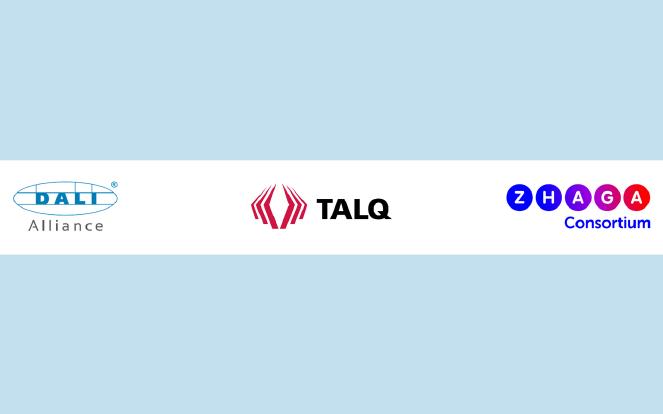
DALIfocusesondevelopingandmanaging digitallightingcontrolspecificationsbasedon theIEC62386standard,enablingthewidely recognizedDALI-2,D4i,andDALI+ certificationprograms.Theircommitmentto interoperabilityandcertificationensuresthat lightingcomponentsandsystemscan seamlesslyintegrateandcommunicate.
TALQhasdevelopedandintroduceda globallyacceptedstandardforoutdoor lightingsystemsusingastandardized interfaceprotocolforheterogenousoutdoor devicenetworks.Thestandardhasalsomore recentlybeenwidenedtoincludeothersmart cityapplications,likewastemanagement, smarttraffic,parkingandenvironmental sensing.TheTALQSmartCityProtocol enablesconsistentdatatobeusedwithin smartcitydevicenetworksandwiththe centralmanagementsystemsofcitiesand communities.
Zhaga,well-knownforitsworkincreating interfacespecificationsforLEDlightengines andsensorandcommunicationmodules, ensurescompatibilityacrossdifferent manufacturers.ByenablinginteroperableLED componentsandtheircertification,Zhagahas helpedtofosterinnovationandflexibilitywithin theLEDlightingindustry.
Thecollaborationbetweenthesethree organizationsaimstostreamlinetheexchange ofdatafurther,offeringaunifiedapproachfor end-to-endcommunicationandcontrolin smartstreetlightingapplications.Thejoint workwillincludeasharedapproachto achievingaunifieddatastreamsolutionand exchangingvisionsontherequirementsand architectureneededforsuchsystems.This liaisonwillenabletherespectivespecifications ofDALI,TALQandZhagatoreflectthedata andcontrolrequirementsofoutdoorlighting controlsystems.
”TheD4icertificationprogramplaysacrucial roleinenablingtheseamlessintegrationof streetlightsintosmartcityapplications, enablinginteroperabilityandsustainability, whilegatheringcriticaldataforasset management,diagnosticsandenergy monitoring,”saysPaulDrosihn,General ManageroftheDALIAlliance.”Byworking closelywithZhagaandTALQ,we’refostering afuture-proofecosystemthatenhances supplychainlongevity,security,andtheright torepair–buildingresilientinfrastructurethat supportssmartcitiesforthelongterm.”
“Forus,itisalogicalsteptoworktogether withDALIandZhaga.Notonlydoweshare thesamegoals,butthecompositionofthe membercompaniesalsohasalargeoverlap. Thebetterthestandardsinthestreetlighting environmentbecome,themoresustainable andfuture-prooftheinvestmentdecisionsof citiesandoperatorswillbe,”explainsSimon Dunkley,SecretaryGeneraloftheTALQ Consortium.
“Wearethrilledtotakethisstepforward togetherwithDALIandTALQ.Bycombining oureffortsandexpertise,weareworking towardsamoreinterconnectedandefficient futureforsmartlighting.Thispartnership ensuresthatweareallmovinginthesame direction,unitingourambitionsandpromoting real-worldinteroperability,”saidHeinrichThye, SecretaryGeneralofZhaga.
Thisliaisonsignalsasignificantmovetowards aligningglobalstandardsinsmartoutdoor lighting.Bycreatinginteroperablesolutions, thecollaborationaimstoreducecomplexity formanufacturersandcitiesalike,ultimately fosteringamoresustainableandefficient urbanfuture.
AbouttheDALIAlliance
TheDALIAlliance(alsoknownastheDigital IlluminationInterfaceAllianceorDiiA)isan open,globalconsortiumoflightingcompanies thatdrivesthegrowthoflightingcontrol solutionsbasedoninternationally standardizedDigitalAddressableLighting Interface(DALI)technology.Theorganization operatestheDALI-2,D4i,andDALI+ certificationprogramstoboosttheuseof open,interoperablelightingcontrolsystems. Formoreinformationvisit www.dali-alliance.org.
AbouttheTALQConsortium
Foundedin2012,theTALQConsortiumhas establishedagloballyacceptedstandardfor managementsoftwareinterfacestocontrol andmonitorheterogeneoussmartcity applications.TheTALQSmartCityProtocolis aspecificationforinformationexchange, suitableforimplementationinvarious productsandsystems.Thisway interoperabilitybetweenCentralManagement Software(CMS)andOutdoorDevice Networks(ODN)fromdifferentvendorsis enabled,suchthatasingleCMScancontrol differentODNsindifferentpartsofacityor region.TALQisanopenindustryconsortium currentlyconsistingofmorethan60member companies.Formoreinformationvisit www.talq-consortium.org.
AbouttheZhagaConsortium
Zhagaisaglobalassociationoflighting industrymembers.Zhagastandardizes interfacespecificationsforLEDluminaire components,includingLEDlightengines,LED modules,LEDarrays,holders,electronic controlgear(LEDdrivers),connectors,sensor and/orwirelesscommunicationmodulesand associateddevices.TheZhagainterface standardsenablemulti-vendorecosystemof interoperableproducts.Tocreatetrustinthe interoperabilityofproductsfrommultiple vendorsZhagahasacertificationand logo-programexecutedbythirdpartytest houses.Throughitsfocusoninteroperability, Zhagacontributestocircularitylightingvia smart,connectedlightingandserviceable luminaires,supportingtheUNSustainable DevelopmentGoal11forsustainablecities
andcommunities.Zhagahassetupapartner andliaisonprogram,workingwithrecognized StandardsDevelopmentOrganizationsand Alliancestomaximizesynergies,leverage externalexpertiseandglobalacceptance.For moreinformation,visit www.zhagastandard.org. ■
NEMAandIESAnnounceNew PartnershiptoEnhance LightingIndustryStandards www.nema.org
TheNationalElectricalManufacturers Association(NEMA)andtheIlluminating EngineeringSociety(IES)—recognizedleaders indevelopmentoflightingindustry standards—announcedanewpartnershipto fosterinnovation,collaborationand consistencyinlightingtechnicalstandards.

Thenewpartnershipwillenhancestandards forlightingsystemperformance,quality, safety,andsustainability.Specifically,the MOUidentifieskeyareasofcooperation, includingthesharingofsubjectmatterexperts andmutualparticipationinstandards developmentcommittees.Thiscollaborative effortwillstreamlinethestandards developmentprocess,ensuring comprehensiveinputfrombothorganizations.
“NEMAispleasedtobeworkingwithIESto settechnicalstandardsthatensure consumerscontinuetobenefitfromsafeand sustainablelightingsystems,”saidDebra Phillips,NEMAPresidentandCEO.“Asa StandardsDevelopmentOrganizationwitha 100-yearlegacyinelectricalstandards,NEMA isproudtoembarkonthisjourneywithIESto builduponthelightingindustry’stechnical foundationatatimeofrapidtechnological advancementsandincreasingdemandfor energyefficientandconnectedsolutions.”
“OurpartnershipwithNEMAunderscoresour sharedcommitmenttodevelopingstandards thatarereflectiveoftheprogressinthe lightingindustry,”saidColleenHarper,CEO andExecutiveDirectoroftheIlluminating EngineeringSociety.“Thiscollaborationis indicativeofacontinualeffortfortheimpactof IEStobeshapedbyinsightsfrompartners throughreciprocity.”
AboutIESEstablishedin1906,the
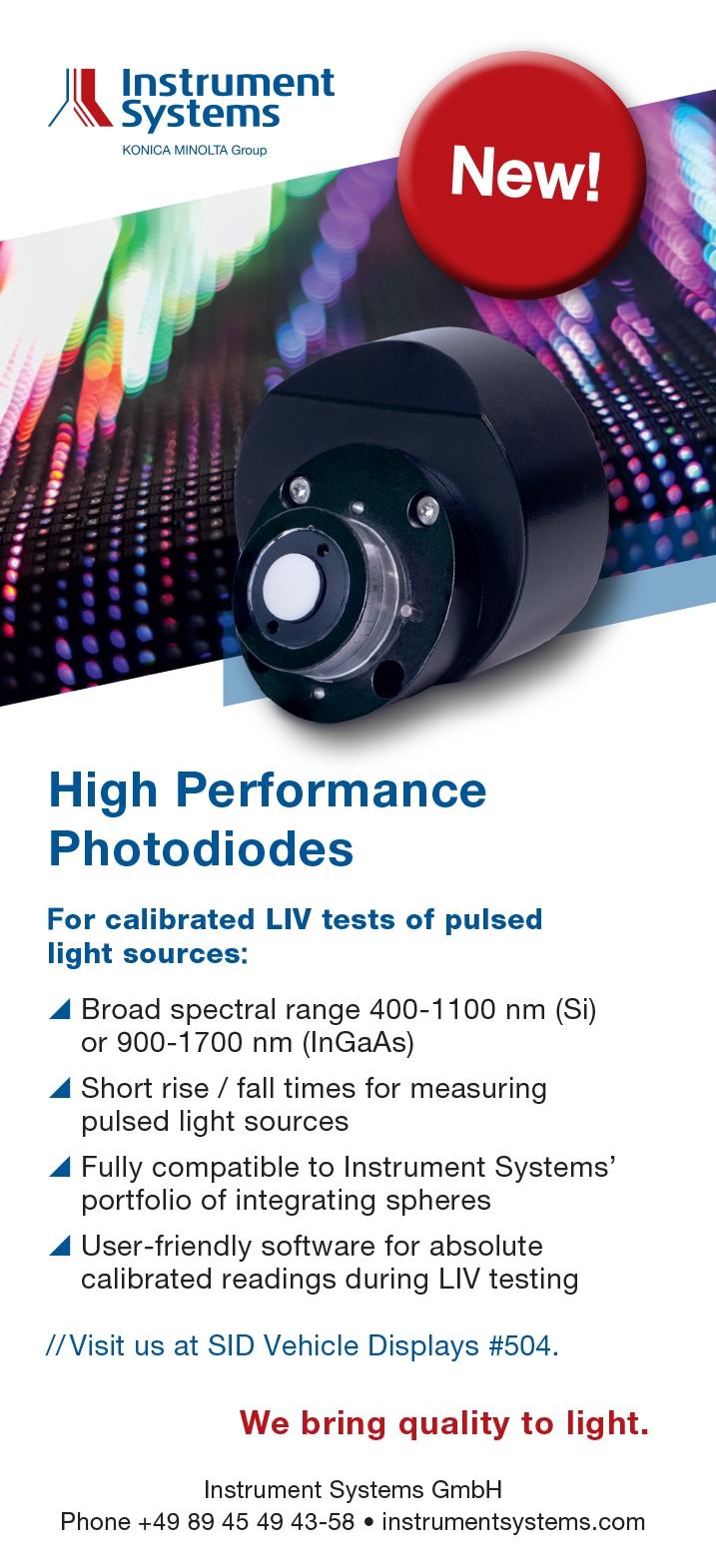
IlluminatingEngineeringSocietyisthe recognizedtechnicalandeducational authorityonillumination.Ourmissionisto improvethelightedenvironmentbybringing togetherthosewithlightingknowledgeandby translatingthatknowledgeintoactionsthat benefitthepublic.Weprovideavarietyof professionaldevelopment,publications, networkingandeducationalopportunitiesto ourmembershipofengineers,architects, designers,educators,students,contractors, distributors,utilitypersonnel,manufacturers andscientistsinnearly60countries.Through ourAmericanNationalStandardsInstitute (ANSI)accreditedprocess,wepublishand maintaintheLightingLibrary®,withover100 standardswrittenbysubjectmatterexpertsin ourtechnicalcommittees.Inallourefforts,we strivetoimprovelifethroughqualityoflight.To learnmoreaboutus,visitwww.ies.org.
AboutNEMATheNationalElectrical ManufacturersAssociation(NEMA)represents over300electricalequipmentandmedical imagingmanufacturersthatmakesafe, reliable,andefficientproductsandsystems. Together,ourmemberscontribute1%ofU.S. GDPanddirectlyprovidenearly460,000 Americanjobs,contributingmorethan$250 billiontotheU.S.economy.Learnmoreat www.nema.org ■
PartnertoAdvanceSmart
LightingandBuilding SolutionsandDirectCurrent (DC)IndustryApplications
www.abb.com
ThecompanieswillfocusonintegratingABB’s buildingautomationsolutionswithZumtobel Group’slightingmanagementsystemsABB andZumtobelGroupwillalsotarget innovationintheuseofdirectcurrent(DC) technologyinfull-scaleindustrialapplications toreduceenergyuseandlowerCO2 emissions.Thestrategicpartnershipwill supportmoreefficient,sustainableand user-friendlycommercial,industrialand institutionalbuildings.

GlobaltechnologyleaderABBand Austrian-basedZumtobelGroup,aglobal leaderinprofessionallightingsolutions announcetheirstrategicpartnershipaimedat advancingsmartbuildingsolutionsanddirect current(DC)industrialproductapplications. Thecollaborationissettocreatesignificant addedvalueforcustomersincommercial, industrial,andinstitutionalsectorsbyoffering integrated,smartsolutionsforsustainable buildings.
Thecollaborationwillleverageboth companies’expertiseinlighting,building automation,andelectrification.Itwillfocuson integratingZumtobelGroup’sadvanced lightingmanagementsystemswithABB’s comprehensivebuildingautomationsolutions. Thecombinedexpertiseisexpectedtocreate moreefficient,sustainable,anduser-friendly smartbuildingenvironments.Thetwo companieswillhelptoacceleratetheadoption ofsensor-basedlightingsolutionsthatenable businessestooptimizeenergyefficiency, increaseoccupantcomfortandmaximizethe effectivenessofheating,ventilationandair conditioning(HVAC)control.
Bothcompaniesaimtodriveinnovations basedonthelatestdevelopmentsinusingDC technologyinfull-scaleindustrialapplications. TheuseofDCtechnologyisintendedto supportaresource-savingsocietyby deliveringseveralbenefitsforamodern industrialpowergrid:efficientintegrationof renewableenergy,lowerresource
consumption,reducedfeed-inpower,stable gridsandanopensystemforusers.Both companiesareactivemembersoftheOpen DirectCurrentAlliance(ODCA),aWorking PartyofZVEIe.V.
”Ourpartnershipapproachenablesusto betteraddressinnovation,standardization, andsustainabilityandcontinuetopioneernew technologies,”saidLucyHan,ExecutiveVice PresidentforBuildingandHomeAutomation SolutionsatABB.“Standardization,through KNX,MatterandThreadisparticularly importantinassuringeaseofusefor customers,becausealongsidetherapid growthofthesector,wemustdrivesimplicity. Technologiesincommercialbuildingsneedto talktoeachotherandbycombiningour strengthswithpartnersliketheZumtobel Group,wecanoffercustomersmore comprehensiveandinnovativesolutionsfor smartbuildingsandindustrialapplications.”
Keyaspectsofthepartnershipincludethe jointdevelopmentofintegratedsmartbuilding solutions,especiallyaroundZumtobel’s LITECOMlightingsystemandcontinuous-row TECTONDCluminaireandABB’sDC protectiondevicesaswellasitsABBi-bus® KNXandABBi-bus®DALIsystems.
OliverVogler,SVPCorporateStrategyand M&AoftheZumtobelGroup,underlines, “CollaboratingwithABBallowsustoexpand ourbuildingmanagementofferingaround sensor-basedlighting,especiallyinDALIand KNXapplications.Together,wecandrive innovationintherapidlyevolvingfieldsof smartbuildingsandsmartenergysolutions.”
Thecompanieswillalsoexploreadditional cooperationopportunitiesinprefabricated buildingsolutionsandemergingtechnology standardssuchasthecross-manufacturer connectionstandardMatterandthenetwork protocolThread.
ABBisatechnologyleaderinelectrification andautomation,enablingamoresustainable andresource-efficientfuture.Thecompany’s solutionsconnectengineeringknow-howand softwaretooptimizehowthingsare manufactured,moved,powered,and operated.Buildingonover140yearsof excellence,ABB’smorethan105,000 employeesarecommittedtodriving innovationsthataccelerateindustrial transformation.www.abb.com
AboutABBElectrification:ABBElectrification isaglobaltechnologyleadermakingefficient andreliableuseofelectricityfromsourceto socketpossible.Withmorethan50,000 employeesacross100countries,we collaboratewithourcustomersandpartners tosolvetheworld’sgreatestchallengesin electricaldistributionandenergy management.Wehelpbusinesses,industry, andconsumersruntheirfacilitiesandhomes efficientlyandreliably.Astheenergytransition
accelerates,weareelectrifyingtheworldina safe,smart,andsustainableway. go.abb/electrification
AboutZumtobelGroup:ZumtobelGroupisan internationallightinggroupandaleading supplierofinnovativelightingsolutions, lightingcomponentsandassociatedservices. TheZumtobelGroup’sserviceofferingisone ofthemostcomprehensiveintheentire lightingindustry,includingconsultationon smartlightingcontrolsandemergencylighting systems,lightcontracting,designservices andprojectmanagementofturnkeylighting solutions,aswellasnew,data-basedservices focusedondeliveringconnectivityfor buildingsandmunicipalitiesviathelighting infrastructure.TheZumtobelGroupisbased inDornbirnintheVorarlbergregionofAustria andislistedontheViennaStockExchange (ATXPrime).Furtherinformationisavailableat z.lighting/group. ■
www.lumileds.com
Lumileds’LUXEON5050LEDportfoliohas expandedwithover185optionsacrossfour productfamilies,meetingthegrowing demandforconservation,darksky compliance,andsolarlighting.
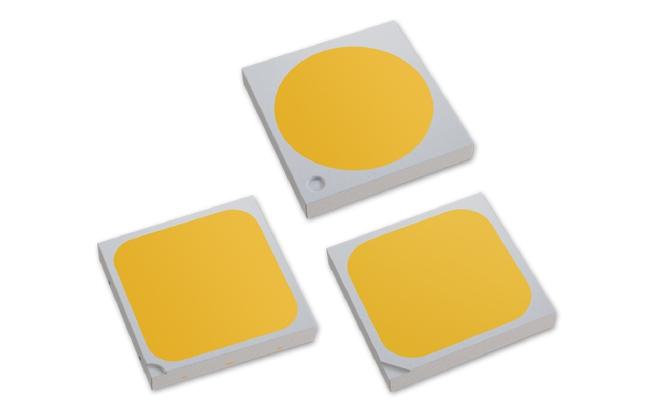
NewadditionsliketheLUXEON5050HEPlus enablelowerenergyusage,sustainability,and CO2reductionsforhigh-volumeapplications suchasstreetlightingandinfrastructure.
Therehasbeenarapidsophisticationof industrialandoutdoorlightinginthe8-years sincetheLUXEON5050RoundLEDwasfirst introduced.Customerdemandfortailored solutionsthataddresscommunityandcountry levelrequirementshavedrivensignificant expansionofLumileds’5050portfolioand todaytherearemorethan185standardLEDs across4LUXEON5050productfamilieswith 3voltageoptions:6V,24V,&30V;10CCT choicesfrom1800Kto6500K;3CRIchoices of70,80,or90.Mostrecently,darksky initiativesandoutdoorlightingordinances inspireddevelopmentofNightScape Technology–with<2%bluecontent–which isalsoavailableintheLUXEON5050portfolio.
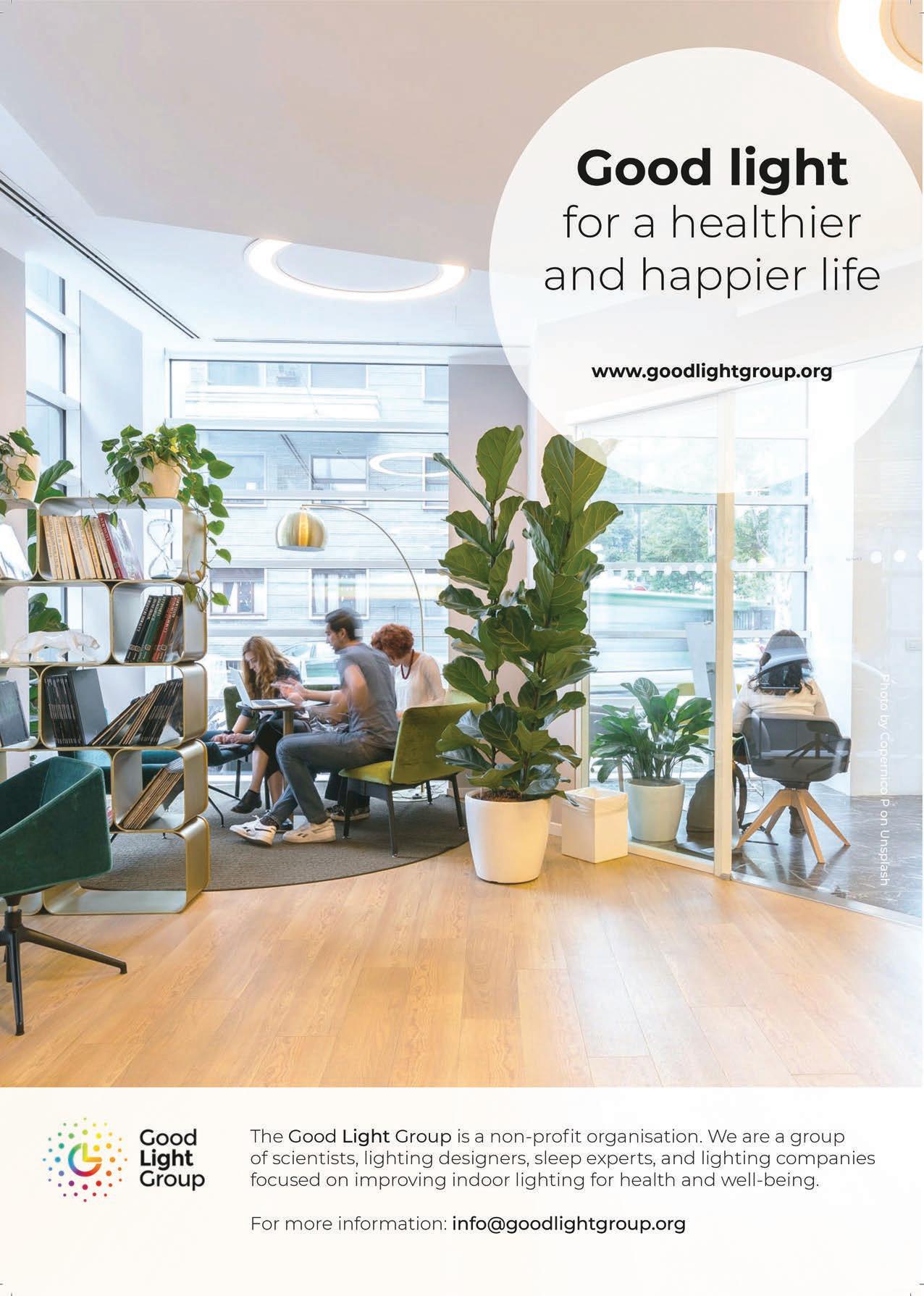
LUXEON5050HEPlus,themostrecent addition,reducesapplicationpower consumptionby18%ormoreincritical infrastructureapplicationscommontocities andbusinessesaroundtheworld.Forhigh volumeapplicationssuchasstreetlighting,the cumulativeimpactofLUXEON5050HEPlus islowerenergyusage,costs,andareduction inannualCO2emissions.Further,the lower-energyconsumptionsupportsthe transitiontolow-carbonorno-carbon electricitysupplyandOEMscanachieve greatersustainabilityintheirmanufacturing processbyreducingthephysicalmaterialin boththeheatsinkandthesystem’sdriver.
LUXEON5050Roundwiththefamiliarround lightemittingsurfaceisoriginalandmostoften deployedsolution.Itscombinationofoutput, efficacy,andlumens/$makeittheglobal leaderinthe5050LEDspace.It’ssupported withanextensiveselectionofopticsand complementarycomponentsthathave developedoverthelast8years.Infact,optical solutionproviderLEDiLlistsmorethan200 lensandreflectorchoicestoaddressawide varietyofapplicationsanddesignparameters.
LUXEON5050Squareofferstheportfolio’s highestlightoutputlevelswhilestilldelivering efficacygreaterthan170lumens/Watt.But perhapsthegreatestadvancesbroughttothe portfoliowastheoutstandingcorrosion resistanceintroducedwiththesepartsand sinceappliedtoallLUXEON5050parts.The EpoxyMoldingCompound(EMCpackage offerscorrosionresistancecomparabletoa ceramicpackage.Itenablessignificantly lowerfluxdegradationandlesscolorshift whenusedinharshenvironments.
LUXEON5050HE,liketheotherLUXEON 5050parts,deliversacombinationofoutput, efficacy,lm/$,androbustnessthatsupports OEMeffortstoprovidearangeofoptionsfor anyoftheirluminairesandtooptimizevalue fortheircustomerswhereverpossible.
MostExtendedandComprehensiveLM80 Tests
PerhapsthemostimportantdataforLEDs usedincriticalapplicationswithexposureto theelementsisintheLM80reportand reliabilitydatasheetsthatLumiledsprovidesto customers.Whileall5050LEDmanufacturers shouldprovidebothdatasets,distinctand importantdifferencesbetweenLEDscanbe identifiedinthisdata.TheLUXEON5050 LM80reportcoversover17,000hoursof testing,andLumiledsprovidescustomers withacomprehensiveanddetailedanalysisof 16differenttestitemsincluding:High TemperatureOperatingLife,HydrogenSulfide Test(15ppmH2S,40C,RH80%),and TemperatureCycle.Lumiledsalsoreports detailedflux,forwardvoltage,andcolor maintenancedata.Lumileds’extensivetesting oftheLUXEON5050lineallowsitto
confidentlyclaimL70andL90above100,000 hours.
Noindustrialoroutdoorluminairesshouldbe designedwithoutconsideringthelongevity androbustnessoftheLEDsthemselves.In theseapplications,exposuretoeverything fromsulfur,smog,humidity,andheat,can affecttheentiresystem.Lumiledshas specificallyengineeredits5050LEDsto minimizerisksoffailureorpremature degradation.
Asglobalenergycostscontinuetoincrease, efficiencygainspayincreasingdividendsto end-usersandcommunitiesthatneedto lowermunicipalcosts,reduceenergy consumption,andsupportsustainabilitygoals. Alltheseobjectivescannowbeachieved whilealsoaddressingdarkskyinitiatives.
“Ascommunitiescontinuetodevelopoutdoor lightingguidelinesandasalternativeenergy modelscomeonline,Lumiledswillcontinueto developandevolvetheLUXEON5050lineso astoprovideOEMswiththeabilitytomeet andexceedtheincreasinglygranular requirementsputforwardbycustomers,”said MeiYi,DirectorofProductMarketingat Lumileds. ■
LumiledsDelivers199lm/W forOutdoorandIndustrial LightingwithNewLUXEON 5050HEPlusLEDs
www.lumileds.com
HigherLEDefficacydriveslowerenergycosts evenasratesincrease.
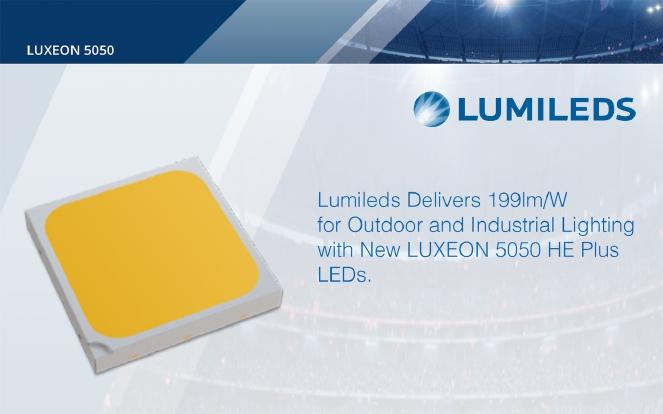
Efficiencyandenergysustainabilityarekey driversofLEDselectionforindustrialand outdoorlightingapplications.Withits introductionofLUXEON5050HEPlus, Lumiledscandeliver199lumensperWattand 746lumensofhigh-qualitylightoutputand reduceapplicationpowerconsumptionby 18%ormoreincriticalinfrastructure applicationscommontocitiesandbusinesses aroundtheworld.Further,thelowerenergy consumptionofLUXEON5050HEPlus supportsthetransitiontolow-carbonor no-carbonelectricitysupply.OEMscan
achievegreatersustainabilityintheir manufacturingprocessbyreducingthe physicalmaterialinboththeheatsinkandthe system’sdriver.
Asglobalenergycostscontinuetoincrease, efficiencygainspayincreasingdividendsto end-usersandcommunitiesthatneedto lowermunicipalcosts,reduceenergy consumption,andsupportsustainabilitygoals. Alltheseobjectivescannowbeachieved whilealsoaddressingdarkskyinitiatives.With CCToptionsaslowas1800Kand70or80 CRI,LUXEON5050HEPlusistheclear choiceforonandoffgridlightingsolutions.
“Efficiencyremainsthekeydriverforoutdoor andindustriallightingandthefocusofour continuousimprovementprograms,”saidMei Yi,DirectorofProductMarketingatLumileds. “TheefficacygainsachievedwithourLUXEON 5050HEPlusmakeitthehighest-performing 5050LEDavailabletodayandthesegains offerdramaticperformanceadvantagesfor on-gridlightingandsolar,off-grid,solutions.”
Inadditiontotheleadingefficacyandoutput combination,Lumiledshas:
• LoweredthermalresistancetoanRthof 1.1k/Wsothatsmaller,lesscostly heatsinkscanbeused
• Establishednarrowerfluxbinwidthsof 25lmtofacilitateaccuratesystemdesign
• Hot-colortargetedtheLEDsat85°C
• Advancedthemostrobustpackageto supportamaximumdrivecurrentof1.2A
LUXEON5050HEPlusjoinsanalready powerfulportfoliothatincludesLUXEON5050 Round,LUXEON5050Square,andLUXEON 5050HE.BoththeHEandHEPluspartshave asquarelightemittingsurface.The performanceadvancesavailableintheHE PlusversionsisalsoavailableinLumileds SunPlus5050LEDsforthehorticulture industrynow.
AllLUXEON5050LEDsareimmediately availablethroughLumiledsglobaldistribution network.
AboutLumileds LumiledsisagloballeaderinLEDand microLEDtechnology,innovation,and solutionsfortheautomotive,display, illumination,mobile,andothermarketswhere lightsourcesareessential.Ourapproximately 3,500employeesoperateinover15countries andpartnerwithourcustomerstodeliver neverbeforepossiblesolutionsforlighting, safety,andwell-being.
Tolearnmoreaboutourcompanyand solutionportfolios,pleasevisit lumileds.com. ■
www.cree-led.com
SettingthestandardsforVideoLEDs: WaterproofLEDs,Ultra-contrastLEDs,3-in-1 LensedRGBLEDs,andTiltedAngleLEDs.
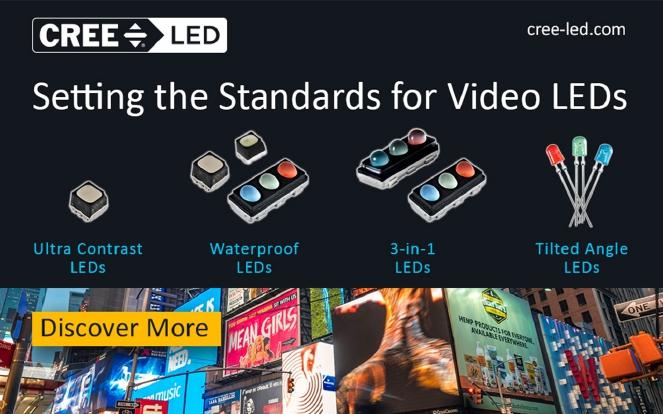
Fordecades,CreeLEDhasbeenatthe forefrontofvideoLEDtechnology,settingthe industrybenchmarkforlarge-formatdisplays, digitalsignageandvideoscreensusedin sportingevents,concertsandcommercial installations.
OurexpansiveproductportfolioandrobustIP assetsensureourcustomersbenefitfrom superiorcolorperformanceandunmatched reliability.Withafablessmanufacturingmodel, weofferunparalleledproductionflexibilityand asecure,stablesupplychaintomeetthe evolvingdemandsofanybusiness.
Buildingonalegacyofbreakthrough advancements,CreeLEDremainsdedicated topioneeringthefutureofvideoLED technology,keepingourcustomersaheadof thecompetition.
AboutCreeLED
CreeLEDoffersoneoftheindustry’sbroadest portfoliosofapplication-optimizedLEDchips andcomponents,leadingtheindustryin performanceandreliability.Ourteamdelivers best-in-classtechnologyandbreakthrough solutionsforfocusedapplicationsinhigh powerandmid-powergenerallighting, specialtylightingandvideoscreens.Cree LEDdevelopsproductsbackedbyexpert designassistance,superiorsalessupportand industry-bestglobalcustomerservice. cree-led.com ■
CasambiRollsOutthe SalvadorSeries2000
www.casambi.com
Globalleaderinwirelesssmartlightingcontrol, Casambi,ispleasedtoannouncethelaunch oftheSalvadorSeries2000,thenext generationinadvancedlightingcontrol systems.Buildingonthefoundationofthe popularSalvadorSeries1000,the2000 deliverscutting-edgefunctionalityand
versatility,allowingseamlessintegrationof wiredDALIdriversintoCasambi’swireless ecosystem.
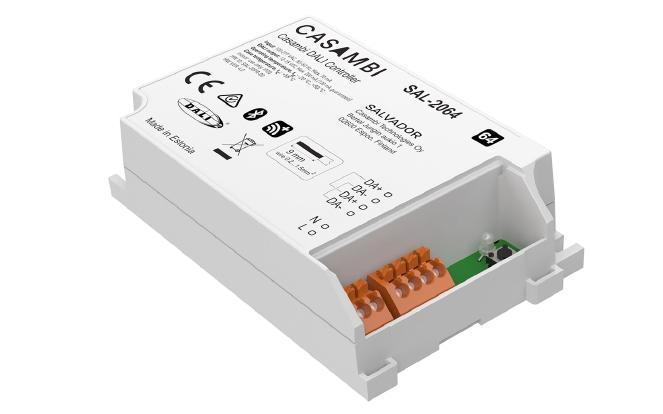
Designedtooptimizebothwiredandwireless lightingnetworks,theSalvadorSeries2000 bringsunparalleledflexibilitytoarangeof applications,fromheritagerefurbishmentsto modernofficeupgrades.Thisseriesenables DALIluminairestooperateasvirtualdevices withintheCasambinetwork,givingusersfull controlthroughtheintuitiveCasambiapp.
ShipmentsfortheSalvadorSeries2000will beginattheendofNovember2024,with ordersnowbeingaccepted.
“WiththeSalvadorSeries,wiredandwireless devicescanseamlesslyworktogether,”stated MarkMcClear,CEOofCasambi.“Ahybrid setupcouldinvolvecontrollingluminairesvia wiredDALIalongsidewirelessCasambi Ecosystemproductswithinthesamelighting controlsystem.Thisflexibilityensuresour all-encompassingsolutionremainsrelevant acrossawiderangeofapplications,giving usersthefreedomtoselecttheconfiguration thatbestsuitstheirneeds.Regardlessofthe environment,theCasambiexperience,known foritsrichfunctionalityanduser-friendliness, remainsconsistent.”
AboutCasambi
Casambiprovidessmartlightingcontrolvia intuitiveapplicationsthatsetnewstandardsin userinteractionwithlight.OurBluetooth® LowEnergy-basedtechnologyeasily integratesintofixturesanddevices,allowing manufacturerstocraftbespokeCasambi Readyproducts.Bridgingwirelessandwired DALIworlds,weguaranteeseamless interoperabilitybetweenallproductsandwith industrystandards.Userscanmixandmatch fortailoredlightingnetworks,ensuring adaptabilityacrosssettingswhileenjoyingthe richfunctionalityoftheCasambiexperience. Injustonedecade,Casambihasbecomea globalleaderwith300+ecosystempartners and5+milliondevicessoldinto200,000+ lightingprojectsworldwide.Anend-to-end solution,Casambiempowersindividualsand enterprisesaliketoilluminatespaceswith efficient,customizablecontrol.TheCasambi appisfreelyavailableforiOSandAndroid. Casambi.Whereideascometolight. ■
KUMUXPresentsits InnovativePlatformforthe OptimizationofDynamic LightingDesign kumux.io
KUMUXpresentsitslatestadvancement:the KUMUXPlatform.Thispowerfultoolenables designerstocombinelightingaesthetics, human-centeredprinciples,andcircadian sciencetocreateoptimizeddynamiclighting environments.
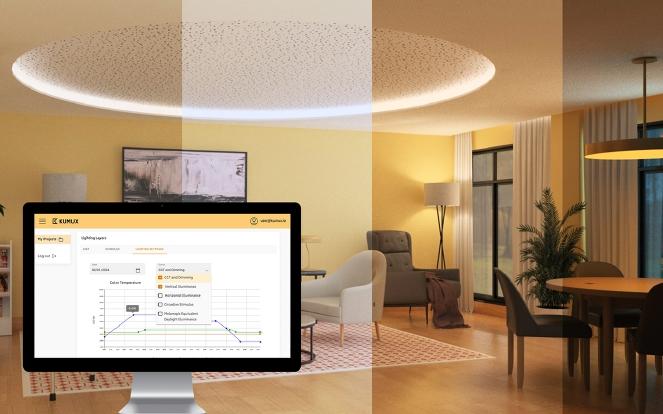
KUMUX,dedicatedtotransferringthebenefits ofnaturallighttoartificiallightsources,has developedarevolutionarytooldesignedto optimizedynamiclightingdesignby integratingthemostadvancedscientific researchontheimpactofnaturallighton humanhealth.Withthehelpofartificial intelligencealgorithmsappliedtolighting controlsystemsandLEDtechnology,KUMUX transformsindoorenvironmentstopromote people’swell-beingandqualityoflife.
KUMUXServicedeliversdynamiclighting optimizingsmartlightingsystemsthatsupport humanwell-being.Toempowerlighting designerswiththefullpotentialofthisservice, theteamhasdevelopedtheKUMUXPlatform, aconfigurationtoolthatsimplifiesthedesign andcommissioningofdynamiclightingwith thesefeatures:
• Optimizedlightingsettings:KUMUX PlatformusesAIalgorithmstoincorporate solardata,scienceandstandardsintothe dynamiclightingsettingstailoredtoa specificprojectlightingdesignwithany lightingfixture.
• Automationofoptimizedcurvesinany controlsystem:KUMUXsimplifiesthe commissioningprocessoftheoptimized dynamiclightingsettingswithmajorcontrol systems,automatinglightinglevelsand colortemperaturethroughouttheday.
KUMUXPlatform:ElevatingLightingDesign
KUMUXPlatformofferssubstantialbenefits thataddresscommonchallengesfacedby lightingdesigners.ThePlatformsimplifiesthe dynamiclightingdesignprocess,providing guidelines,non-visualparametercalculations andpresentationmaterialsthatsignificantly reducethetimerequiredforlightingdesign.
Someoftheincludedtoolsaddressthe quantificationofthewellnessbenefits associatedwithdynamiclighting,helping clientsevaluatereturnoninvestment(ROI) moreeffectively.
Offeringunparalleledcustomizationand adaptability,KUMUXPlatformensuresthat eachlightingsolutionistailoredtothespecific requirementsofeachproject,consideringthe application,luminairesspectrum,lighting layout,orstandardsandregulationstocomply with.
Inaddition,thecontrolarchitectureofKUMUX Platform,streamlinestheconfigurationof dynamiclightingindependentlyofthecontrol systemused,minimizingrisksduring constructionanddelivery.Withdatasecurely storedinthecloud,itallowsremoteupdates ofthelightingsettingswithoutaffectingthe existingcontrolconfiguration.
NewFeaturestoElevateLightingDesign
KUMUXPlatformexcelsinofferingprecise solutions.Itdevelopsspecificlighting configurationsalignedwithscientific parameters,facilitatingautomationofthe controlsystemandmaximizingtheimpactof lightingonusers’well-being.TheKUMUX Platformoffersadvancedtoolsforlighting design,including:
• Customsettingsforeachproject:Optimize thespectrumofeachluminairetoadaptto theprojectobjectivesusingAIalgorithms.It canupgradeexistingsmartlightingprojects wheredimmableortunablewhitefixtures areused,providingtailoredsolutionsthat maximizeeffectivenessandperformancein eachproject.
• Integrationwithexistingtechnology:Its commissioningsystemensuresthesmooth implementationofdynamiclightingdesigns withalllightingmanufacturersandmain controlsystemssuchasLutron,Casambi, Pharos,Summa,KNXandInventronics (OSRAM),
• Efficientdesigntools:Itprovidesa completeguideanddocumentationon dynamiclightingforwell-beingand performancethatfacilitatestheprocess fromconceptualizationtocommissioning, ensuringthatthelightingdeliveredcomplies withtheinitialdesign.
• Dynamiclightingeducationresources: Providesresourcestoeducatecustomers aboutthebenefitsofdynamiclighting, helpingthemmakeinformeddecisions.
KUMUXispositionedattheforefrontof innovationinthelightingindustry,withavalue propositionthatexpandstoencompassa holisticapproach.KUMUXisatransformative solutionthatreshapestheindustrylandscape withacontinuedcommitmenttoimproving people’swell-beingandthesustainabilityof indoorspaces. ■
www.olfer.com
ThenewCBU-DA-1PisaCasambidevice developedbyElectrónicaOlferthathasan integratedDALIBusPowerSupplywith 100mAguaranteedcurrent,whichmeansthat itcancontrolupto50DALILEDdrivers.
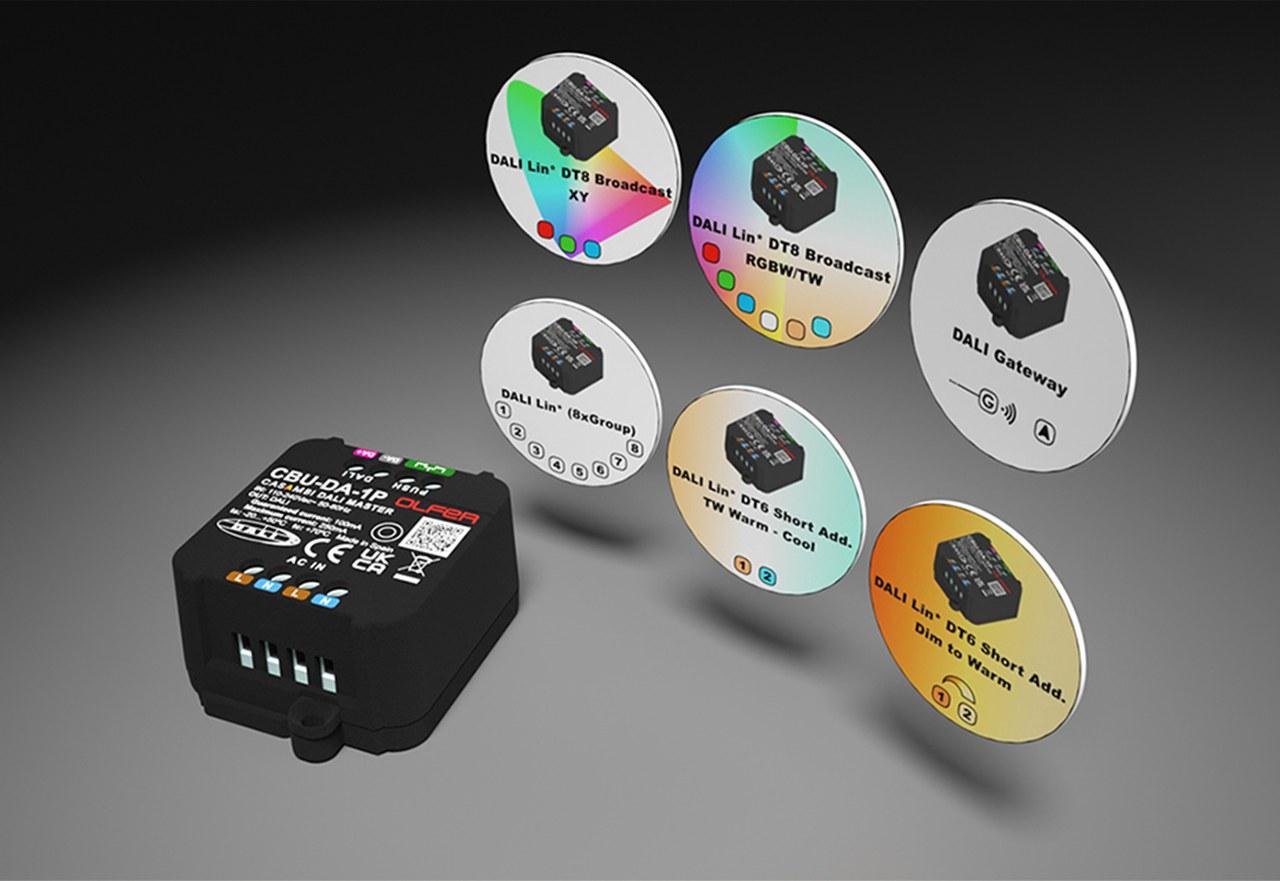
Withthisproduct,itispossibletocreateupto 8DALIGroupswithoutexternaltoolsand controltheluminairesupto8zones independently.TheCBU-DA-1Phasapush buttoninputforcontrollingCasambidevices andduplicatedmainsterminals(ACloop)for easyintegrationintolightingfixtureswhich facilitatesitsincorporationintoanyluminaire.
Inthisarticle,wearegoingtofocusononeof themostimportantaspectsoftheproduct andwhatmakesitoneofthemostversatile devices:morethan85differentCasambi fixtureprofilesavailablethatofferusawide varietyofcontrolmodestobeabletousethis deviceinanysituation.
Inordertochoosethedesiredprofile,wewill needtoconnecttheCBU-DA-1Punlinked andopentheCasambiApp,tapon“More-> Nearbydevices->Taponthedeviceicon-> ChangeProfile”.Below,wewillexplainthe controlmodesofsomeofthemostnotable profilesthatareavailableforthisproduct.
CBU-DA-1PPROFILES(excerpt)
• “DALIBroadcast”Simultaneouscontrolof allconnectedDALIdrivers.
• “DALIBroadcast+External”Simultaneous controlofallconnectedDALIdrivers.In addition,theyallowtheconnectionof DALI-2brightness/presencesensorsas wellasDALI-2push-buttonmodulesso thattheyappearintheappasiftheywere Casambisensorsorpush-buttons(uptoa maximumof8push-buttons).
• “DALI1xDIMSA”…“DALI8xDIMSA” Independentcontrolofupto8connected DALIdrivers.DALIaddressingisdone automaticallyandtheapp’suserinterface willdisplaythesamenumberofslidersas driverstheselectedprofileiscapableof controlling(1-8drivers).
• “DALI(1xGroup)”…“DALI(8xGroup)”Zone
controlofupto50connecteddrivers dividedintoupto8DALIgroups.Drivers canbeassignedtoDALIgroupsdirectly fromtheCasambiappwithouttheneedto useanyDALIprogrammerorexternaltool. Theapp’suserinterfacewilldisplaythe samenumberofslidersasDALIgroupsthe selectedprofilecancontrol(1-8groups).
• “DALIDT6TW”ConnecttwodifferentDALI addresses(A0-warmandA1-cold)to controlthecolortemperatureindependently ofthepowerregulationoftheluminaire.
• “DALIDT6DimtoWarm”Connecttwo differentDALIaddresses(A0-warmand A1-cold)tocontrolthecolortemperature dependingonthepowerregulationofthe luminaire.Thelightwillbewarmeratlow dimminglevelswhileitwillbecoolerathigh levels.
• “DALIDT6RGB”Connectthreedifferent DALIaddresses(A0–red,A1–greenand A2–blue)toperformRGBcolorcontrol.
• “DALIDT6RGBW”Connectfourdifferent DALIaddresses(A0–red,A1–green,A2–blueandA3–white)toperformRGBW colorcontrol.Thewhitechannelhasa dedicatedsliderintheapp.
• “DALIDT6RGB/W”Connectfourdifferent DALIaddresses(A0–red,A1–green,A2–blueandA3–white)toperformRGBW colorcontrol.Asliderwillappearintheapp tocontroltheproportionbetweenthewhite channelandtheRGBmix.
Throughthefollowinglinkyoucanconsultthe completelistofprofiles,aswellastheuser interfaceintheappandtheconnection diagramsassociatedwitheachoftheprofiles: https://www.olfer.com/olfer-cbu-da-1p.html
Asyouhavebeenabletodiscoverthroughout thisarticle,theCBU-DA-1Pdevicecan providesolutionstoalargenumberofprojects sinceitallowsyoutocontrolupto50DALI driversandtheavailableCasambiprofiles encompassallthepossibilitiesthatwecan findwhenwetalkaboutDALIsystems (groups,shortaddresses,DT6,DT8,RGB, TW,DimtoWarm,RGBW,XY…).
Ontheotherhand,wecanalsoconnect DALI-2inputdevicessuchassensorsand push-buttonmodulestotransformtheminto Casambidevices.Inaddition,theOlfer Electronicsprofilesperformaninitial self-configurationofthistypeofdeviceto ensuretheircompatibilityinatransparentway totheuserandwithouttheneedforexpensive externaltoolstocarryouttheirDALI programming.
Withoutadoubt,thenewCBU-DA-1Pisa usefulandversatiletoolthatshouldbetaken intoaccountbyanyCasambisolutions integrator. ■
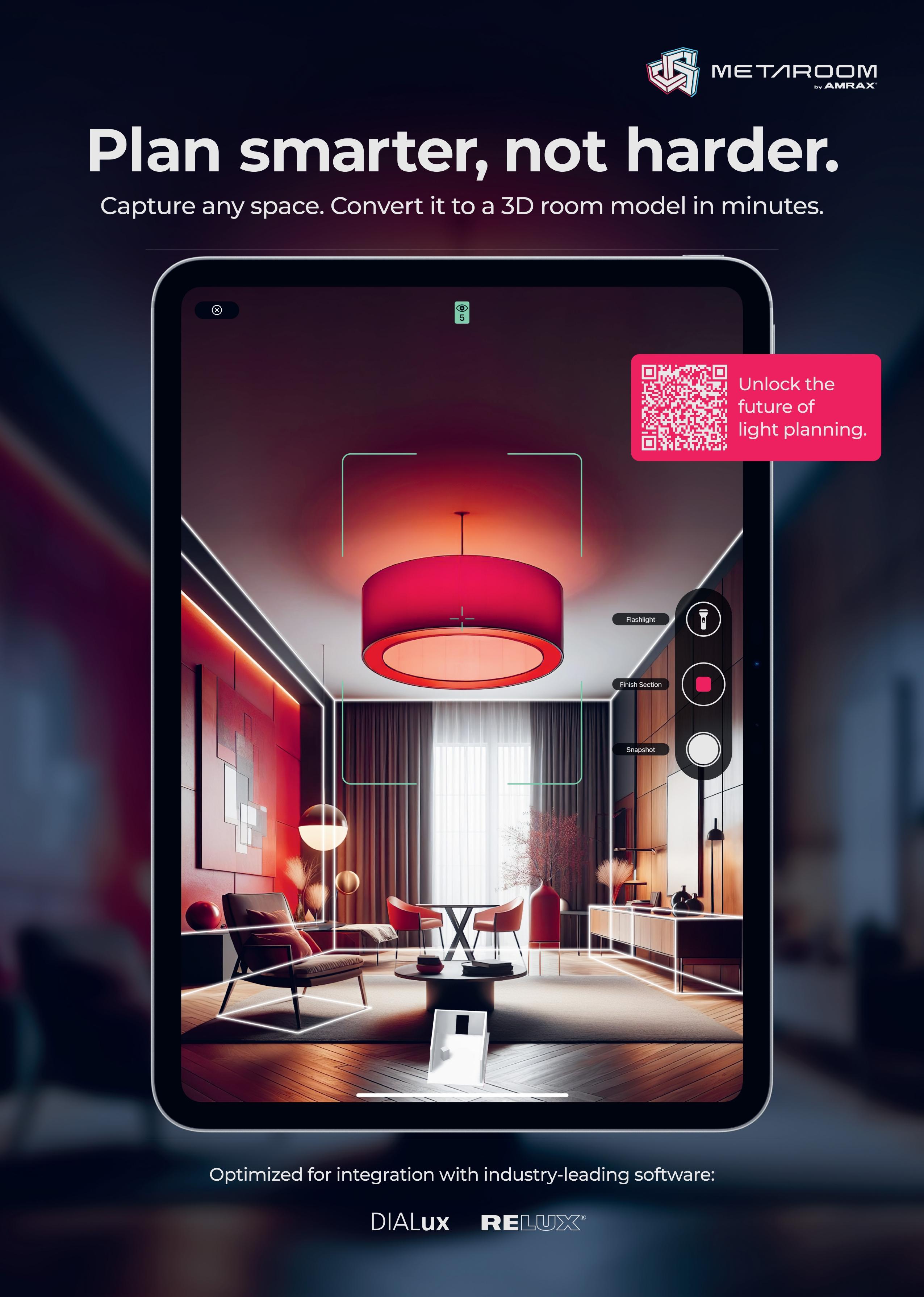

MarkMcClear:
“Weprovidethetechnologyplatformandservices tosupportourecosystempartnersasthey developandbringuniqueCasambiReady productstomarket.Over300partnershave developedandmarketedmorethan2,000Stock KeepingUnits(SKUs)fortheCasambiopen ecosystem,withnewproductsbeingintroduced everyday.”
Inthisexclusiveinterview,wespeakwiththeCEOofCasambi,who reflectsonhistransformativefirstyearleadingthecompany.Withover 20yearsofglobalexperienceintheLEDandSSLsectors,heshareshis visionforthefutureoflighting,wherewirelesscontrolsandintegrated technologiesarereshapingtheindustry.Thisconversationdelvesintothe challengesandmilestonesofhisfirstyearatthehelm,andhowCasambi isleadingthechargeininnovation,leveragingitsinternationalpresence andopen-ecosystemarchitecturetoredefinelightingsolutionsforthe nextgeneration.
Casambi.com
LEDprofessional: Weareverypleased toconductthisinterviewwithyouon theoccasionofyour“FirstYearAnniversaryasCasambiCEO.”Firstof all,wewouldbeinterestedinhearing aboutyourcareerjourneyandhow youultimatelyendedupastheCEO ofCasambi.
MarkMcClear: Absolutely,I’dbehappy tosharemyjourneywithyou.I’vebeen inthelightingindustryforwhatfeelslike forever,andIstillremembertheearly daysofLEDswhenmanyjustcouldn’t seethepotential.Itwastough,butalso prettyexciting.Iseethetransitionto wirelesscontrolsinmuchthesameway.
IjoinedCasambiinFebruary2022as theGeneralManagerforNorthAmerica.Bythattime,Ihadalreadyspent 20yearsintheLEDandSSLsectors, workingacrossmorethan35countries inAsia,NorthandSouthAmerica,and Europe.I’vebeenluckytohaveworked withsomeamazingpeople,contributed tosomeoftheearlyLEDstandardssetting,andledsomeimportant,transformativeorganizationsinourindustry.
BecomingtheCEOofCasambiwas arealhonorforme.We’reatsucha pivotalmomentinthelightingworld. Rememberwhenlightingwasallabout stampedmetalandscrew-inlamps? Nowwe’vemovedtointegratedLEDs, andit’sclearthatsoonallluminaireswill haveembeddedBluetoothLowEnergy radiosandsensors.It’slikewatchingthe futureunfold.
Casambiisinafantasticspottolead thisshift.We’retheonlytrulyinterna-
tionallightingcontrolplatformoutthere, andouropenecosystemarchitecture isagame-changercomparedtolegacy proprietarysystems.Thisapproachis allaboutinnovationandgivingourpartnersandclientstheflexibilitytheyneed tocreatethenextbigthingfortheirmarkets.
So,hereIam,leadingCasambi.Aftera yearatthehelm,I’mextremelyexcited aboutwhat’snext.Wehaveatalented globalteam.We’velaunchedagamechangingnewproductfamilythisyear. It’sagreattimetobeinthisindustry,and I’mthrilledtobepartofit.
LEDprofessional: Casambiisagloballyleadingcompanyinthefieldof lightingcontrols,particularlyinwirelesscommunications.Whathasmade Casambisosuccessful?
MarkMcClear: Thankyou.
Casambiisdifferentintwoimportant ways.
First,thereistheCasambiopenecosystem.Weprovidethetechnologyplatform andservicestosupportourecosystempartnersastheydevelopandbring uniqueCasambiReadyproductstomarket.Over300partners—ontheirtime andontheirdime—havedevelopedand marketedmorethan2,000SKUsfor theCasambiopenecosystem,withnew productsbeingintroducedeveryday.
TheCasambiopenecosystemoffers ourclientsthebestsensors,switches, drivers,andcontrollersfromleading manufacturersaroundtheworld.Thisal-
lowsthemtoselectthecomponentsthat fittheirprojectperfectly–allCasambi Readyproductsworktogetherregardlessofbrandandweofferanextremely easywaytoCasambifythosethatare not.Iftheydon’tliketheform,fit,function,price,delivery,oranyotheraspect ofagivencomponent,therearealways alternativeswithintheCasambiecosystem.
TheopennatureofCasambiensures multiplesourcesformostsystemcomponents,whichnotonlykeepsthesupplychainrobustbutalsofostersinnovationandfasterdesigncycles.Additionally,itprovidestransparencyinpricing, governedbythemarketnotdictatedby proprietybrands.
Incontrast,aclosedecosystem,that istosay,avendor-specificproprietary environment,oftencomeswithlimited choicesandhigherriskofsupplychain disruptions.Casambi’sopenecosystemrepresentsatrulydifferentandinnovativebusinessmodel,whereclients benefitfromflexibility,innovation,and pricetransparency,andourecosystem partnershavetheopportunitytobuilda businesswithCasambi.
ThesecondkeytoCasambi’ssuccessis simplythatCasambiworks.Whilemany haveattemptedtodeveloptheirown wirelesslightingcontrolsystems,none havematchedthefeatures,flexibility, reliability,andintuitiveuserinterfaceof Casambi.Oursystemhasprovenits effectivenessacrosseverycontinentand majormarket,withmorethan200,000 projectsand6,000,000installednodes acrossmorethan150countries.
Wehaveaddressedmorequestionsand solvedmoreproblemsinwirelesscontrolthanmostcanimagine,andbuilt aglobalservice,training,andsupport organizationtoaddressquestionsand issuesastheyarise.Casambisystems areinstalledinawiderangeofapplications,fromwarehousesandofficesto retailspaces,residentialareas,hotels, andheritagelandmarks.Wesupport networksofallsizes,fromsmallinstallationswithjustafewnodestolarge, multi-buildingsystemswithover15,000 nodes.Casambiworkswellbothindoors andoutdoorswithrobustlong-rangecapabilities.Oursystemsarealsodeployed insecureenvironments,includinghospitalsandairportcontroltowers.
BluetoothLowEnergytechnologywas originallycreatedatNokia’sResearch Center,wherethepeoplewholater startedCasambiworked.Becauseof this,CasambiwasabletofullyunderstandanduseBLEfromtheverybeginning.Infact,theystarteddeveloping theirproductsbeforeanyBLEdevices wereevenavailableonthemarket.For over13years,Casambihasbeendedicatedtobeingthefoundationofsmart lighting,consistentlydeliveringthebest possibleuserexperience.ThiscommitmentiswhyCasambiissuccessful: Casambiworks.
LEDprofessional: Casambi’secosystemisvastduetothedifferentapproachyou’vechosen.Let’sdelvea bitdeeperintothebusinessandpartnermodel.Howexactlydoesitwork, andhowcanonebecomeapartnerof Casambi?
MarkMcClear: Asananalogy,IcanexplainthattheCasambiopenecosystem isliketheappstoreonyoursmartphone. IfAppleandAndroidhadcreatedtheir respectiveappstoresandthenprovided alltheappsthemselves,theappsavailablewouldhavebeenlimitedbythecapacitiesofthesecompaniestoimagine, develop,deliver,andsupporttheseproprietaryapps.Ifsomethingwentwrong with,oriftheywantedtoaddanewfeaturetooneoftheirapps,userswould havehadnoalternativebuttowaitfor themtofixorupdateit.Therewould alsohavebeenverylimitedcompetition, nopressuretoinnovate,andthismodel wouldhaveaffordedthesecompanies near-monopolyeconomicpowerand theabilitytoextractrevenuewherever, whenever,andhowevertheypleased.
Closedecosystem(a.k.a.“walledgarden”)lightingcontrolcompanies—particularly intheUS—aresimilartothis.Theyoffer alimitednumberofcomponentstosupporttheirsystemsandmaythreatento voidthewarrantyifyouuseacomponentfromasourceotherthantheirs. Theytightlycontrolandoftenbundle pricingtomakeitdifficultforclientsto understandwhattheyarebuyingand payingfor,andtheyfrequentlytieongoingserviceandmaintenancecontracts totheirsystemsales.Thesupplychain shortagesandleadtimesofover60 weeksonsomecomponentsfollowingthepandemichaveclearlyexposed anothervulnerabilityofthismodel.Fortunatelyforallofus,AppleandAndroid choseanopenecosystemfortheirapp stores.
Casambiisanopenecosystemaswell. Thebestsensormanufacturersinthe worldareCasambiecosystempartners,asaremanufacturersofdrivers, switches,andahostofothercritical networkcomponents.Withhundreds ofecosystempartnersandthousands ofSKUs,anythingaclientislooking forisprobablyalreadyavailableinthe Casambiopenecosystem.Ifaclient needssomethingunique,wecanrefer themtothebest,fastest,andmostcosteffectivepartnerwhocanquicklycreate theproducttheyneedfortheirproject. Andguesswhat?Thatinnovativenew productthenbecomesavailableandis partoftheCasambiopenecosystem.
BecomingaCasambipartneriseasy. SimplyintegrateasingleSoCchip(we canhelp)intoyourhardwareproduct. ThechipincludesCasambisoftware,ensuringcommunicationwithouruserinterface,alongwithfreeOTA(over-the-air) softwareupdates,and100%interoperability.OurteamatCasambiwillassess theradiofunctionalityofyourhardware foroptimalefficiency,andwewillpromoteyourproductonourwebsiteto helpboostsales.
Wehaveassisteddozensofourecosystempartnersworldwideinsellingwithin theirlocalmarketsandexpandinginto globalmarkets.Partneringwithour ecosystemisapriority(andoneofour corecompanyvalues).Wewantto helpourpartnersbuildhealthy,competitive,andprofitablebusinesses,and weremaincommittedtoprovidingthe resourcesneededtomakethisopen ecosystemvisionareality.
OurVARsandlocalsalespartnersare alsoessentialmembersofourecosystem,playingacrucialroleinpromoting andsellingCasambi-integratedlightingproductsforvariousprojects.They bid,buildrelationships,andoffertailored luminaires,oftenhandlinglocalmanufacturingorrepresentinginternational brands.OurCasambiIntegrationpartnersalsoenhancetheseofferingsby providingcustomerswithcomprehensive solutions,includingcommissioningservicesandfirst-tiersupport.ThiscrosscollaborationwithintheCasambiecosystemfurtherbroadensmarketreachfor all,boostspartnerrevenue,andensures competitiveadvantagewithadvanced Casambitechnology.
LEDprofessional: Casambirecently launchedagroundbreakingsystem extensioncalledSalvador,which bridgesthegapbetweenwireless andwiredsystems,withaparticular focusonDALIintegration.Whatdoes this360°ecosystemlooklike?
MarkMcClear: ThelaunchoftheSalvadorSeries1 thisyearisanextremely significantstepinCasambi’smissionto bethefoundationforsmartlighting.This newproductfamilybridgesthegapbetweenwirelessandwiredsystems,with aparticularfocusonDALIintegration.
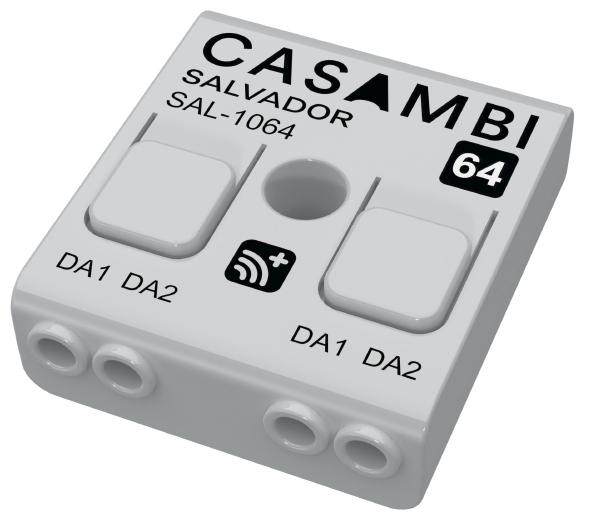
TheSalvadorSeries1000seamlesslyintegrates wiredDALIdriversintotheCasambisystem. Whenintegrated,DALIluminairesappearas virtualluminairesintheCasambinetwork.This productfamilyincludesthreemodels:SAL-1016, SAL-1032andSAL-1064.Formoreinformation: casambi.com/ecosystem/salvador
DALIisagreat,capable,andubiquitouslightingcontrolsprotocolandstandard(especiallyinEuropeandpartsof Asia).However,oneofthechallenges withDALIinstallationshasalwaysbeen thattheytypicallyrequirehighlyskilled personneltocommissionthesystems.
1SalvadorSeries https://casambi.com/news/casambi -is-now-taking-orders-for-salvador/
Anotherchallengeisthataddingasimpleswitchoradditionalsensorcanbe expensiveandlabor-intensive.WithSalvador,however,addinganothernetworkcomponentissimple.Salvador alsobringstheCasambiuserinterface toDALIlightinginstallations,sowired DALIsystemcomponentsappearin theCasambiappalongsidewireless Casambicomponents.Commissioning aDALIsystemisnowaseasyascommissioningasystemwiththefamously user-friendlyCasambiuserinterface.All ittakesisaddingatinywhitemodule— Salvador—toyourDALIsystem.
Oneofourgreatpartners[I’msurehe won’tmindmesharingthis],TomPybus, Sales&TechnicalManagerforHolders TechnologyAustralia,recentlyshared onsocialmediahisexperiencewiththe Salvadorsystem,highlightinghoweffortlesslyitreplacedadefunct,outdated DALIcontroller.Hisentireproject,from starttofinish,wascommissionedinhalf anhour.Naming,grouping,andbuilding ascenewerecompletedwithease,and thesystemrespondedreliablyfromupto 40metersaway.Forthosefamiliarwith thepainstakingprocessofsettingup hard-wiredDALIsystems,theSalvador Seriesisindeedagame-changer.
LEDprofessional: Casambi,thewirelesslightingcompany,nowalsoofferswiredsolutions.Thesimplicity ofwirelesscommissioninghasbeen impressive,socanyoutellushow thecommissioningprocessworks? Doesthissamesimplicityextendto Salvadorwithitswiredextension?
MarkMcClear: Whosaidwewerea wirelesscompany?OK,whileweareindeedknownforourwirelesssolutions, we’reactuallyauserexperiencecompanyfirstandforemost,withavisionto bethefoundationforsmartlighting.We happentothinkwirelessisthebestway toaccomplishthat,andtheultimatein costandsustainability,butSalvadorcan helpusbuildhybridandevenfullywired systemsthatarebeautiful,functional, andsavesignificantamountsofenergy. Salvadorisanothertoolinthetoolkitto becomethefoundationforsmartlighting.
AsImentionedearlier,onceyouhookup yourDALIsystemtoaSalvador,allthe DALIluminairesappearintheCasambi appasCasambiReadyluminaires, whichcanbeprogrammedintheapp

CasambiProisapowerfulplanningandcommissioningtooltailoredtotheuniqueneedsofambitious projects.It’saimedatinstallationswithautomatedcontrolsystemscomprisingschedules,sensors,and switches.CasambiProisn’tyourend-usercontrollerliketheCasambiAppis.CasambiProexcelsin particularlylargesitesthatfeaturerepetitivelayouts.ItempowersyoutocreateandconfigureCasambi installationswithgreaterefficiency,minimizingtheneedforextensiveon-sitetechnicalconfigurations.
toyourheart’sdelight.Thebeautyofthe Casambiappisitssimplicity—it’salmost impossibletomakeamistake.Youcan configure,reconfigure,addlast-minute components(normallyswitches,sensors)andadjustasmanytimesasyou needuntilyou’rehappywiththesetup— noneedforanyspecializedhardware, externalexpertise,orextensivesetup time.
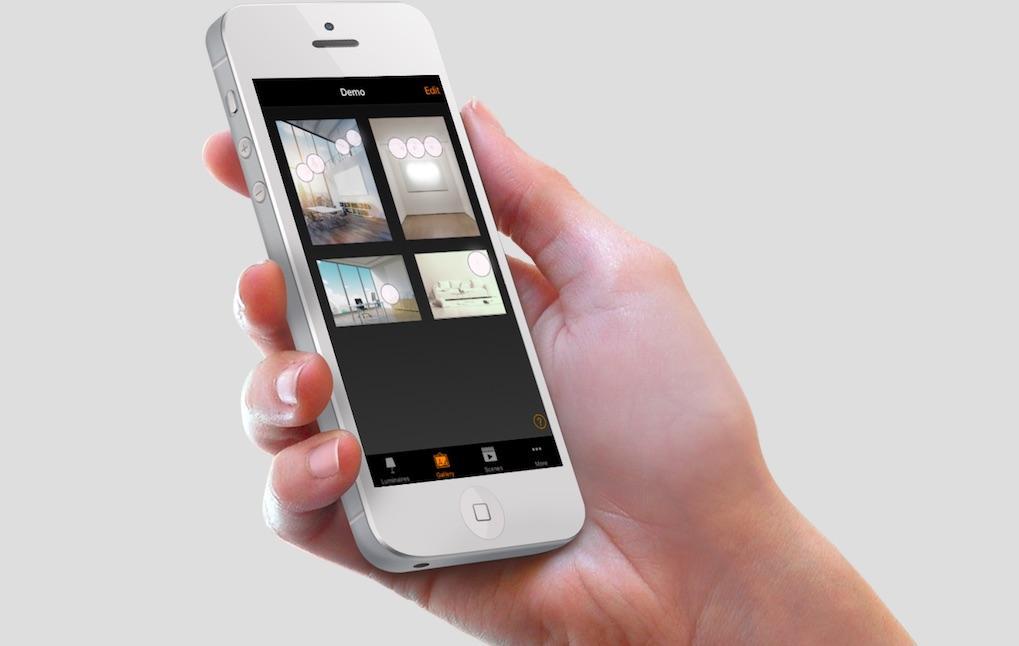
TheCasambiappworksasoneoftheuserinterfacesinaCasambilightingcontrolsolution,as thecommissioningtoolandaswellasaremote gateway.TheCasambiappworkswithiOSas wellasAndroiddevices,likesmartphonesand tablets.Theappisfreetodownloadbyany end-user.
LEDprofessional: Sustainabilityisa majorconcernintoday’sworld.How isCasambicontributingtoenergy efficiencyandenvironmentalsustainabilitythroughitsproducts?
MarkMcClear: Internally,Casambiis committedtosustainabilityineveryaspectofouroperations.Weadhereto strictsupplychainpractices,withaclear codeofconductandpoliciesonconflictmineralsandglobalhumanrights. WecomplywithallrelevantEUCouncil Directivescoveringeverythingfromefficiencyandsafetytotherestrictionof
hazardoussubstances.Buthonestly, thisistablestakesandjustpartofbeing agoodcorporatecitizen.
LpRreadersarewellawareoftheenergysavingpotentialofLEDlighting,which canreduceenergyusagebyatleast 50%.Smartlightingcontrolsofferan additional20-25%ontopofthat.RegulatorybodiesinNorthAmericahave recognizedthisandhavebegunmandatingLuminaireLevelLightingControl (LLLC)aswellasintegrationwithHVAC andBMSsystems.Themosteffective waytocomplywiththeseregulations willbethroughsmartlightingcontrols. Casambiwillplayakeyroleinthisefforttoreduceenergyconsumption,in turn,lesseningenvironmentalimpactand helpingtoconserveresources.
Similarly,theglobalphase-outoffluorescentlightingisleadingtothewidespread replacementofmanylightingfixtures. Astheseluminairesareupgraded,some maybepartoflegacysystemswithexistingDALIcontrollines,whileothers maylackanypreviouscontrolsystem. InsteadofupgradingoutdatedDALIsystemsorinstallingnewcopperwiring,a wirelesssolutionlikeCasambi,orahybridsystemusingSalvador,canbeused toachievesignificantenergysavings.
Finally,fornewconstruction,everywired lightingcontrolsystemrequirescopper wires.Ifyoutaketheaveragelengthsof copperwiringusedintypicalconstructionprojectsandaroughestimateofthe numberofnewbuildprojectsoccurring eachyear,we’retalkinganythingbetweenamillionand20millionkmofcop-
percontrollinewiresinstalledeachyear. Goingwirelesscansignificantlyreduce thelaborandtransportationinvolvedin installingthousandsofkilometersofcoppercables,aswellasdecreasetheneed forminingsubstantialamountsofcopperinthefirstinstance.Miningjustone tonofcoppergeneratesapproximately 4.7metrictonsofCO2,whichisabout 250timestheCO2 emittedbydriving 100km(approx.62miles)inyouraveragegasolinecar.Whileitmaynotbethe mosttalked-aboutsustainabilitystoryin thelightingindustry,it’scertainlyacompellingone!
LEDprofessional: CasambiisapioneerinBLEmeshtechnologyfor lightingcontrol.Whatarethenext majortechnologicaladvancements wecanexpectfromCasambi?How doyouenvisiontheroleofartificial intelligenceandmachinelearningin enhancingCasambi’slightingcontrol solutions?
MarkMcClear: Iwouldsaythatboth I,personally,andweatCasambihave beenearlyadoptersofAI,andweare alreadyusingitinmanyofourbusiness processes.Additionally,someofour customers,withthehelpofourecosystempartners,havepioneeredinnovative usecasessuchascountingpeople,inventory,andotherobjects,aswellas measuringenvironmentalparameters (temperature,humidity,CO,CO2,etc.) andspaceutilization.
Itturnsoutthatawell-litspacerequires luminairesatregularintervals,andasensorcanprovidereal-timedataonhow peopleareusingthespace.Agridof manysensorscangeneratedatathat canbeminedforactionableinformation.Thisalreadyexists,andIcanenvisionhowoneofourecosystempartners couldextendthiswithAItoincludepredictiveandbehavioralmodeling.Infact, takeCalumino.They’reusingAIwith theirthermalsensorstostudyhowpeoplemoveandbehavewithinspaces. Thiswillmakelightingandtemperature controlwaymoreefficientandwaymore tailored-respondingtothepresence andbehaviorsofpeopleinreal-time. However,thiskindofdataandanalysisfallsoutsideCasambi’svisionofbeingthefoundationforsmartlighting.To putitanotherway,referringbacktothe ecosystempoint,Ithinkthisisafascinatingusecase,andIfullyexpectour ecosystempartnerstopioneerit.We
willcheerthemon,butpursuingthis ourselvescoulddiluteourvisionandresources,andCasambiisunlikelytotake itondirectly.
LEDprofessional: CasambihasasignificantpresenceinEurope.Youalso openedaregionalheadquartersin Singaporein2022andintheUSfive yearsago.HowdoesCasambitailor itsproductsandstrategiestomeet thespecificneedsofdifferentregionalmarkets?
MarkMcClear: Thiswasamajorchallengeandlearningcurveforus.Imay gettogetherwithmycolleaguesinFinland,Asia,andtheUSandwriteabook onthissomeday!Thelightingmarkets ineachoftheseregionshavedramaticallydifferentdriversandstructures.The players,regulationsandworkingcultures arealsocompletelydifferent.Andnobodycaresthat,“Thisisthewaywedo itinLondon,soofcourseitmustworkin Lahore(orLosAngeles)”or,conversely, “WejustdidthisinAtlanta,weshouldtry thisinAmsterdam(orAuckland)”.
Iwouldsaythekeytooursuccessin thesenewgeographieshasbeenour openness—bothintermsofhowweorganizeandcompensatepeople,respect localcustomsandholidays,andensure compliancewithlocalelectricalstandards.
Ontheonehand,wehavebuiltcompletelyindependentecosystemsinthe threemarkets,tailoredtolocalneeds andcodes.Ontheotherhand,weremainunwaveringinourpartneringethos describedaboveand,unexpectedly, havebecomeexpertsinthegloballightingmarket—abyproductratherthan aninitialgoal.Afteralotoflearningand adaptation,theNorthAmericanmarket, inparticular,hasbecomeastrongfit forCasambi,andNorthAmericacould eventuallybecomeourlargestregion.
Similarly,weareverybullishaboutthe potentialinAustralia,India,Singapore, andtheChineseexportmarket,allof whichareexcellentfitsforCasambi.We continuetoseedouble-digitgrowthin EuropeandareoptimisticthatSalvador canmotivatethewiredsegmentofthat markettoexploreCasambi.Webelieve thatonceelectricians,specifiers,and othersexperiencetheeaseofcommissioningSalvadorprovides,theymaybe moreinclinedtotryfullwirelesssolutions
onfutureprojects.Salvadorisexpected togainsignificanttractioninAsiaforthe samereasons.However,somewhat unexpectedly,wearealsoseeingvery stronginterestinSalvadorfromNorth America,promptingustoacceleratethe developmentofspecificformfactorsand voltagestailoredtothatmarket.
Thecommonthreadthroughoutallof thisislistening,learning,beingopenminded,andadapting.
LEDprofessional: Whatleadership principlesdoyoubelievehavebeen mostcrucialtoCasambi’ssuccessso far?
MarkMcClear: IhaveaquotethatIlove onthewallofmyofficeinFinlandfrom afamousAmericanleader,AndyStanley:”Leaderswhorefusetolistenwill eventuallybesurroundedbypeoplewith nothingtosay.”WhileIcan’tpromiseto alwaysagreewithmycolleagues,Ido promisetolisten,andtheycanholdme accountabletothat.Onmybetterdays, IliveuptothisandIexpectallpeople leadersatCasambitodothesame.This appliestoourcustomersandpartners aswell,whichiswhywesay”partners areourpriority.”It’soneofourcorevalues,andwetalkaboutitconstantly.Listeningandpartneringarefundamental, non-negotiableprinciplesforCasambi. Thereareotherimportantvaluestoo, andperhapsthey’llmakeitintothebook aswell...
LEDprofessional: Canyousharea significantdecisionorstrategicmove thatyoubelievehasbeenpivotalto Casambi’sgrowth?
MarkMcClear: Imustsaythatthedesign,care,andnurturingoftheopen ecosystemandthepartneringethosenvisionedbyourfounders,TimoPakkala andElenaLehtimäki,haveproventobe trulybrilliant.Thisapproachhasallowed Casambitofocusonwhatweexcelat— lightingcontrolssoftware—andimprove atamuchfasterpacethanotherswho havedilutedtheireffortsbyattempting todobothsoftwareandhardwaresimultaneously,creatingtheirclosed”walled garden”models.
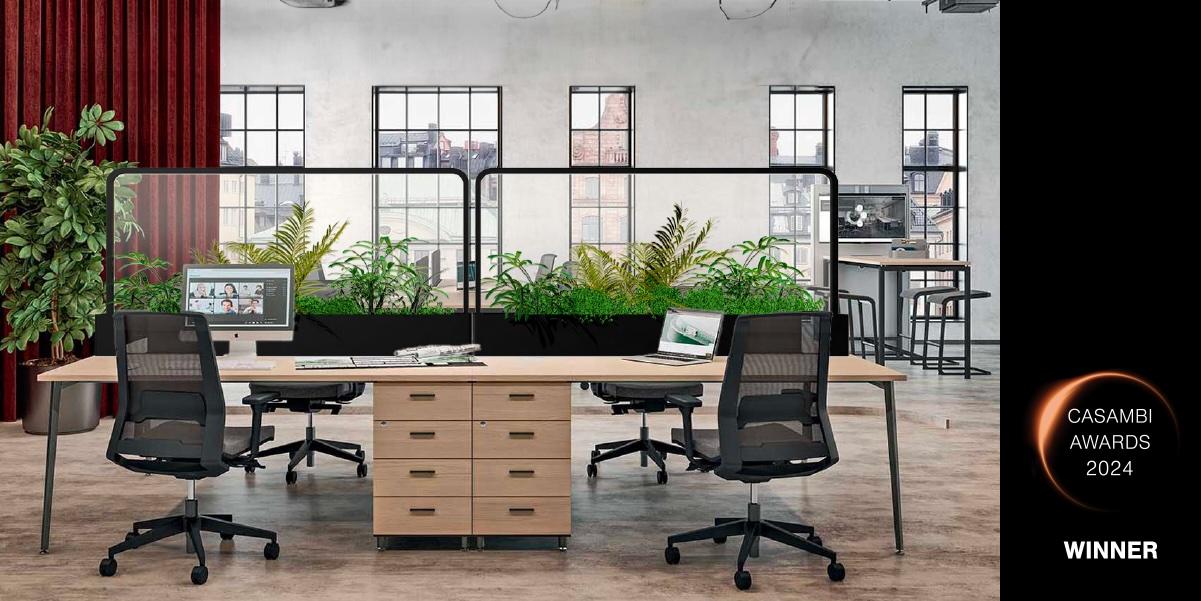
TheLinfaDeskLightbyRobonicaSrlwonBestProduct.TheirofficesolutionmergesLEDlightswitha hydroponicirrigationsystem,addressingbothhumanwell-beingandsustainableindoorplantcultivation. Withdual-tunablewhiteLEDsandautomatedCasambicontrols,itcreatesoptimallightingconditionsfor bothplantsandpeople,makingitastandoutintermsofdesignandfunctionality.
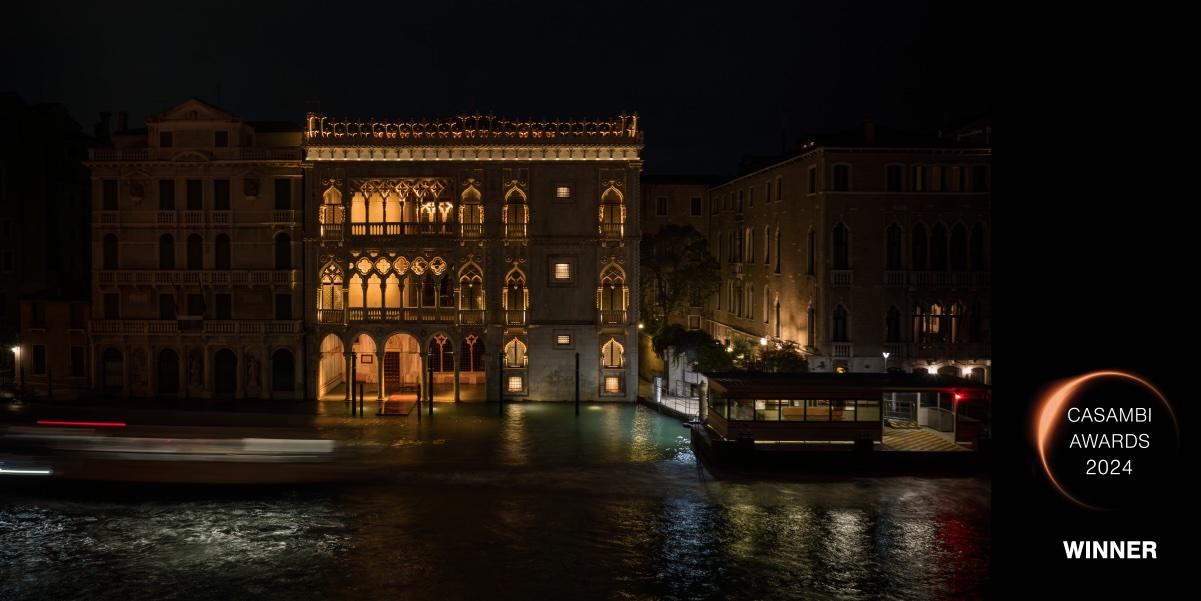
TheGiorgioFranchettiGalleryattheCa’d’OroinVenice,Italy,wonBestProject.Thisproject,ledby restorationarchitectGiuliaPassanteandlightingdesignerAlbertoPasettiBombardellawithERCO,has beautifullyrevivedthehistoricfacadeofthis15th-centurypalace.Therestorationhighlightedthepalace’s originalvibrantcolorsandgrandeur,broughtbacktolifethroughcutting-edgelightingtechnology.
LEDprofessional: Lookingaheadfive totenyears,whatdoyouthinkthe lightingcontrollandscapewilllook like,andwhatrolewillCasambiplay init?Whatareyourlong-termvisions forCasambi,bothintermsoftechnologyandmarketpresence?
MarkMcClear: Thegloballightingmarketisvast,attractive,andgrowing.I expectCasambitoremainindependent,continueexpanding,andgradually replacelegacywiredcontrolsystems. SimilartotheLEDmarketin2010,there arestilllargesegmentsofthelighting industrythathaveyettotryCasambi.I usedtosay,“Nobodywantedtobethe firsttotryLED,buttheysurelinedup tobesecond.”Ibelievewirelesslightingcontrolswillfollowthesamepattern, withCasambistayingattheforefront.I expectcontinuedgrowthacrossallregions,strengtheningourecosystem,and
winningoverthosewhoaresecondin line,oneatatime.
LEDprofessional: Inconclusion,we wouldliketodiscusstheCasambi Awards.Whatarethey,andwhoare thisyear’swinners?
MarkMcClear: TheCasambiAwards areourwayofcelebratingtheincredible workourecosystempartnersdowith ourtechnology.Eachyear,werecognizeoutstandingachievementsinarchitecturallightingprojectsandproducts, focusingondesign,functionality,and sustainability.
Weassembleauniquejuryeachyear, composedofhighlyrespectedindustryinfluencersfromacrosstheglobe whoevaluateentriesintwocategories; BestCasambiReadyProductandBest Casambi-controlledProject.Theylook
forexceptionalexamplesoflightingdesign,whetherit’sthroughinnovativeconcepts,sustainablepractices,orjustthat bitofmagic.Winningprojectsarethose thatexcelinbeingsmarter,safer,and greenerwhileaddingadistinctivetouch tothelightinglandscape.
Thisyear’swinnersexemplifythesequalitiesperfectly.TheLinfaDeskLightby RobonicaSrlwonBestProduct.Their officesolutionmergesLEDlightswitha hydroponicirrigationsystem,addressingbothhumanwell-beingandsustainableindoorplantcultivation.With dual-tunablewhiteLEDsandautomated Casambicontrols,itcreatesoptimal lightingconditionsforbothplantsand people,makingitastandoutintermsof designandfunctionality.
TheGiorgioFranchettiGalleryattheCa’ d’OroinVenice,Italy,wonBestProject. Thisproject,ledbyrestorationarchitect GiuliaPassanteandlightingdesignerAlbertoPasettiBombardellawithERCO, hasbeautifullyrevivedthehistoricfacadeofthis15th-centurypalace.The restorationhighlightedthepalace’soriginalvibrantcolorsandgrandeur,brought backtolifethroughcutting-edgelighting technology.
Everyyear,wereceivehundredsof amazingentriesfromaroundtheworld. I’mcontinuallyimpressedbythecreativityandingenuityinourecosystem.While Casambiprovidesthecoretechnology, it’stheexceptionalcreativityandinnovationofourpartnersthattrulybringsitto life.
LEDprofessional: Thankyou,Mark, foryourtimeandthevaluableinsights intocurrentandfuturesystemsand trends!WewishyoucontinuedsuccessinleadingCasambi.Allthebest withyourvisionsandstrategicplans, andmuchsuccesstoyouandyour team!
MarkMcClear: Thankyou! ■
Foradditionalinformation,pleasevisit casambi.com

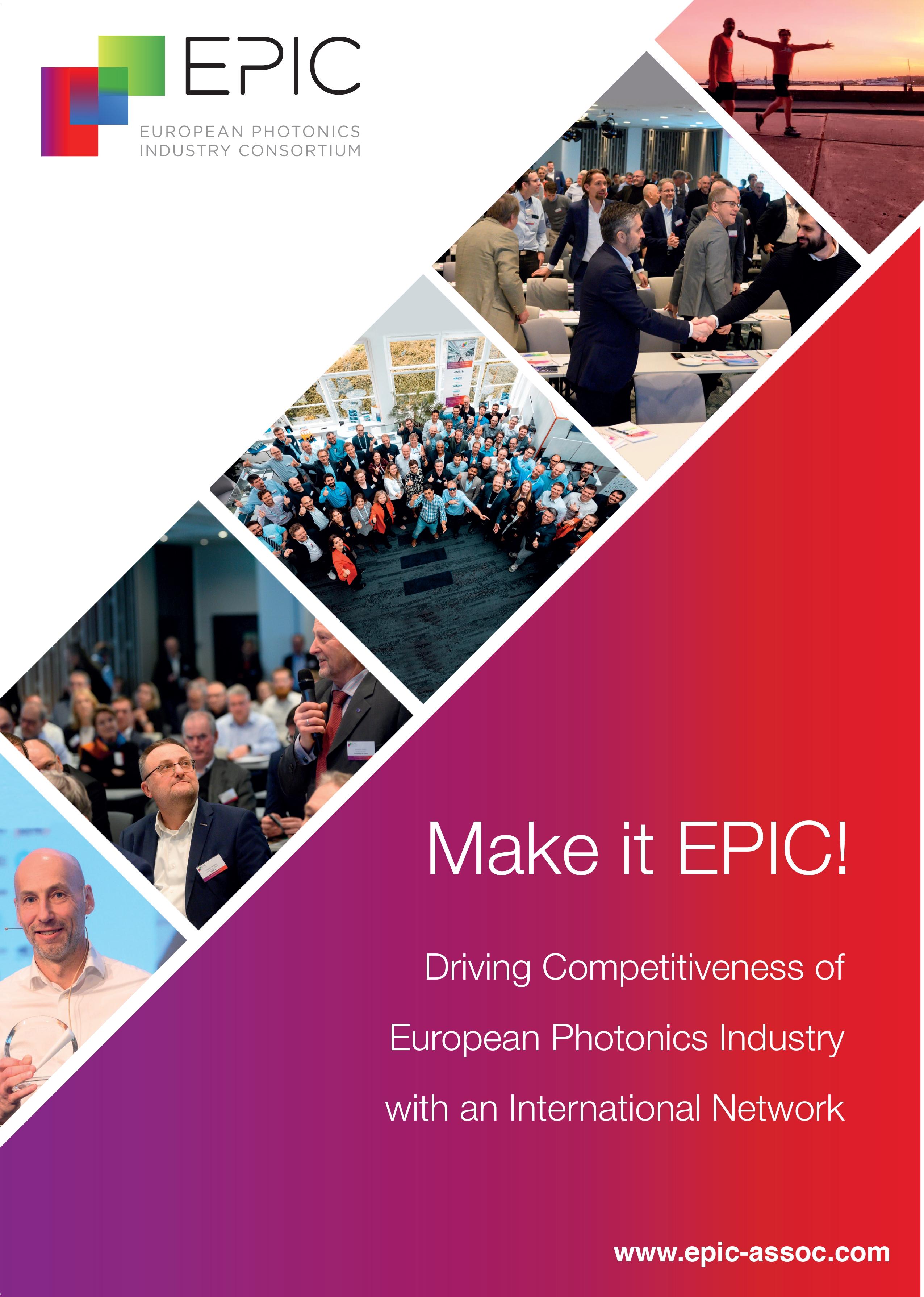
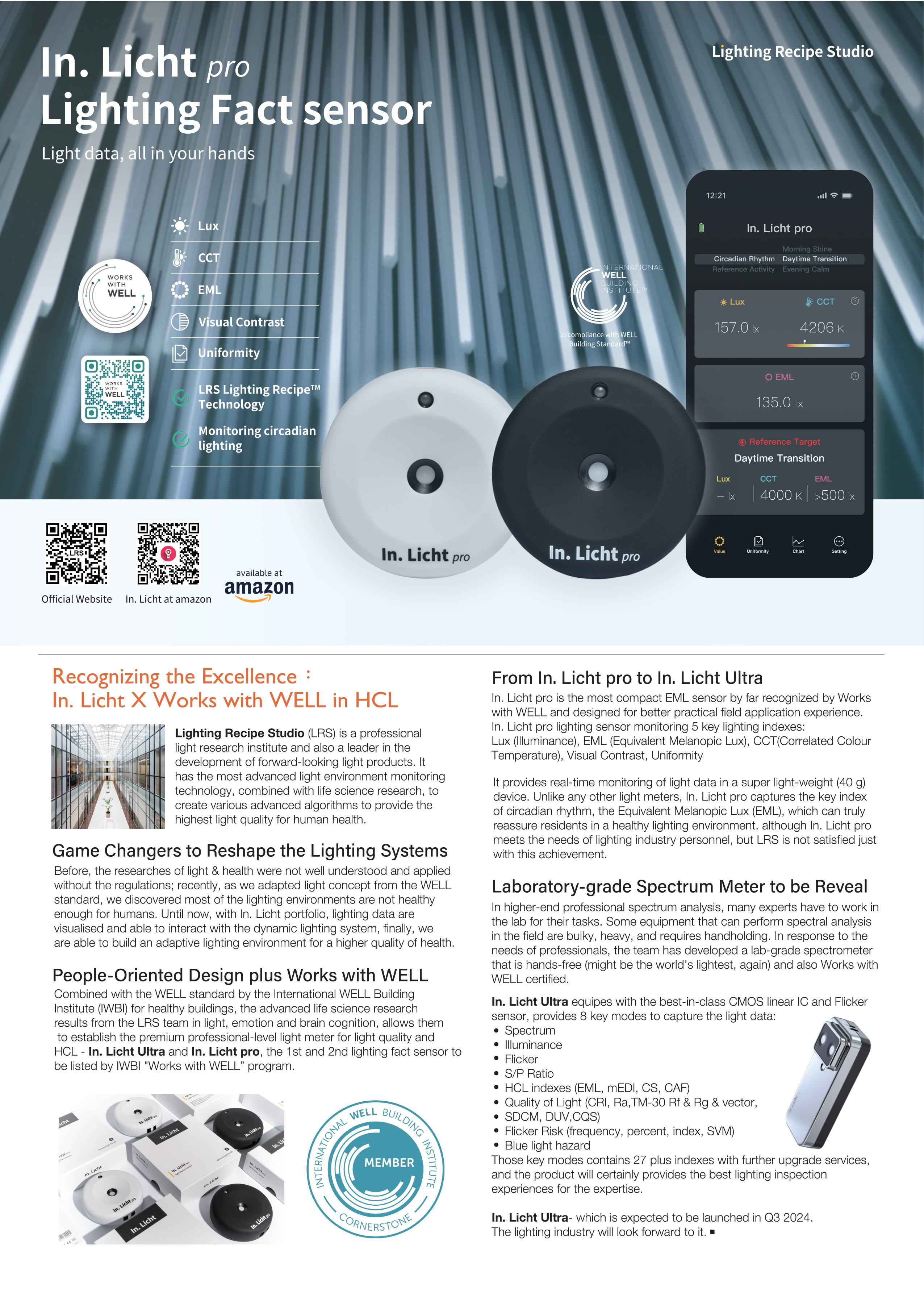
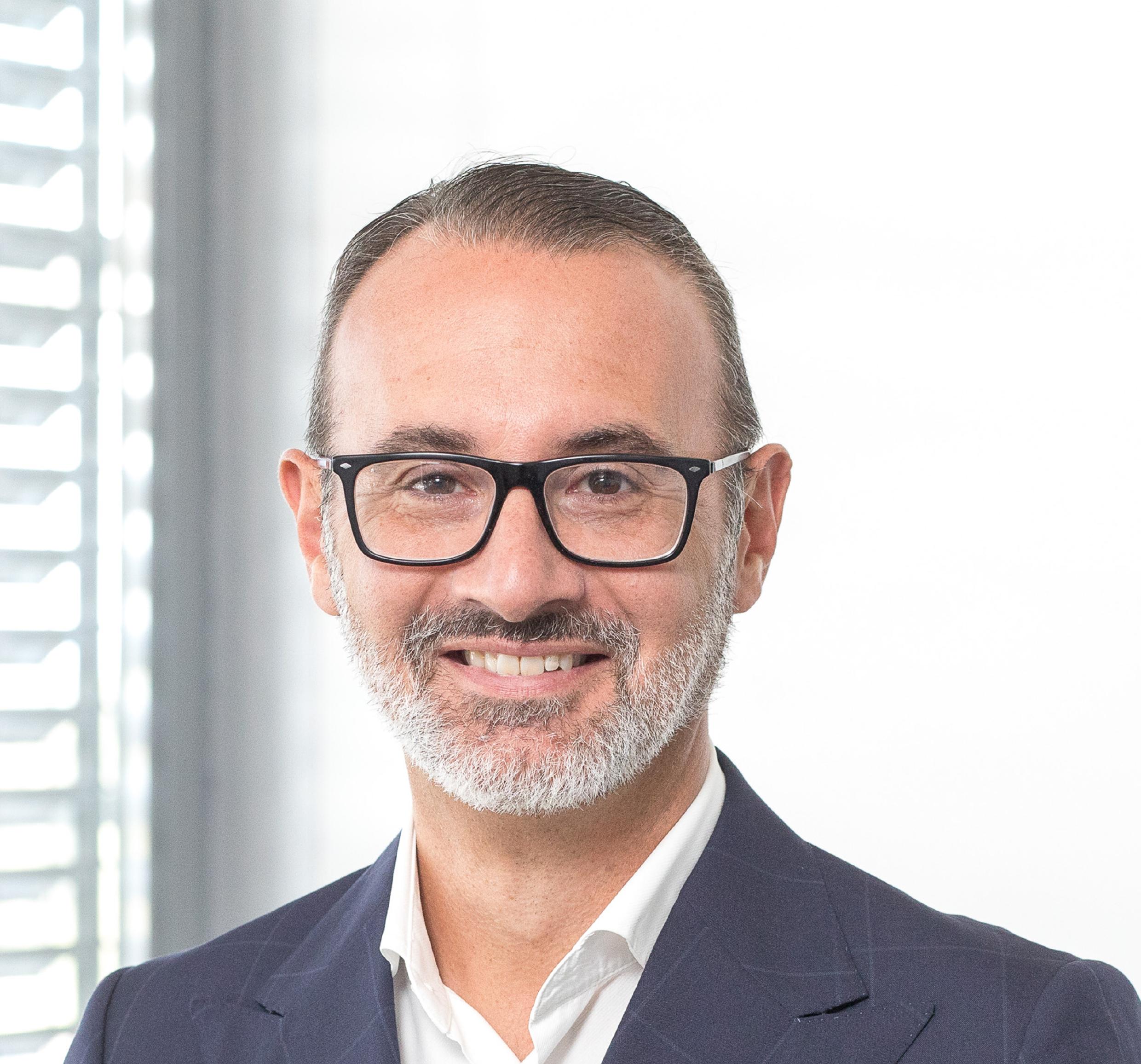
Dr.AntonioA.ROMANO
“Weareattheforefrontofthe transformation,andwiththesupport ofourpeople,partners,and customerfeedback,weareshaping afuturewherelightingdoesmore thanilluminatespaces—itenriches experiencesandfostersahealthier world.”
Inthisexclusiveinterview,Dr.AntonioA.Romano,VicePresidentGlobal R&DatTridonic,sharesinsightsintotheinnovationstransformingthe lightingindustry.Underhisleadership,Tridonicisattheforefrontof smart,sustainablesolutionsthatintegrateAI,IoT,andenergyefficiency. Dr.RomanodiscusseshowTridonicisdrivingadvancementsthatreduce environmentalimpactwhileenhancingwell-beingthroughhuman-centric lighting.FromDCgridsandAI-drivencontrolstotheimportanceof cybersecurityandregulatorycompliance,Dr.Romanoexplainshow Tridonicbalancesinnovation,cost-efficiency,andsustainability.Inthis interview,youwilldiscoverhowDr.Romanoandhisteamareshaping thefutureofintelligentlighting,revolutionizinghowweilluminateand interactwithourenvironments.
www.tridonic.com
LEDprofessional: Thankyoufortakingthetimeforthisinterview.Firstof all,wewouldbeinterestedinhearing aboutthecourseofyourcareerand howyouultimatelybecametheVicePresidentGlobalR&DatTridonic.
AntonioA.ROMANO: ItookonmycurrentroleatTridonicinMay2020coming fromtheZumtobelGroupwhereIwas HeadofR&Dinabusinessunit,andbeforethat,globalHeadofPMOforthe entireorganization.
Aftercompletingmyacademicstudies, myjourneyofinnovationstartedinthe semiconductorindustry,whereIhad globalR&Dandprojectmanagement rolesatSTMicroelectronics,NXP,and ST-Ericsson.
From2005to2007IworkedforaMEMS technologystartupbasedintheUSA thatdevelopedsensorsandactuators forvariousindustries.Thisroletaught metheimportanceofagilityandadaptabilityininnovation,drivingrapiddevelopmentcycleswhilemaintainingtechnicalexcellence.
In2010,ImovedtoPhilipsLighting, whereIfocusedondevelopingsmart lightingsystemsandIoT-enabledsolutions,overseeingglobalR&DandPMO teamsindifferentbusinessunits.This workhighlightedthetransitionfromtraditionallightingtoconnected,data-driven systems.AttheZumtobelGroupand nowatTridonic,myfocushasbeenon componentsfordeliveringcutting-edge, intelligentlightingsolutionsthatmeet evolvingmarketdemands.Leadinginnovationinthisroleinvolvesnotjustdevel-
opingnewproductsbutalsoaddressing challengessuchascybersecurity,regulatorycompliance,andsustainability.
LEDprofessional: Wewouldliketo discusscurrenttrendsinlighting startingwithatopicthatwasalso attheforefrontofthisyear’sLight& Building:Sustainability.Howdoyou understandsustainability,andwhat doesitmeanforresearchandproductdevelopment?
AntonioA.ROMANO: Ourcorporate culturehasalong-standingecological foundationthatwecanbuildon.Weare focusedoncreatinglightingtechnology thatcanmakeapositivecontribution totheplanetandcommunitiesandat thesametimeimproveeveryone’swellbeing.Ourproductsandsolutionsare designedtohelpmitigatetheconsequencesofclimatechange.Weuseour technologicalexpertisetocreatesolutionsthatreducetheenvironmental impact,promoteenergyefficiency,and haveapositiveinfluenceonwell-being andtheplanetasawhole.2
InourR&Dactivitieswefocusonkeyareas,includingenergyefficiency,where LEDlightingprovideslong-lastingproductsthatsignificantlyreduceenergyconsumptioncomparedtoincandescent orfluorescentlighting,leadingtolower carbonemissions.Moreover,integrating sensorsandtheInternetofThings(IoT) allowsforadaptivelightingsystemsthat operateonlywhenneeded,enhancing bothintelligenceandsustainability.In termsofmaterialselection,weprioritize
2https://www.tridonic.com/en/int/company/sustaina bility/sustainable-lighting
recyclable,biodegradableandsustainablysourcedoptionstominimizeourenvironmentalfootprint.Asanelectronics manufacturerwethereforeselectecofriendlysuppliers,meticulouslytraceour supplychainandoptforcomponents withminimalenvironmentalimpact,while emphasizingdurabilitytoreducewaste andtheneedforreplacements.Ourlifecycleapproachinvolvesdesigningproductsforeasydisassemblytoenhancerecyclingandend-of-lifemanagement,and embracingacirculareconomymodel thatencouragesreuse,remanufacture orrecyclingofproductstominimize resourceextractionandwaste.Additionally,ourcommitmenttohealthand well-beingisrootedinourunderstanding oftheimpactthatlightinghasonpeople. Bymaintainingnaturalrhythms,oursystemscanalleviateeyefatigue,brighten moods,andenhanceproductivity.
LEDprofessional: Lightingsystems areincreasinglyevolvingintomore complexarchitectureswithsensors, networks,datahandling,andmuch more.Whereisthejourneyheading intermsoflightingcontrolsandwhat canbeachievedwiththis,forexample,inthecontextofhuman-centric lighting?
AntonioA.ROMANO: Lightingsystems areindeedevolvingintocomplexarchitectureswherehumansandtechnology areinteractingmorecloselythanever. Weshapetheconnectivitycomponents youhaverightlylistedintosystemsthat makethingsmucheasierforpeopleand ultimatelyleadtotheconvenientuseof sophisticatedtechnology.Thesesmart
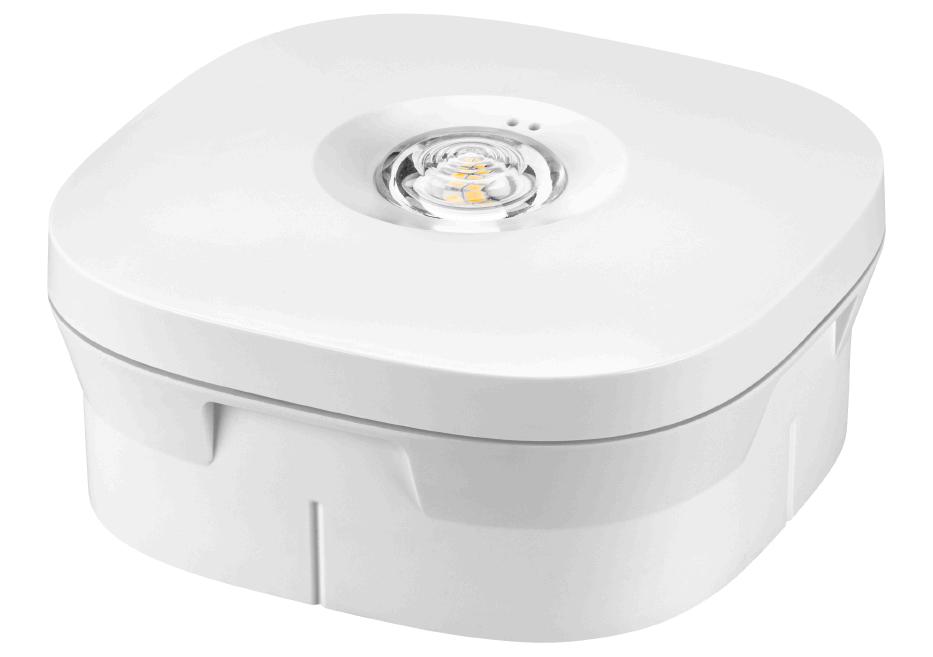
Tridonicisknownforitsexpertiseinthefieldofemergencylightingandwantstodevelopemergency lightingproductsforfurthermarkets.TheEMready2applyportfolioconsistsofready-to-useemergency luminairesforbothrecessedandsurfacemountingontheceiling.
systemscanbeappliedtoutilizeenergy moreefficiently.
Smartandadaptivelightingmeansthat dynamiccontrolscanadjustlightinglevelsbasedonreal-timedata,suchas occupancyanddaylight,creatingpersonalized,energy-efficientenvironments. Thinkofcomplexofficebuildingswhere peopleworkindifferentareasatdifferent times.Asafacilitymanager,youneed toknowhowmuchenergyisbeingconsumedandatwhattimes,andwhether lessfrequentedroomscanbeused moreeconomically.Thisinvolvesgatheringreliabledatawhichyoucoulddo withthehelpoftheomnipresentlighting system.That’swhywedevelopsystems thataredesignedtoprovidegoodlighting,butthatcanalsosupplytheBuilding ManagementSystemwithdatausing sensorsandcontrols.Thinkingonestep further-beyondthebuildingmanagement system–youcometotheintegrationof IoT,whichenhancesholisticbuilding managementbylinkinglightingwithcentralsystemscontrolledfromanywherein theworld.3
Human-centriclightingisanothersignificantarea.HCLsystemscanadjustcolor temperaturesthroughoutthedaytosupportnaturalcircadianrhythms,improving alertnessduringthedayandhelpingto relaxintheevening.Settingscanbepersonalizedtoenhanceindividualcomfort andproductivity.Energyefficiencyand sustainabilityareimprovedbyautomated energymanagementsystemsthatintelligentlydimorturnofflightingwhennot
3https://www.tridonic.com/en/int/controls/indoor/sc enecom-evo-dali-2-lighting-control
inuse,effectivelyreducingconsumption. Predictivemaintenancedrivenbydata analyticscanoptimizeperformance,extendingsystemlifespansandreducing downtime.Enhanceddatautilizationis madepossiblethroughsensorsthatprovideinsightsintospaceutilizationand informationonenergy-savingstrategies. Inhealthcaresettings,lightingsystems equippedwithbiometricsensorscanaid inpatientrecoverybyadjustingilluminationbasedonindividualhealthdata. Finally,userinteractionandAIintegration throughvoiceandmobilecontrolsfurther amplifyaccessibilityinlightingmanagement.
Theresultingconnectivityoffersmore andmorepossibilities-butitalsogeneratesgreatercomplexity.Thismakesitan excitingandchallengingtaskforusas developersnottomakethesesystems toocomplicatedforpeopletouse,but rathertomaketheuserexperienceand usabilityclearandconvenient.Afterall, theyshouldservepeople,supportwellbeingandbekindtotheplanet.
LEDprofessional: Theconnection betweenartificialandnaturallight playsasignificantrole.Well-being largelydependsonwhetherwehave aconnectiontotheoutside.What doesamodernlightingsystemlook likefromthisperspective,andwhat technologiesarerequired?
AntonioA.ROMANO: Modernlightingsystemsseamlesslyintegrateboth artificialandnaturallighttoenhance well-being.AtTridonic,weaddressthis connectionbyemployingdynamicday-
lightsimulation,utilizingtunablewhite LEDscapableofmimickingnaturaldaylight’scolortemperaturesandbrightness tosupportcircadianrhythms.Wealso incorporatetechnologiesthatharvest naturallight,ensuringthatadequateartificialilluminationcomplementsexisting naturallight.Buildingintegrationisenhancedthroughbiophilicdesign,which incorporateslargewindowsandskylightstomaximizenaturalillumination, whileautomatedshadingsystemsregulatesunlightexposuretomaintainindoor comfort.Additionally,AIenablesrealtimeadjustmentstobemadetostrikea betterbalancebetweennaturalandartificiallightbasedoncurrentconditions anduserbehavior,ultimatelyimproving healththroughenhancedexposureto naturallight.
Withthesetechnologies,modernlighting canbringmanybenefitstoendusers. Harmonizationwiththehumancircadian rhythm,forexample,supportsalertness duringtheworkingdayandrelaxation phasesattherighttimes.Thelighting canalsobecustomizedtopersonalrequirements.Asaresult,goodlighting canpromoteoverallwell-being.
LEDprofessional: Onetopicthathas becomeincreasinglyprominentlately istheuseofDCgridsforlighting. Whatisthecurrentstateofdevelopments,andwhatcanthemarket expectinthissegmentinthefuture?
AntonioA.ROMANO: AtTridonic,we areactivelyengagedinthedevelopmentofDCgrids.Thesesystemsare gainingtractionthankstotheirefficiency andcompatibilitywithrenewableenergy sources,sparkingfrommajorplayers outsidethelightingsectoraswell.This shiftcoincideswithrisingenergycosts andagrowingdesiretoreducedependenceonfossilfuels.
DCgridsareparticularlysuitedforhighdemandsectorssuchasdatacenters, wheretheyenhanceefficiencyandintegrateseamlesslywithsolarpanels.TridonichasrecentlyjoinedtheCurrentOS Foundation4 asboardmembers,which presentsanexcitingopportunityforus. OurintentionistopromoteDCtechnologiesthroughexperientialcenterswhere customerscanwitnesstheirfunctionalityacrossvariousapplications,including streetlighting,verticalfarming,anddata centersaswestronglybelievethatthis 4https://currentos.foundation/
iswhatcustomersneed,consideringthe factorswehavejustmentioned.
WearecurrentlyworkingwithsomeDC partnerstoprovidedriversandluminairesforthoseprojects.
LEDprofessional: Whatinfluence, status,andsignificancewillAIhave forlight,lightingcontrols,andtheir applications?
AntonioA.ROMANO: Thisissomethingwearedealingwithintensively.AI, ormoreaccurately,machinelearning, isrevolutionizinglightingbyenabling intelligent,adaptivecontrolsthatoptimizeenergyconsumptionandenhance usercomfort.AI/MLtechnologiesdrive smarterlightingsystemsthatadjustdynamicallytoreal-timeconditionsand userbehavior.Anditisalreadyhelping withpredictiveanalytics:AIcananalyze patternstopredictmaintenanceneeds andoptimizelightingperformance,reducingdowntimeandoperationalcosts.
ThesignificanceofAI/MLextendsto personalizedlightingexperiencesand seamlessintegrationwithothersmart buildingsystemswhichfostersacohesiveandefficientbuildingmanagement ecosystem.
Ourjourneybeganwithusingdatadrivenalgorithmstoautomatebasic lightingfunctions,suchasadaptivelightingthatrespondstoexternallightlevels, occupancy,andtimeofday.EarlyAI effortswereaimedatimprovingenergy efficiencybyautomatinglightintensity andtiming.
Wethenadvancedtowardsmorecomplexdeeplearningmodels,enabling lightingsystemstolearnfromuserbehaviorsandpredictpreferences.The systemsnowunderstandpatternsofindividualorgrouppreferences,adjusting thelightingtosuitvariousactivitieslike workmeetings,relaxationandpresentationswithoutmanualintervention.
OurAIsolutionsareintegratedwith IoTdevicesandothersmartbuilding systems,suchasHVAC,security,and shading.Thisinteroperabilityallowsfor aholisticapproachtobuildingmanagement,enhancingbothoccupantcomfort andenergymanagement.
WiththeinclusionofMLalgorithms,we canmovetowardreal-timeoptimization. Thesystemcollectscontinuousdata andmakesadjustmentsbasednotonly onhistoricaldatabutalsoonreal-time inputs,offeringpredictivemaintenance andevenimprovingthelifespanoflightingcomponents.
Inoneofourprojects,weimplemented anAI-controlledlightingsysteminalarge officebuilding.Ithaschangedsome aspectsofthespace.Inthepersonalizedworkspaces,AIcollecteddata abouteachemployee’slightingpreferencesbasedontheiractivities,includingpreferredbrightnesslevelsand workinghours.Overtime,thesystem learntpatternsandautomaticallyadjustedthelightingtotheindividualneeds ofeachemployeeastheyenteredthe workspace.
AIalsoachievedimprovementsinenergyefficiency.Itcontinuouslyanalyzed occupancypatternsandtheavailability
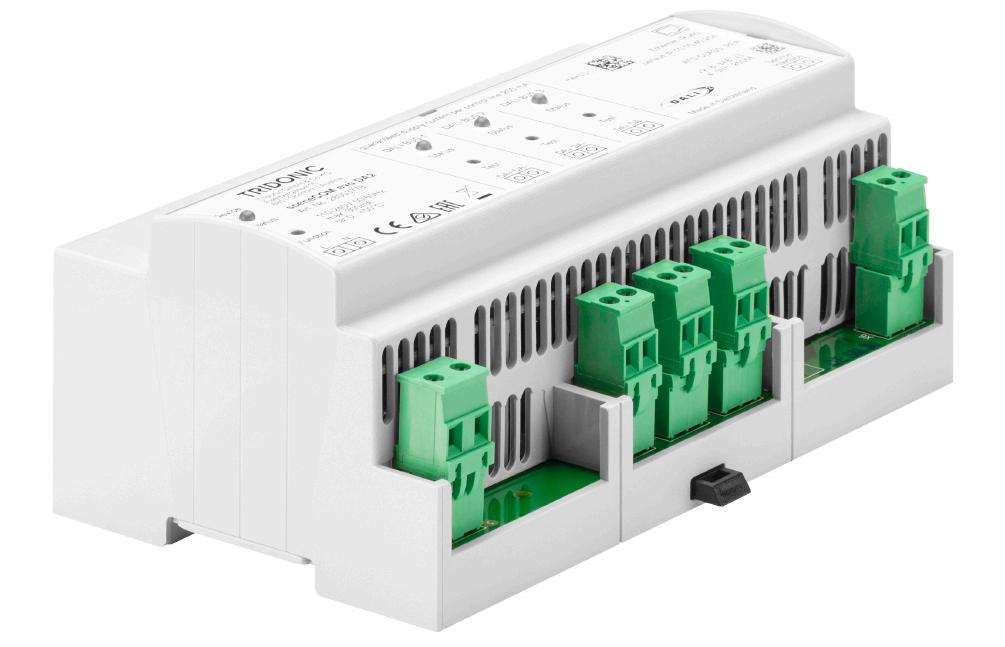
IntegrationinBuildingManagementSystemsisthetaskoftheapplicationcontrollersceneCOMevowithits interfaces.ThisscalableDALI2controlsolutionforinteriorlightingcancentrallycontrol,monitorand maintainthelightingfromindividualfloorstoentirebuildings.
ofdaylightinordertooptimizeenergy consumption.Forexample,thesystem dimmedthelightsnearwindowsduring thedaywhentherewasplentyofnatural sunlight,whileensuringthattheinterior spaceswereadequatelylit.
Integrationwithothersystemswasimportantforthisproject.Thelightingsystemwasalsointegratedintotheoffice’s HVACsystem.Whenonlyafewpeople werepresent,thelightingwasdimmed, andtheHVACsystemreducedtheair conditioningwithoutcompromisingcomfort.Overall,thewell-beingoftheemployeeswasparamount.AImonitored circadianrhythmsandadjustedthelightingtopromotealertnessandwellbeing byusingcoolerlightinginthemorningto energizeemployeesandwarmerlighting intheafternoontorelaxthem.
LEDprofessional: Productandsystemdevelopmentfacesthechallenge offindingabalancebetweencost, progress,andpoliticalregulations. Whatarethekeyissueshere,and whatsolutionsdoyouseeorhave plannedinTridonic’sroadmap?
AntonioA.ROMANO: Inproductand systemdevelopment,balancingcost, innovationandadherencetopolitical regulationspresentsseveralchallenges. CostcontrolisessentialtomaintainR&D expenseswhileensuringcost-efficient productionandprofitability.
Ourplatformapproachisdesignedto significantlyenhancecostefficiency andacceleratetimetomarket.Letme givesomeinsightsintoourstrategyin R&D.Oneofourapproachesisabout reusing.Withourestablishedlibraries ofintellectualpropertyacrossmultiple projectsweminimizetheneedforredundantdevelopmentwork.Thesepre-built componentsaretestedandvalidated, reducingtheriskoferrorsandensuring reliability.Thisalsoleadstofasterprototyping.Withready-to-useIPs,wecan quicklyassembleprototypesandconductpreliminarytests.Thisreducesthe timespentondevelopingcomponents fromscratchandallowsustofocuson integratingandcustomizingthemfor specificneeds.
Intermsofcustomizablesolutions,we haveourpowerfulfirmwarearchitecture. Integratedinthedevices,itprovidesa versatilefoundationthatcanbetailored tofitvariousapplications.Thismeans
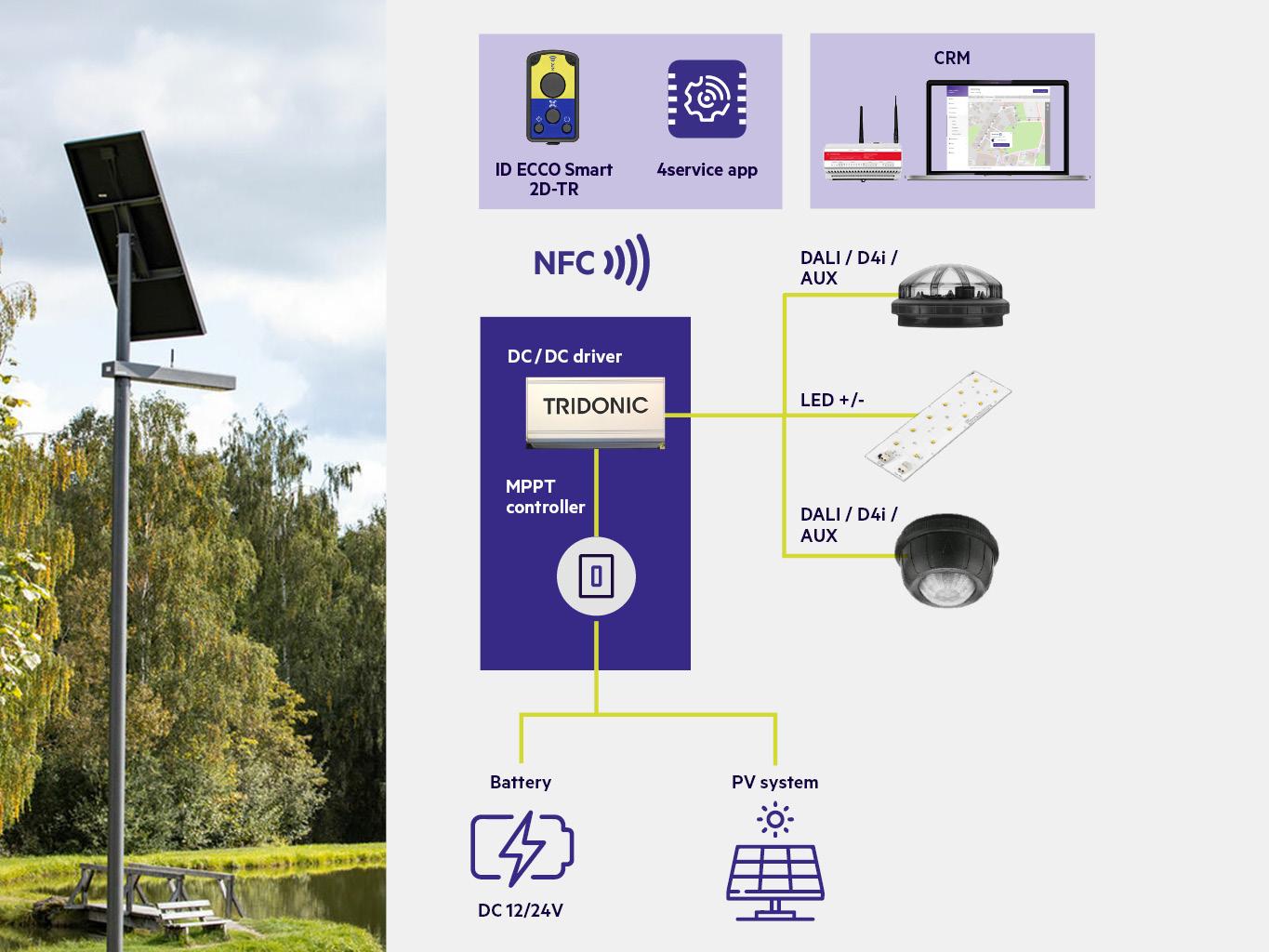
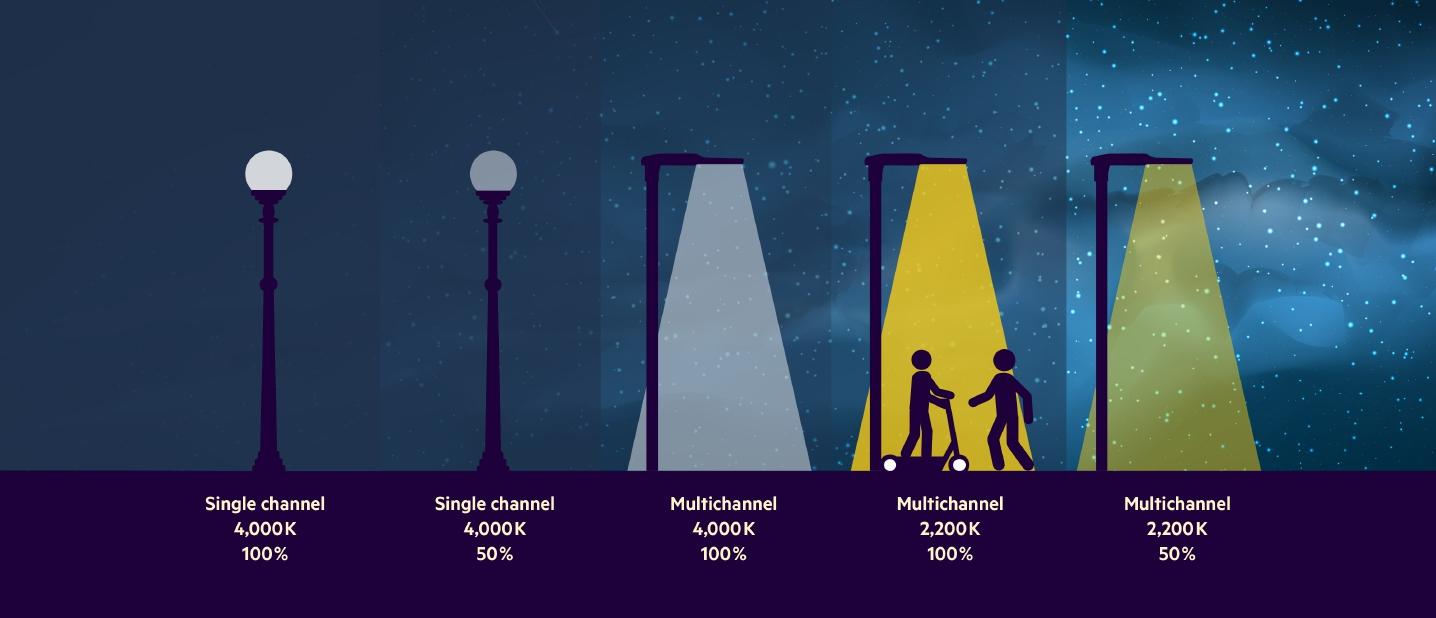
Tridonic’sMultichannelOutdoorSolutionenablesOutdoorlightingapplicationstoimprovesafetywhile minimizingtheimpactonecologicalsurroundings,usingTunableWhiteforoutdoorlighting.
wecanadjustthefirmwaresettings tooptimizeperformanceandfeatures basedonthespecificrequirementsof eachproject.Theabilitytocustomize firmwarewithoutalteringtheunderlying hardwareorIPlibrariesmeanswecan adaptoursolutionsmorerapidly.This flexibilityallowsustomeetuniquecustomerrequirementsefficiently.
BothreusableIPsandadaptablefirmware, streamlinethedevelopmentprocess. Thisapproachsignificantlyshortensthe timerequiredtobringourproductfrom concepttomarket.Wespendlesstime oninitialdevelopmentandtesting,leadingtofasterdeploymentofsolutions.
Ourplatformapproachallowsustorespondquicklytochangesinmarketde-
mandsorcustomerfeedback.Ifadjustmentsareneeded,wecanmake firmwarechangesortweakexistingIPs ratherthanstartingfromscratch,ensuringthatupdatesandnewfeaturesare deliveredpromptly.
Reduceddevelopmenttimeandthe abilitytorepurposeIPsleadtolower costs.Weavoidtheexpenseofdevelopingnewcomponentsforeachproject andminimizetheresourcesneededfor testingandintegration.Ourdevelopmentteamscanfocusoninnovatingand addingvaluetoeachproject.Thisnot onlyspeedsuptheprocessbutalsoallowsustoexplorenewpossibilitiesand featuresmoreeffectively.
Insummary,ourplatformapproachofferssignificantadvantagesintermsof timetomarketbyacceleratingdevelopmentprocesses,reducingcosts,and enablingrapidcustomization.Thisleads tofasterdeliveryofhigh-quality,tailored solutionsthatmeetthespecificneedsof ourcustomers.
Adheringtostrictregulatoryrequirements,particularlyconcerningcybersecurityaspectsliketheEU’sNIS2 directive,addstimeandcoststodevelopment.Weareactivelydeploying robustencryption,strongerauthenticationmethods,androutineupdates tosafeguardagainstunauthorizedaccessandensuredatasecurity,even thoughitincreasescosts.Additionally, keepingpacewithrapidtechnological changesiscrucialforcreatingadaptable, future-proofproducts.Toaddressthese challenges,wehavededicatedteams focusingoninnovationsinvariousareas,frompowerconversionanddata managementtoemergencyprotocols, sensors,andASICdesigns.
Lookingahead,ourroadmapaimsto capitalizeonthesefactorsbydeveloping modulardesignstoenhanceproductionefficiencyandsimplifyregulatory compliance,collaboratingwithexternal partnersforcutting-edgetechnologicaltrends,andinvestinginsustainable practicestoreducelong-termcosts. Weproviderobustcybersecuritywith strongencryptionandauthentication, safeguardingdataandensuringcompliancewithregulations.Ourseamless over-the-airupdatesallowforeasyimplementationofsecuritypatchesand newfeatures,keepingproductssecure andadaptabletoemergingneeds.
LEDprofessional: Whatarethekey productfamiliesTridoniciscurrently offering,andwhatisinthepipeline?
AntonioA.ROMANO: Letmestartwith ourstrategicdirection.Outdoorlighting willbeoneoftheareasweplantoinvest insignificantlyoverthecomingyears. Ourgoalistoprovidecompletesolutions.Wealreadyofferlightingcontrols, andwe’repartneringwithvariouscompaniestofullymanageluminairesand streetlightingsystems.
Thisproductfamilyalsoincludessolar lightingsolutions.Forinstance,wehave productsforoff-gridlocationsandareas withlimiteddaytimeillumination.These
solutionsallowenergytobestoredduringthedayandusedatnight.We’re developingproprietarytechnologyand algorithmstomanagebatterycharging anddischargingmoreefficiently,and weaimtobringthistomarketbythe endof2025.Thetechnologyisalready developed—wejustneedtoindustrialize it.Ideally,wewanttomanagetheentire processinternallyforgreaterefficiency.
Thesecondproductfamilyisemergency lighting,whichwillexpandinthecomingyears.5 Wealreadyofferemergency driversandconverterbatteries,oftenin “ready-to-apply”bundledsolutions.
Wearecurrentlyoperatinginternationallywithouremergencylightingbusiness andareparticularlysuccessfulinthe UnitedKingdom.Movingforward,we plantoexpandthisofferingintonew markets,liketheU.S.Thiswillrequire adaptingtonewregulationsandintroducingslightlydifferentfeatures.Markets likesouthernEurope,includingFrance andSpain,havedifferentrequirements comparedtotheUK.
Smartbuildingscallforsmartsolutions— andsensor-basedsystemsarekeyhere. That’sthethirdarea:namelysystems &services.We’recurrentlyworkingon newcamera-basedsensors.We’vealreadylaunchedSensorX,andwe’re workingonanindoorversionthatwillbe readybyJune2025.
LEDprofessional: Whataretheadvantagesofthis?
AntonioA.ROMANO: Thesesensors willnotonlycountpeoplebutalsorecognizeshapes.Theycandetectwhether peoplearetalking,usingaphone,or evenifsomeoneisindistress,suchas havingaheartattackandfallingdown. Initially,thesensorwillfocusoncounting peopletooptimizespaceusage,butadditionalfeatureswillbeaddedovertime.
LEDprofessional: Isthereanotherkey area?
AntonioA.ROMANO: Yes,dataisour fourthfocus.We’reinvestinginartificialintelligenceandmachinelearning. We’verecentlyaddeddataspecialiststo ourteam,andwe’recommittedtothis areabecausedataiscrucialforourcustomers.
5https://www.tridonic.com/en/int/emergency-lightin g/emergency-lighting
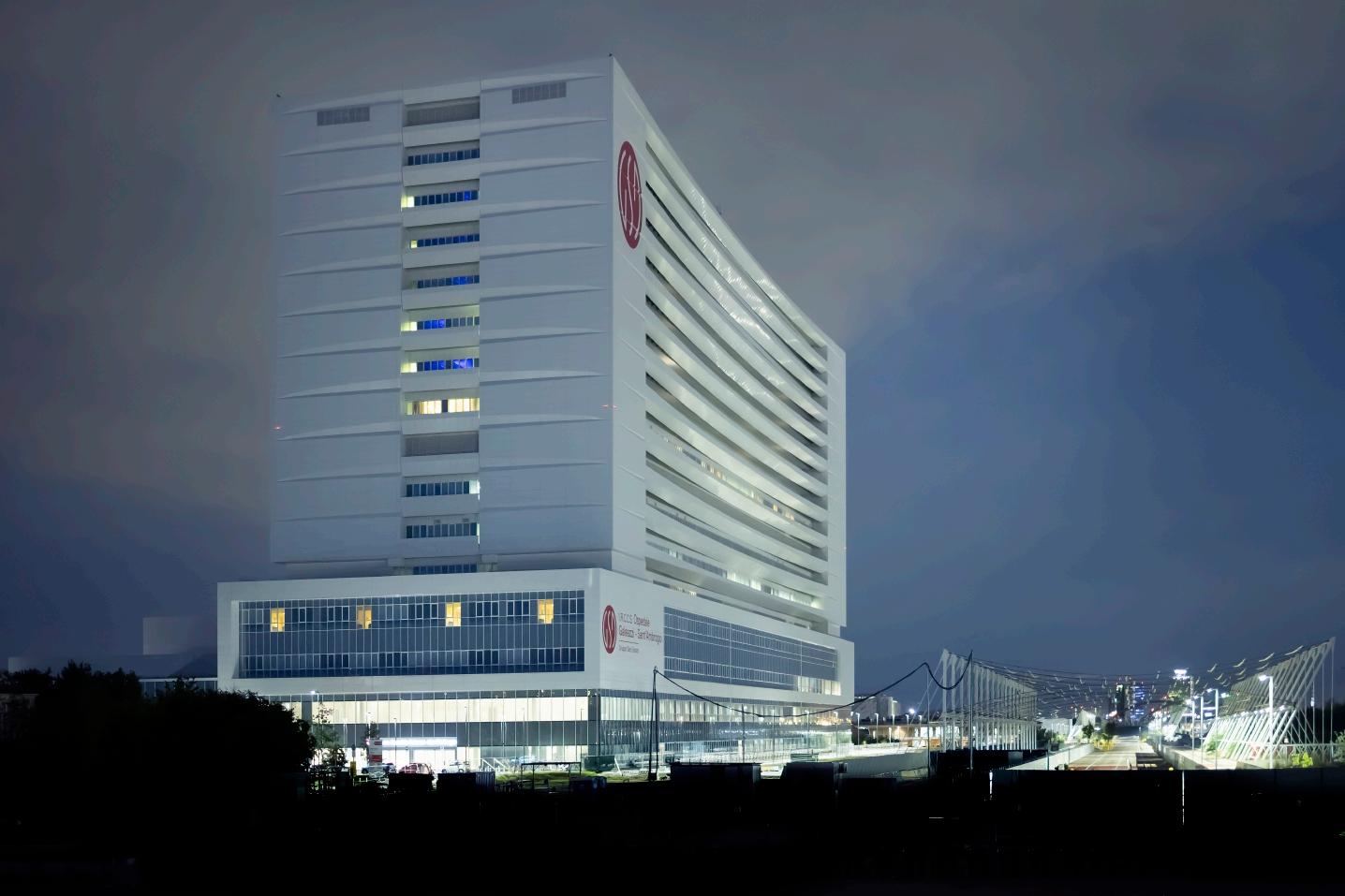
ThenewlybuiltOspedaleGaleazziinMilanwasplannedaccordingtostrictsustainabilitycriteria,towhich thesophisticatedlightingmanagementalsocontributes.Theinterfaceinfrastructureenablesfuturesystem datatobecommunicatedwithoutanyproblems.
Weofferanindividualconsultingservice calledLightCoach,whichleveragessensordatatoprovideinsightsintosystem functionality.Weworkcloselywithcustomerstoensuretheyaregettingthe mostoutofthedata,andbasedontheir feedback,wefine-tunethesystem.
Thisisprimarilyfocusedonindoorapplications.Thedatastayswithinthesystem,andonlyaggregated,anonymized informationisavailable.Indoordata helpsfacilitymanagersoptimizeoperations,suchasknowingwhichrooms don’tneedcleaningorwhichluminaires arenearingfailure,allowingforpreventive maintenance.Thisiswheremostofthe data-drivenimprovementsoccur.
LEDprofessional: HowareyoursystemslinkedtoBuildingManagement Systems(BMS)?
AntonioA.ROMANO: Lightingcontrolismoreprecisethanothersystems becauseitrequiresmorespecifictargeting.WhilewehavenointentionofenteringtheBMSmarketdirectly—dueto thedominanceofmajorplayerswesee greatpotentialinpartneringwithcompaniesinthisfield.
OurambitionwithourLightingManagementSystemistointegratemoredeeply withBMS.Bycombininglightingand sensing,yougetmoregranularcontrol. Unliketraditionalsystemsthatonlyprovidebasiclightingfunctionslikeon/off
anddimming,wecanofferfarmoreprecisecontrolattheluminairelevel.This iswhereourpartnershipsbecomevaluable.
Forexample,werecentlycollaborated onamajorprojectatanewhospitalin Milan,where16,000luminaireswereinstalled.Wewereabletointegratewith theBMStoprovideseamlessdataand control,makingiteasyforfacilitymanagerstoidentifyandaddressissues.6
LEDprofessional: Canyoudiscuss thechallengesrelatedtotheglobal supplychain?
AntonioA.ROMANO: In2021and 2022,theEuropeanandWesternlightingindustrieswereheavilyimpactedby componentshortages,whichdelayed ourroadmapbyaboutayearandahalf. Duringthattime,wehadtoredesign productsusingavailablecomponents. Thisprocesstookupabout20%ofour R&Dbudget,aswehadtocreatenew designsusingalternativecomponents.
Theshortageseasedbytheendof 2023.Topreventdisruptionsweidentify criticalcomponentsearlyinthedesign processandensurealternativeoptions areavailable.Forexample,wedesign productswithenoughspacefordifferenttransformersizes,allowingflexibility ifonecomponentbecomesunavailable.
6https://www.tridonic.com/en/int/reference-projects/ reference-ospedale-galeazzi-sant-ambrogio-italy
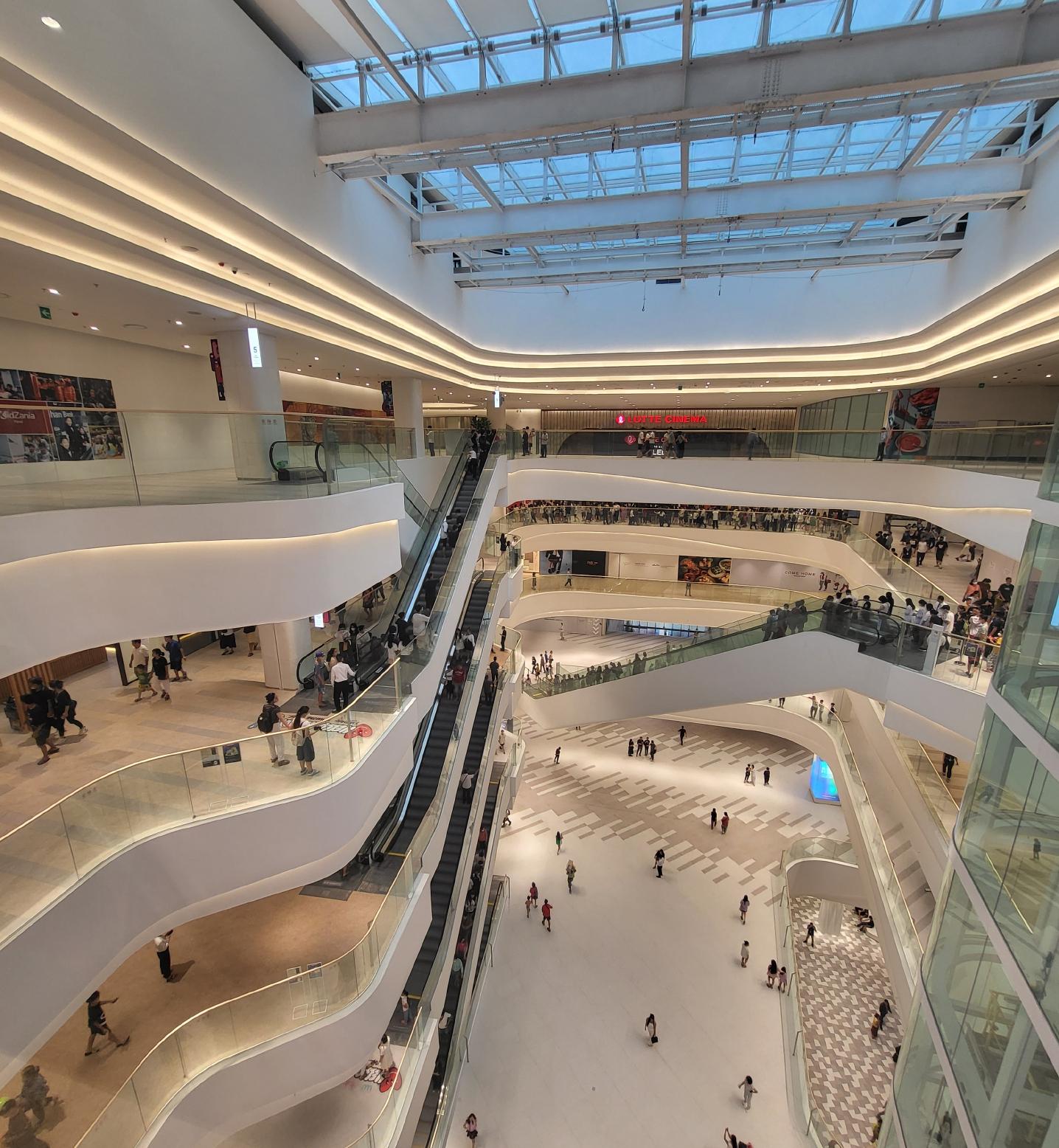
Wirelesslightingcontrolforacompleteshoppingmall:TridonicsuppliedbasicDIMWirelesspassivemodule G2applicationcontrollersanddriversforthevariousluminairesintheLotteMallinHanoi,Vietnam.The applicationcontrollerscanbemanagedwirelesslyviaanAndroidoriOSdeviceanddonotrequirea gateway.
WeapplythesameprincipletoICs,microcontrollers,andMOSFETs.Ifitmakes sense,webuildintheseoptionsfromthe starttoavoiddelays.
LEDprofessional: Whereareyour R&Dcenterslocatedglobally?
AntonioA.ROMANO: WehavemultiplespecializedR&Dlocations.7 InPorto, Portugal,wehave70peopleworking onsoftwaredevelopment.InSpennymoor,UK,about40peoplearefocused onemergencylighting.InEnnenda, Switzerland,wehaveoursensorcompetencecenter.InJennersdorf,Austria wehaveanR&Dcenterwithexperts forlightsources.Dornbirn,Austria,is primarilyresponsibleforplatformdevelopment.BetweenJennersdorfand Dornbirn,wehavearound60people,includingsolutionarchitects.Wealsohave
7https://www.tridonic.com/en/int/company/about-tri donic
developmentteamsinNis,Serbia,and Shenzhen,China.
LEDprofessional: Withthisarrayof newtrendsandtasks,thequestion arisesofhowyouareaddressing thesechallenges.Whatresearchcollaborationsandactivitiesareyoupursuingoutsideyourorganizationand inpartnershipstoeffectivelydevelop newsolutions?
AntonioA.ROMANO: Weprioritize collaborationwithinnovationcenters, leadinguniversities,andresearchorganizations.WeareengagedwiththeUniversityofNewcastleandT/UEindhoven inareaslikedigitaltwindevelopment, powerelectronicsandsensortechnologies,ensuringweprovideourcustomers withstate-of-the-artsolutions. OurpartnershipsalsoincludecollaborativeeffortswithV-ResearchandtheUniversityofAppliedSciencesVorarlberg, focusingoninnovativelightingsystem
managementandenhancingthepower densityofLEDdrivers,leadingtosignificantminiaturization,reducedmaterial usage,andwaste.
OurcomprehensiveR&Dactivitieshas ledtoaremarkableportfolioofpatents withinourindustry.Tridonicfiles50-60 newpatentsannually,makingusthe second-largestpatentapplicantinAustria.
LEDprofessional: Doyouhaveaclosingstatementthatsuccinctlycharacterizesthetrendsinthelighting sector?
AntonioA.ROMANO: Thelightingsectorisundergoingaprofoundtransformationtowardgreaterawarenessof ourinteractionswiththeenvironments inwhichwelive.Wearemovingbeyondmereilluminationbyrespectingour planetandthereforeembracingenergyefficientLEDs.Smartsystemsarebeing designedwithafocusonadaptability, promotingwell-being,comfort,andsustainability.Thisshifttranscendstechnology;itisaboutcraftingenvironments thatenhanceourdailylivesandcontributetoahealthierplanet.
AtTridonic,weareattheforefrontof thistransformation,andwiththesupportofourpeople,partners,andcustomerfeedback,weareshapingafuture wherelightingdoesmorethanilluminate spaces—itenrichesexperiencesand fostersahealthierworld.
LEDprofessional: Thankyou,for yourtimeandthevaluableinsights intocurrentandfuturesystemsand trends,Antonio!WewishyoucontinuedsuccessinleadingtheR&Dat Tridonic.Allthebestwithyourvisions andstrategicplans,andmuchsuccesstoyouandyourteam!
AntonioA.ROMANO: Thankyou, Siegfried!IthasbeenapleasurediscussingwhatishappeningatTridonic. ■
Foradditionalinformation,pleasevisit www.tridonic.com


Dipl.-Ing.JohannesWENINGER1,3,TeamLeaderResearchat
Bartenbach,andDr.techn.SaschaHAMMES2,M.Sc.,Researcher atUniversityofInnsbruck
Inthepursuitofcurrentclimateand environmentalgoals,enhancingthe energyefficiencyoflightingsystems provestobecrucial.However,the existingdiscrepanciesbetweenpredictedandactualenergyconsumption demonstratethat,despiteefforts,the fullpotentialforenergysavingshas notbeenrealized,asacomprehensive understandingofthefactorsinfluencingtheenergyconsumptionofartificial lightingsystemsisstilllacking.
Inrecentyears,BartenbachhasconductednumerousstudiesinitsLiving LabincollaborationwiththeUniversity ofInnsbruck,whichaimedatimprovingboththeenergeticpredictability andoperationalefficiencyoflighting systems.Inthistwo-partseriestheresultsarepresentedinaconsolidated manner.Whilethispartfocusesonthe identificationofthefactorsthatinfluenceenergyconsumption,thesecond partwillprimarilyaddressmitigation strategies.Theresultsnotonlyreveal clearenergy-savingpotentialsbutalso highlighttheneedforafundamental shiftincurrentapproaches.
Despiteextensiveeffortstoimproveenergyefficiencyandreduceenvironmental impact,buildingstodayremainresponsible forapproximately26%ofglobalgreenhousegasemissionsand30%ofglobal energydemand [1],withanincreasing trend.Artificiallightingsystemsareasignificantcontributortothisconsumption [2].Inrecentyears,bothtechnologicaladvancementsandimprovedbuildingmodelingprocesseshavealreadycontributedto substantialprogress.Nevertheless,many buildingsstillfailtomeettheenergytargetssetduringtheplanningandsimulation phases.
Severalstudies [3,4] indicatethatactual energyconsumptioncanexceedinitialestimatesbyuptothreetimes.Thisposes acriticalissue,astheenergyefficiencyof installedsystemsisrarelyevaluatedafter commissioning.Consequently,theincorrectlyassumedaccuracyofplanningspecificationsposessignificantchallengesto achievingenergyandenvironmentalgoals. Therefore,toimprovethelong-termenergy efficiencyoflightingsystemsandreduce theriskofinaccurateenergydemandestimates,adeeperunderstandingofthe causesofcurrentdiscrepancies,aswellas acomprehensiveassessmentoftheirmagnitude,isessential [5]
totheresultingcomplexityofestimatinga building’senergyconsumption,deviations fromforecastsoftenarisefromtheinteractionofseveralfactors [7].Theseinfluences rangefrominadequatefine-tuningofcontrolsystemsandsuboptimalsettingsand installationoftechnicalcomponents [6] to measurementerrorsanduncertaintiesin buildingmodelingspecifications [4]
Moreover,unrealisticassumptionsinclimatedataforecasts [9] andoccupancy modelsduringtheplanningphase [7] contributetothesedeviations.Systemfailures orimproperuseofsystemsbybuildingoccupantsfurtherexacerbatetheproblem [5,8].Itisimportanttonotethatbuilding userstypicallylackmechanismstoassess theenergyimpactoftheiractions,leading todecisionsdrivenbyimmediatepersonal needsthatmaynotalignwithlong-term energy-savingstrategies [10].Consequently,uncertaintyinuserbehavioris widelyrecognizedasasignificantfactorin theaccuracyofenergydemandforecasts duringtheplanningphase [11]
1 BartenbachGmbH,RinnerStraße14, 6071Aldrans/Tirol,Austria
2 UniversityofInnsbruck,UnitofEnergy EfficientBuilding,6020Innsbruck/Tirol, Austria
3 Johannes.Weninger@bartenbach.com
PartIIwillbepublishedinLpR#107 Jan/Feb2025.
Numerousstudiesthathaveexamined thisissue [6,7,8] showthatthediscrepancybetweenactualandpredictedenergyconsumption,knownastheenergy performancegap(EPG),iscloselylinked toconceptsofoptimalenergyuse.This meansthatnotonlystructuralanddesign factorsneedtobeconsideredwhendeterminingenergyperformance,butalsothe influenceofuser-relatedaspects [5].Due
Fromaplanningperspective,thesignificant influenceofuserbehaviorontheperformancegapcanbeattributedtothelackof detailedinformationonorganizationaland socio-culturalfactorsduringtheplanning phase.Assumptionsaboutoccupancy behaviorarebasedonempiricallyvalidated,standardizedmodelsdevelopedfor broadapplicability [12].However,workplaceoccupancypatternsareinfluenced byindividualfactorssuchasworktasks, organizationalroles,andsocialconditions, whichvarybetweenorganizationsandindividuals.Asaresult,theenergyimpacts ofoccupancyprofilesareoftenstochastic [13] anddonotalignwiththestaticmodels usedincurrentsimulations.Thisissueis particularlyevidentinenvironmentswith
variablesocialstructures,suchasflexible workinghoursorremotework.Additionally,workplace-specificdynamics,suchas thefrequencyofmeetingsdependingon positioninthecompany [14],presentchallengesthatareinadequatelyaccountedfor inexistingmodels.
Severalapproacheshavebeendeveloped toaddressthesechallengesinbuilding simulations.Forexample,discreteMarkov processes,utilizingstatisticallysignificant predictorschosenthroughforwardand backwardselection [15],provideastatisticalapproachtomodelingindividual behavior.Inrecentyears,machinelearningtechniqueshavealsobeenincreasingly employed [16,17]
Ongoingresearchprojects,includingthe ”EnergyinBuildingsandCommunities” programoftheInternationalEnergyAgency (IEAEBC) [11],focusonimprovingmethodsformodelinguserbehaviorandintegratingthemintosimulationenvironments. However,acomprehensivequantification ofthemultidimensionalfactorsinfluencingenergydemandandcontributingto theperformancegapremainsdifficult. Thus,theexistenceofEPGsandthedevelopmentofappropriatecountermeasures remaincentralresearchtopicstoavoidinefficientbuildingoperationandensurethe achievementofenergyefficiencygoals.
Toparticipateinscientificprogressandimprovetheenergyefficiencyofbuildingsin thelongterm,Bartenbachconvertedthe open-planofficeofitsR&Ddepartment intoaLivingLabin2019.Sincethen,highresolutiondataonuserbehaviorandbuildingperformancehasbeencollectedaspart ofanongoingusageevaluation.Overthe pastfewyears,thisdatahasbeenused inseveralstudiestoassessthebuilding’s lightingenergyconsumptioncomparedto simulationmodelsandtoevaluatetheimpactofvariousinfluencingfactors.
Giventhesignificantinfluenceofuserbehaviorontheaccuracyofenergyefficiency forecastsmadeduringtheplanningphase, theanalysesprimarilyfocusedonindividual andorganizationalinfluences,aswellas theirinteractionswithotherrelevantfactors suchasdaylightavailability,seasonalfluctuations,timeofday,andbuildingusage.
Theconsolidatedresultsonbehavioral influencesonenergyconsumption,which aresubsequentlypresentedinthefirst partofthistwo-partarticleseries,highlight theneedtointegratebehavioralaspects morestronglyintothestrategicplanningof artificiallightingsystemstooptimizeenergy efficiency.
TheR&DbuildingofBartenbachinAldrans, Austria,consistsofa160m²open-plan officethatprovidesspaceforupto28 workstations.However,toensureoptimaloperationandmaximumcomfortfor employees,theofficeisprimarilyusedby 18people,distributedacrossninework zones.Fourzones,eachdesignedfortwo people,arelocatedonthenorthsideand aresuppliedwithdaylightviaskylights.Five additionalzones,alsousedbytwopeople butcapableofaccommodatinguptofour,
arelocatedalongthefullyglazedsouthern facade(Figure 1).
Boththedaylightandartificiallightinginthe officearedesignedtobeenergy-efficient andcomfort-optimizedrightfromtheplanningprocessandhavebeencontinuously improvedoverseveralyears.Thelighting systemsinthestudyareacanbecontrolled separatelyforeachworkzonetoaccommodateindividuallightingpreferencesand significantlyreducethesystem’soverall energyconsumption [18].Aspartofatunablewhitecontrolapproach,theartificial lightingsystemprovidesavariablecolor temperaturerange,from5,000Kinthe

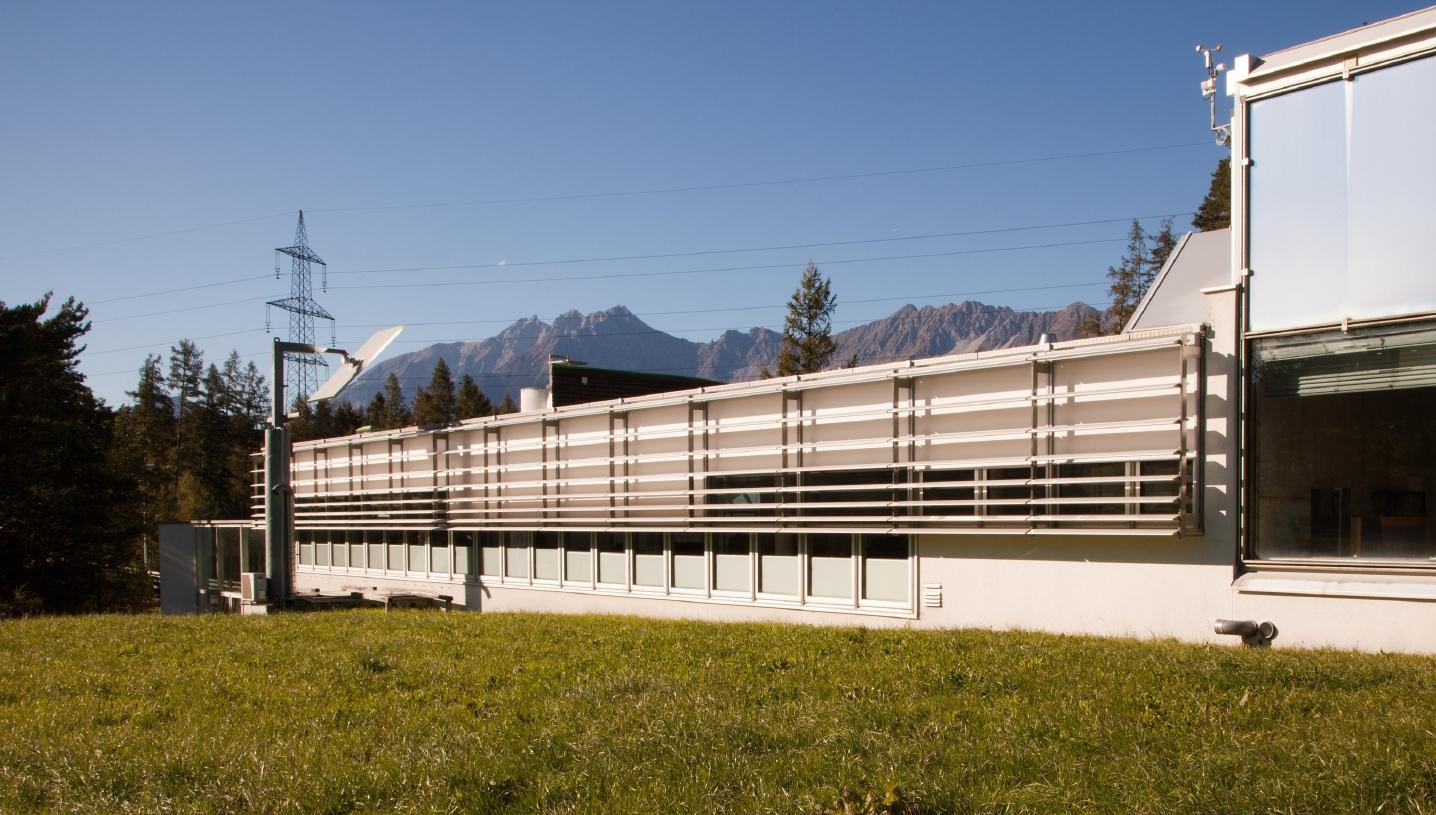
morningto2,200Kintheevening,tosupportthecircadianrhythmofbuildingusers. Additionally,theartificiallightingsystem respondstooccupancythroughpassive infraredsensors(PIR;Thermokon,RDI). Theimplementedswitch-offdelaysareset basedonanindustrystandardof15minutes [19] topreventincorrectsystemshutdowns.Additionally,thenecessaryartificial lightingisreducedbyhorizontalilluminance sensors(Thermokon,LDF1000A)mounted onthedesks,basedontheavailabledaylight.Intheoffice,anormativestandard of500lxaccordingtoEN12464-1isassumedasthetargetvalue.
Tomaximizedaylightusage,theofficefeaturesalargeglazedareaonthesouthern facade.Onaverage,horizontalilluminance levelsofover500lxareachievedatworkstationsbetween9:00AMand4:00PM, resultinginadaylightautonomy(DA)of 81.56%(Figure 3).Topreventglareand overheating,automaticallycontrolledshadingsystemsareinstalledontheexteriorof thesouthernfacadeandtheinteriorofthe northernskylights.Additionally,thebuilding isequippedwithanexternalstaticdaylight system(Figure 2),adaptedtothespecific conditionsandgeographiclocationofthe building.Toensurehighuseracceptance, theautomaticcontroloftheartificialand daylightsystemscanbeoverriddenby usersineachworkzoneviaswitches.
Occupancyinthebuildingishighlydynamic,particularlyduetotheoptionofflexibleworkinghours.Coreworkinghoursin thebuildingaresetfrom9:00AMto12:00 PM,MondaythroughFriday.Additionally, theorganizationalframeworkallowsforremoteworkandflexiblehoursbetween6:00 AMand8:00PM.Tocaptureindividualoccupancybehavior,PIRsensors(NodOn, PIR2-1-01)areinstalledundereachworkstation,withdetectionareaslimitedtothe specificdesk.Thebuildingiscentrallycontrolledbyaprogrammablelogiccontroller (PLC,BECKHOFF,CX5140-0141),which alsologsallsensordataandactuatorsystemstates.Withover100sensorsinthe R&Dbuilding,comprehensivemonitoringof thevisualandthermalsituationindoorsand outdoors,theenergydemand,aswellas userpresenceandabsenceattheirworkstations,isensuredincompliancewith dataprotectionregulations.
Since2019,allsensordatainthebuilding hasbeencollectedinhighresolutionand storedinamachine-readabledataformat (.csv).Continuousdata,suchasfromlightingandenvironmentalqualitysensors,is recordedeveryminute.Status-basedinformation,suchasworkstationoccupancyor windowopeningstates,isrecordedindivid-
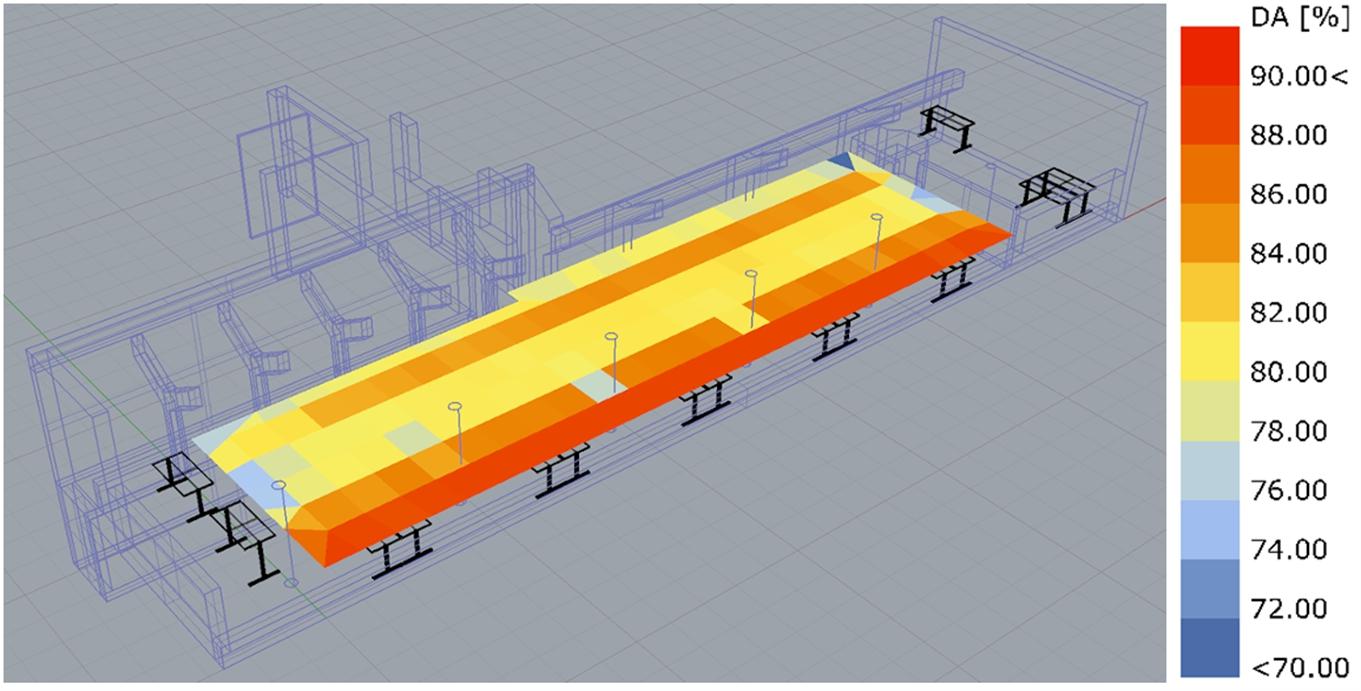
Figure3: Daylightsimulationoftheopen-planoffice,implementedwithRadiance;simulationrelatedtothe normativeminimumilluminanceof500lxaccordingtoEN12464-1;referencetime:8:00-18:00,daylight savingstimenotconsidered,calculatedwithglareprotection.
uallyuponstatuschanges.Thecollected datahasalsobeenmadepartiallyavailable forresearchpurposes [20]
Thestudiesconductedontheexisting discrepanciesbetweensimulatedandactualenergyconsumptioncangenerally bedividedintotwobroadcategories:(1) theevaluationoftheimpactofmodelassumptionsusedontheresultingenergy consumptionestimateofbuildingsimulations,and(2)theanalysisofthefactors thatdetermineactualenergyconsumptionduringoperation.Toachievethemost comprehensiveanalysispossibleinboth aspects,machinelearningmethodsand mathematicaloptimizationmethodswere usedinadditiontoconventionalstatisticalapproaches.Inaddition,bothrealand syntheticdatasetswereused,whichwere partiallygeneratedbysamplingmethods. Thestudiespresentedbelowwerethus abletonotonlysystematicallyincorporate usagebehaviorintotheinvestigations,but alsoquantifytheinfluenceofusercombinationsonbothanindividuallevelandin comparisonwithotherinfluencingfactors.
Ingeneral,energyconsumptionalways resultsfromacausalrelationshiparising fromvariousinfluencingfactorsandtheir implementationincontrolsystems.Theextenttowhichthisinterdependenceaffects theoutcomesofenergysimulations,particularlyconcerningtheoccupancymodel used,wasexaminedina2021study [21] Inthisstudy,thebuilding’senergycon-
sumptionfromSeptember2020toOctober2020wassimulatedusingseveral differentcontrolmethodsforthedaylighting system,incorporatingvariousassumptions regardingglareassessmentandthecorrespondinglimitationofavailabledaylight indoors.Additionally,bothstaticanddynamicoccupancymodelsweresimulated andcomparedwithactualenergyconsumptiondata.Tovalidatetheaccuracy ofthesimulations,anadditionalcomparativesimulationwasconductedusingactual measuredworkplaceoccupancydata.
Theresultsshowedagenerallystrong alignmentwithactualenergyconsumption, withanunderestimationofabout14%due tothehourlyresolutionoftheweatherdata, comparedtotheactualconsumptionof 121kWhwhenusingrealoccupancydata inthesimulation.Althoughthestudyfound thatboththeassumedcontrolmethodand theoccupancymodelhadasignificantimpactonthesimulatedenergyconsumption, theinfluenceoftheoccupancymodels wasnotablyhigher.Moreover,theresultingenergyconsumptionwas,onaverage, underestimatedbyapproximately50%. Thesediscrepanciescanlargelybeexplainedbythehighavailabilityofdaylight, whichinmanycasesshiftstheprimaryuse ofartificiallightingtotheearlymorningand lateafternoon(Figure 4).
Duetotheflexibleworkinghoursofthe employees,occupancyduringthesetimes ishighlyvariable,withsignificantdifferencesinthestartandendtimesofthe workday.Staticoccupancymodelsare inherentlyunabletocapturethesevariations,whichresultfromindividualbehavior enabledbyorganizationalflexibility.Adequatelyaccountingforthisvariabilityin dynamicmodelsalsoproveshighlychallenging.Althoughthedynamicallyassumed
occupancymodelsinthestudyyielded bettersimulationresults,thedeviations fromactualenergyconsumptionwerestill significantlyunderestimated.
Theresultsofthisstudyalreadyhighlight theoverarchingimportanceofmodelassumptionsregardinguserbehaviorinsimulationsforexistingdiscrepanciescompared toactualenergyconsumption.However, despitetheseinsights,thestudydidnot directlyquantifytheimpactofuserbehavior onthebuilding’soverallenergydemand.
Inthecontextofintegrated,sensor-coupled controlapproaches,theenergydemandfor artificiallightingisdeterminedbytwofactors:(1)thecurrentlyavailableamountof daylight,whichissupplementedbyartificial lightingtomeetthenormativeminimum lightinglevelattheworkplace,and(2)the actualuseoftheworkplaceintermsof occupancy.Inmostcases,thepresence andabsenceofindividualusersmustbe consideredcollectively,asgenerallighting
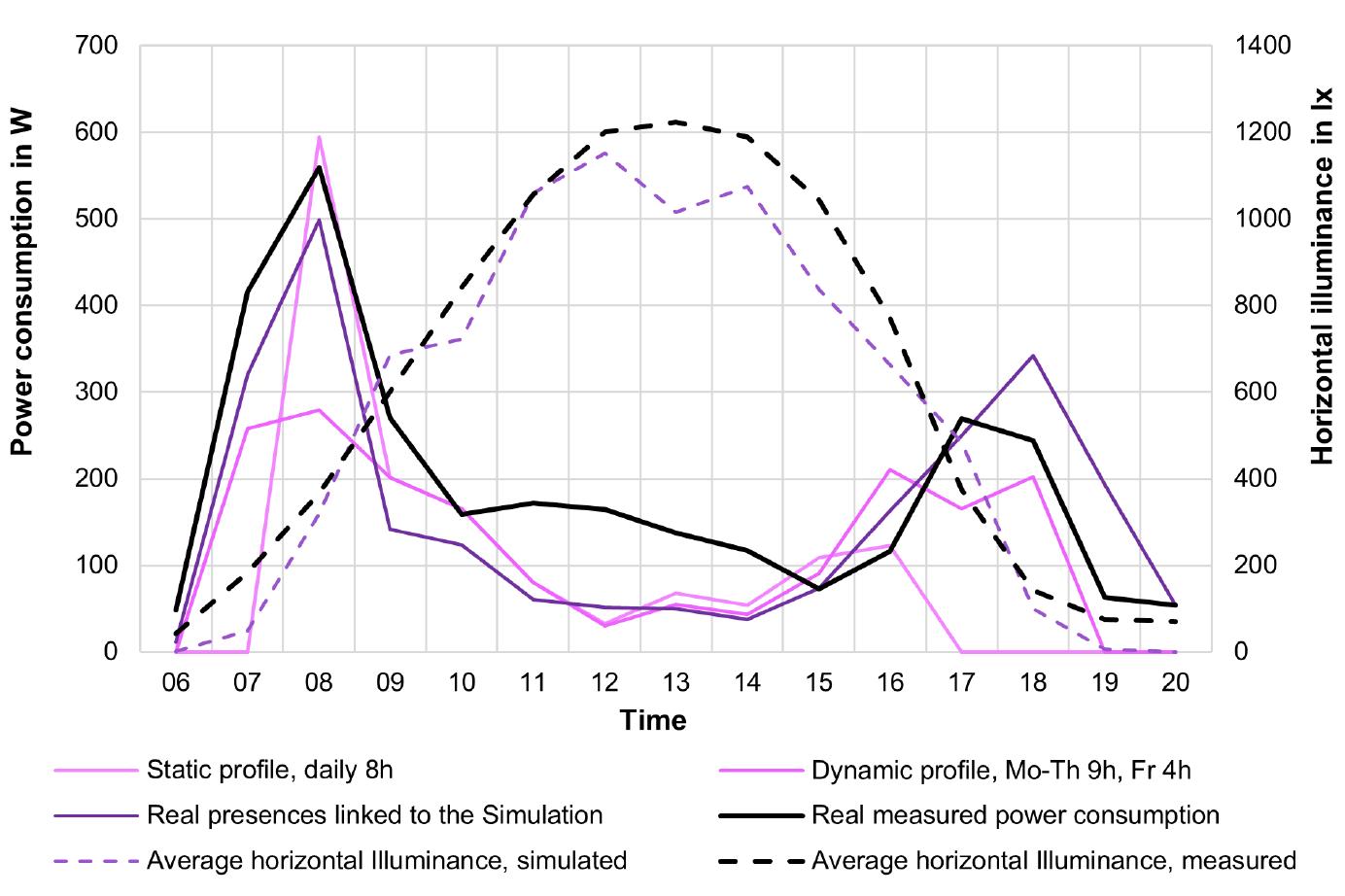
Figure4: Averageenergydemandofdifferentoccupancymodels,supplementedbythesimulatedand measuredilluminanceandtherealenergydemandfromSeptember2020toOctober2020[21].

Figure5: Exemplaryrepresentationofthreerealworkplaceoccupancyprofilesintheopen-planoffice, averageddailyintheperiodfromSeptember2nd,2020,toNovember3rd,2020(yellowgreenish:high occupancy,bluetogrey:lowoccupancy,transparent:nooccupancy).

Table1: Overviewoftheinfluenceofusercombinationandroompositioningontheenergyconsumptionof theartificiallightingsystemintheopen-planofficefortheperiodfromJuly1,2021,toNovember19,2021 [22].
typicallyilluminatesmultipleworkstations simultaneously.Therefore,theenergyefficiencyoftheoverallsystemisdirectly influencedbythealignmentofindividual presencepatternswithintherespective lightingzones(Figure 5).
Whenitcomestofullyquantifyingtheimpactofindividualuserbehaviorontheresultingenergyconsumptionofabuilding, thispresentsasignificantchallenge.Examiningonlyaspecificscenarioofspace utilizationcanleadtosignificantdistortions duetomoreorlesssuitableusercombinations.Thus,itisnecessarytoinvestigate allpossibleusercombinationswithina commonlyusedlightingzonewhilealso accountingfortheirdistributionacrossall availablezonesinordertoobtainacomprehensiverepresentation.However,even forsmallerofficespaces,suchastheR&D officebuildingwith18users,thisleadsto over3x 1029 possiblespatialdistributions ofindividuals.Consequently,solvingthis taskwithinafinitetimeframeisimpossible.
Tostillachieveapotentialquantification oftheimpactofindividualbehavior,a simulation-basedstudyconductedin2022 appliedatwo-stageoptimizationprocess usinggraph-theoreticalalgorithms [22] Realoccupancydatafrombuildingusers betweenJuly2021andNovember2021 werepairedforallcombinationsoftwo users,andthecorrespondingenergyconsumptionwascalculatedbasedonthe daylightavailabilitymeasuredineachzone. Thesedatawerethenoptimizedforboth usercombinationsandzonalassignments forbest-andworst-casescenarios.
Theresultsshowedanincreaseinenergy demandforartificiallightingofapproximately83%fromthebest-casetothe worst-casescenario(Table 1).Forcomparison,theactualenergyconsumption oftheartificiallightingsystemduringthe nearly100-daystudyperiodwasaround 83.8kWh.Sincethevalueswerecalculatedwiththesamesystemconfiguration, thederivedrangereflectsonlyuser-related influences.Thesignificantimpactofindividualbehavioronthetotalenergydemand ofartificiallightinginstallationsisnotonly confirmedbythesefindingsbutalsohighlightswhycurrentsimulationassumptions, whichgenerallyresultinequalenergyconsumptionacrossallscenariosduetoalack ofindividualvariation,areinsufficientfor accuratelyestimatingtheperformanceindicatorsofreal-worldoperations.
Nevertheless,theresultsdonotprovidea sufficientquantificationofuser-relatedinfluencingfactors,astheyareaccompanied bytwosignificantlimitations.Tocircum-
venttheproblemofNP-completeness, theappliedmethodusedatwo-stepoptimizationprocess,therebydecouplingthe alignmentofindividualprofilesfromtheir assignmenttotheworkstationzones.Asa result,theanalysiscouldnolongerensure theoverallminimaandmaximaofenergy consumption,aspotentialinterdependenciesbetweentheindividualassignments maynothavebeensufficientlyconsidered. Furthermore,theevaluationwasbasedon amodificationofuserplacementwithinthe buildingandtheresultingenergyconsumptionoftheoverallsystem.Amutualcomparisonofseveralinfluencingfactorswas notpossibleduetotheappliedmethod, andthustheoverarchingimpactofindividualfactorscouldnotbeproven.Forthese reasons,twocurrentlyunpublishedfollowupstudies [23,24] wereconductedin2024 toaddressbothaspects.
Toovercometheissueofthedecoupled approach,theenergydemandforartificial lightingwassimulatedfordifferentroom occupancyscenariosovertheperiodfrom February2022toJanuary2023,usingreal daylightavailabilityandoccupancyprofiles [23].Toachievearepresentativesample size,atotalof10.24millionsampleswere generatedusingMonteCarlosimulation, eachcomprisingafullyrandomizedvariationofuserpairingsandtheirpositionin theroom.Thenecessarycalculationswere carriedoutontheVSC-5oftheVienna ScientificCluster(AustrianNationalSupercomputingCentre)inmultiplebatches distributedacrossseveralnodes,witheach batchparallelizedandevaluatedon128 CPUcores.Thecalculationofthesamples tookapproximately60,000corehours.
Thecalculatedenergyconsumptionofthe 10.24milliondifferentsamplesshowedan approximatenormaldistribution(Figure 6). Themeanartificiallightingenergydemand wasdeterminedtobe239kWh±12kWh, withthemostenergy-intensivecombinationresultinginanartificiallightingenergy demandof285kWh,andtheminimum determinedtobe183kWh.Theresulting rangebetweentheminimumandmaximum valuesof102kWhessentiallyconfirms thedeviationsderivedfromthetwo-step optimizationprocessonarelativelevel.Interestingly,furtheranalysesshowedthat onlyafewspecificusercombinationswere primarilyresponsiblefortheminimumand maximumenergyranges.Acloserexaminationoftherelevantcombinationsusing anANOVArevealedbothasignificantmain effectregardingoccupancytimes
(p<.001)andaninteractioneffectbetweenprofiletypeandtimeofday(F(14, 120)=1.98,p<.05, ω2=.03).
Combinationswithgenerallyhigheroccupancytimesresultedinhigherenergy demand.Ontheotherhand,Bonferronicorrectedpost-hoctestsindicatedthatthe maindifferencesinresultingconsumption wereattributabletotheearlymorningtime. Towhatextentindividualfactorsordaylightavailabilityareprimarilyresponsiblefor theenergyconsumptionofartificiallightingsystemswasaddressedinthesecond follow-upstudy.
Forthesameperiod,asyntheticdataset wasgeneratedthatincludednotonlyuser combinationsandtheresultingenergyconsumptionbutalsoallotherpotentiallyinfluencingfactors [24].Theseincludedgeneralindicatorsforthetimeofdayandyear, thelocationofthezonewithinthebuilding,aswellaskeyfeaturesrelatedtothe daylightavailability.Bothallcontinuousinputfeaturesandthecorrespondingenergy consumptionasthetargetcriterionwere calculatedbasedonrealdata.Inaddition, comparablefeaturesandtargetvalues werederivedthroughdedicatedbuilding simulationsorassumptions,andfeaturespecificgapswerecalculated.Overall,16 featureswerederived(fourcontinuousvalues,eachbasedontherealsituation,simulationassumption,andresultingfeature gap,plusfourindicatorfeatures),which werecalculatedforallusercombinations
andworkspacezones.Consideringthe monthlyandhourlyresolution,thisresulted ina16x231,336matrix(approximately4 milliondedicatedindividualvalues).
Toanalyzetheinfluenceofeachinputfeatureontheresultingenergyconsumption, regressionanalyseswereconductedusing ahistogram-basedgradientboostingregressiontree.Theoverallfitofthederived modelswasdeterminedusingthecoefficientofdetermination R2,whichdescribes theproportionofvariationinthetestdata thatcanbeexplainedbythederivedregressionmodel.Themodelswerethen interpretedusingSHAP(SHapleyAdditive exPlanations)analysis.
Withan R2 of0.979,themodelingofthe factors’influenceonrealenergyconsumptionprovedhighlyaccurate.Acloseranalysisoftheindividualfeaturecontributions inthemodel(Figure 7)revealedthatthe durationofoccupancyatworkstationshad thegreatestinfluenceontheresultingenergyconsumption,withapositivecorrelation,meaninglongeraveragedurationsled toincreasedenergyconsumption.Other similarlysignificantfeatureswerethesouthnorthlocationofthezoneinthebuilding (whilesouthernzonescontributedtoan increaseinenergyconsumption,northern zonesledtoareduction)andtheduration ofinsufficientlightingattheworkstation (positivecorrelation,meaningincreases inthisdurationledtohigherenergyconsumption).
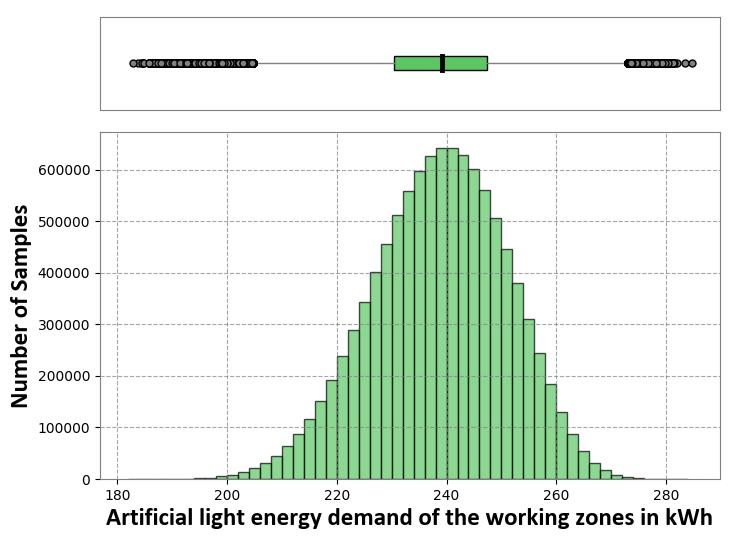
Figure6: Frequencydistributionoftheartificiallightenergydemandcalculatedusinghigh-performance computingforthetimeperiodbetweenFebruary2022toJanuary2023forall10.24millionrandom samples[23].
Moreinteresting,themodelingoftheenergyperformancegapbasedontheindividualfeaturegapsalsoresultedinan R2 of0.952,indicatingthatthedeviationsbetweenthesimulationandtherealsituation couldbealmostfullyexplained.Adetailed analysisofthecontributionsofindividual features(Figure 8)showedthatthemajorityofthediscrepancywasduetodiffering assumptionsaboutoccupancy.Thedifferenceinoccupancytimewasassigned morethanfivetimesthefeatureimportance ofthesecondmostimportantinputfeature.
Mostoftheoccupancymodelsrecommendedintoday’sliteraturehavebeenempiricallyvalidatedandconsistofauniform distributionthroughoutthedaywithvariabilityintheassumeddurationofpresence. However,theresultsofthepresentedstudiesclearlyshowthatthedynamicsofreal presencepatternsareofteninadequately representedbysuchmodels,leadingto significantperformancegaps.Toclose thesegaps,itisnecessarytogivegreater considerationtobothsocio-culturaland workprocess-relatedaspectsinthefuture, astheyhaveproventobetheprimaryfactorsinfluencinguserbehavior.
Althoughdeviationsfromdynamicmodelscangenerallybeinfluencedbyadditionalmodulatorssuchastheaftereffects ofmeetingsorhighdaylightavailability, thesefactorsaredifficulttomodeldueto short-termchanges [21].Theresultsof individualstudiesemphasizetheimportanceoftheconceptofPost-Occupancy Evaluations(POE),whichcanhelpidentifyandassessthestrengthofrelevant modulatorsbasedonreal-worldoperationdata.Long-termstudiesandextensive monitoringapproachesofferinsightsinto workplaceandenergyusagepatterns,as wellaskeyenvironmentalfactors,which canthenbeevaluatedinacontext-specific mannerandusedtoimproveperformance.
Thepotentialaddedvalueaddressedby POEsisalsoconfirmedbytheresults,as extensivebuildingmonitoringisakeyfeatureoftheLivingLabandservedasthe startingpointforthestudiespresented withinthisarticle.Atransparentanalysisof historicaldatahelpstobreakdownexistingperformancegaps.Theunderstanding gainedenablesthedevelopmentofmore accurateoccupancymodelsandsimulations,whichinturncanbetterpredict actualenergyperformanceandultimately reduceperformancegapsinthefuture.
Additionally,dataanalysisofoccupancy patternsanduserinteractionsalsohelps indesigningsystemsthatbetterconsiderlightingtargetssuchasenergyefficiency,visualcomfort,andhealth-effective lightdoses.Furthermore,POEsallowthe derivationofpost-commissioningmeasurestoimproveenergydemand,whichis largelyshapedbytheindividualbehaviorof buildingusers.
However,itshouldbenotedthat,whilethe consolidatedstudyresultsclearlydemonstratethesubstantialinfluenceofindividual userbehaviorontheenergyconsumptionofthebuilding,thisremainsacase study.Personalinfluencesonenergyconsumptionareinherentlytiedtoindividual behavior.Differentbuildingusers,different usagescenarios,oralternativeorganiza-
tionalusesofthebuildingcantherefore leadtodifferentresults.Whilethestudyresultsgenerallyprovidesimilarindicators,it mustbeassumedthatfurthercasestudies withdifferentusagepatternsarenecessary tomakeageneralstatement.
Additionally,itshouldbeconsideredthat thestudiedbuildingbenefitsfromanaboveaverageavailabilityofdaylight.Thisresults inlargeportionsofthedaynotrelyingon artificiallightingtomeetnormativerequirements,leadingtogreatervariabilityinenergyconsumptionduringtheedgesofthe day.Sincetheseperiodstypicallyexperiencehigherfluctuationsinoccupancy times,itispossiblethattheinfluenceof occupancybehaviorhasbeenoverestimatedinthepresentedresults.Whether thisoverestimationexistsandtowhatextentitmanifestswouldrequirecomparative studies,whicharecurrentlynotavailable.
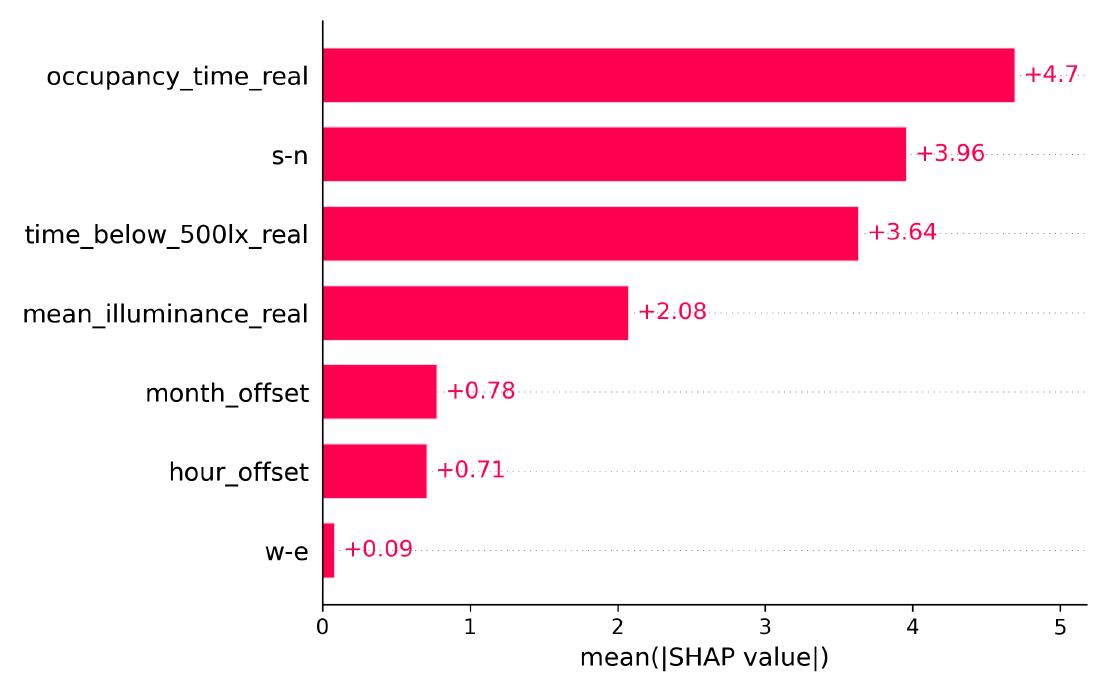
Figure7: ResultsoftheSHAPanalysisfortheexplanatoryvalueoftheindividualfeaturegapsonthereal energyconsumptionbetweenFebruary2022toJanuary2023[24].

Figure8: ResultsoftheSHAPanalysisfortheexplanatoryvalueoftheindividualfeaturegapsontheenergy performancegapbetweenFebruary2022toJanuary2023[24].
Inlightofcurrentclimateandenvironmental policydiscussions,improvingtheenergy efficiencyofbuildingshasbecomecrucial forachievingincreasinglyimportantsocietal goals.Thelightingsector,asoneofthe largestconsumersofelectricityinbuildings, canmakesignificantcontributionsinthis regard.
However,therealizationofthispotentialis currentlyhinderedbyinaccuraciesinboth theplanningprocessandenergysimulations.Userbehavior,whichisinfluencedby individualaswellasorganizationalandsocialconditions,canbeconsideredacentral factor,asitsimpactsignificantlyaffectsthe qualitativeaspectsofrequirementsresultingfromplanningprocesses.Asaresult, notonlyaretheresignificantdeviations fromthepredictedenergyconsumption, butthereisalsoariskofincorrectsystem sizing,erroneousspecificationofrequirements,orineffectivedefinitionofcontrol strategies.
Accordingly,improvingthemethodsand modelscurrentlyinuseisessential,particularlywithregardtotheplanningofartificial lightingcontrolsystems.However,itisimportanttounderstandthatthischallenge notonlyconcernstheeffectsofuserbehavioronbuildingperformancebutalso theunderstandingofuserbehavioritself.It remainsuncleartowhatextentuserbehavioristrulydeterminedbyindividualfactors, orwhetherculturalororganizationalinfluencessignificantlylimitindividuality.
Thepresentfirstpartofthistwo-partarticle seriesfocusedprimarilyonstudiesillustratingandquantifyingthecurrentissue. Therearecurrentlyvariousapproachesto improvingusermodels.Inparticular,advancedapproachesthatusedata-intensive modelingtechniques,suchasmachine learningalgorithms,aregainingincreasing importanceinthisarea.However,theavailabilityofrelevantdataremainssignificantly limited,asdatacollectioniscomplex,and performanceevaluationsofbuildingsafteroccupancyarestillrarelyconducted, despitetheirpotentialtoeffectivelyutilize existingopportunities.Themainreasons forthisareoftenthecostandresourceintensityassociatedwithadjustingcontrol systemsduringoperation.
Nonetheless,pursuingapproachestoaddressthecurrentproblemcanbeworthwhileandcanbeeffectivelyfollowedeven atreducedcomplexitylevels,aswewillillustrateinthenextissueinthesecondand finalpartofthisarticleseriesonoptimizing lightingenergyefficiency. ■
Thepresentedstudyresultswerepartially fundedbytheAustrianResearchPromotionAgency(FFG)aspartofseveralframeworkprogramsandresearchprojects.
[1] IEA(2023).TrackingCleanEnergyProgress2023. InternationalEnergyAgency,Paris. https://www.iea. org/reports/tracking-clean-energy-progress-2023 Licence:CCBY4.0.
[2] Dubois,M.C.&Blomsterberg,Å.(2011).Energy savingpotentialandstrategiesforelectriclightingin futureNorthEuropean,lowenergyofficebuildings:A literaturereview.Energyandbuildings,43(10),25722582.
[3] Liang,J.,Qiu,Y.&Hu,M.(2019).Mindtheenergy performancegap:Evidencefromgreencommercial buildings.Resources,ConservationandRecycling, 141,364-377.
[4] Calì,D.,Osterhage,T.,Streblow,R.&Müller,D. (2016).EnergyperformancegapinrefurbishedGermandwellings:Lessonlearnedfromafieldtest. Energyandbuildings,127,1146-1158.
[5] Cozza,S.,Chambers,J.,Brambilla,A.&Patel,M. K.(2021).Insearchofoptimalconsumption:Areview ofcausesandsolutionstotheEnergyPerformance Gapinresidentialbuildings.EnergyandBuildings, 249,111253.
[6] Zou,P.X.,Wagle,D.&Alam,M.(2019).Strategies forminimizingbuildingenergyperformancegaps betweenthedesignintendandthereality.Energyand Buildings,191,31-41.
[7] DeWilde,P.(2014).Thegapbetweenpredicted andmeasuredenergyperformanceofbuildings:A frameworkforinvestigation.Automationinconstruction,41,40-49.
[8] Menezes,A.C.,Cripps,A.,Bouchlaghem,D.& Buswell,R.(2012).Predictedvs.actualenergy performanceofnon-domesticbuildings:Usingpostoccupancyevaluationdatatoreducetheperformancegap.Appliedenergy,97,355-364.
[9] Erba,S.,Causone,F.&Armani,R.(2017).Theeffectofweatherdatasetsonbuildingenergysimulation outputs.EnergyProcedia,134,545-554.
[10] Barthelmes,V.M.,Becchio,C.&Corgnati,S.P. (2016).Occupantbehaviorlifestylesinaresidential nearlyzeroenergybuilding:Effectonenergyuseand thermalcomfort.ScienceandTechnologyfortheBuilt Environment,22(7),960-975.
[11] Yoshino,H.,Hong,T.&Nord,N.(2017).IEAEBC annex53:Totalenergyuseinbuildings—Analysis andevaluationmethods.EnergyandBuildings,152, 124-136.
[12] Wang,C.,Yan,D.&Ren,X.(2016).Modelingindividual’slightswitchingbehaviortounderstandlighting energyuseofofficebuilding.EnergyProcedia,88, 781-787.
[13] Zhou,X.,Yan,D.,Hong,T.&Ren,X.(2015).Data analysisandstochasticmodelingoflightingenergy useinlargeofficebuildingsinChina.Energyand Buildings,86,275-287.
[14] Panko,R.R.&Kinney,S.T.(1995,January). Meetingprofiles:Size,duration,andlocation.In ProceedingsoftheTwenty-EighthAnnualHawaii InternationalConferenceonSystemSciences(Vol.4, pp.1002-1011).IEEE.
[15] Haldi,F.,Calì,D.,Andersen,R.K.,Wesseling,M. &Müller,D.(2017).Modellingdiversityinbuilding occupantbehaviour:anovelstatisticalapproach. JournalofBuildingPerformanceSimulation,10(5-6), 527-544.
[16] Yılmaz,D.,Tanyer,A.M.&Toker,I.D.(2023). Adata-drivenenergyperformancegapprediction modelusingmachinelearning.Renewableand SustainableEnergyReviews,181,113318.
[17] Weninger,J.&Hammes,S.(2024,September). Post-OccupancyderivedUserProfilesforimproved EnergeticandLightDoserelatedBuildingSimulation. InProceedingsofthe30thSessionoftheCIE(CIE x50:2023,pp.184-195).CIE.
[19] Nagy,Z.,Yong,F.Y.&Schlueter,A.(2016).Occupantcenteredlightingcontrol:Auserstudyon balancingcomfort,acceptance,andenergyconsumption.Energyandbuildings,126,310-322.
[20] Hammes,S.&Weninger,J.(2023).Measurement dataonthewindowopeningbehaviorandclimate inastronglydaylitofficebuilding.DatainBrief,46, 108794.
[21] Hammes,S.,Hauer,M.,Geisler-Moroder,D., Weninger,J.,Pfluger,R.&Pohl,W.(2021,September).Theimpactofoccupancypatternsonartificial lightenergydemand-simulationandpost-occupancyevaluation.InBuildingSimulation2021(Vol.17,pp. 3536-3543).IBPSA.
[22] Hammes,S.,Weninger,J.,Pfluger,R.&Pohl,W. (2022).Taketherightseat:theinfluenceofoccupancyschemesonperformanceindicatorsoflighting inopenplanoffices.Energies,15(9),3378.
[23] Hammes,S.,Weninger,J.,Gschwandtner,P.& Zech,P.(2024).Achievingadeeperunderstanding ofuser-relatedinfluencesonartificiallightingenergy demandusingHigh-PerformanceComputing.BuildingSimulationApplicationsBSA2024.Currentlyin publication.
[24] Weninger,J.&Hammes,S.(2024).Behavioral AspectsofrealandsimulatedEnergyConsumption ofArtificialLightingSystemsinOfficeBuildings.Ybl JournalofBuiltEnvironment.Currentlyinpublication.
[18] Hammes,S.,Weninger,J.,Canazei,M.,Pfluger, R.&Pohl,W.(2020).DieBedeutungvonNutzerzentrierunginautomatisiertenBeleuchtungssystemen. Bauphysik,42(5),209-217.

Dipl.-Ing.JohannesWeninger (left)studiedarchitectureattheLeopold-FranzensUniversityofInnsbruckwithfocusonarchitecturaltheoryandworkedasanexternal lecturerandresearchassociateatvarious universitiesinAustriaandGermanyinthe fieldofArtificialIntelligenceandCyberphysicalSystems.Until2018hewasa researchassociateattheKarl-FranzensUniversityGrazintheDepartmentofBiologicalPsychology.Since2016hehas beenworkingatBartenbachresearchon thetopicsofnon-visuallighteffects,digitizationandmachinelearning.Hehas headedBartenbach’sresearchteamsince 2022.
Afterstudyingelectricalengineering, Dr.techn.SaschaHammes,M.Sc. (right)workedasaspecialistplannerfor electricalbuildingequipmentandinthe researchanddevelopmentdepartmentof Bartenbach.Aspartofanindustry-related dissertationonuser-centeredlightingand thepotentialofpost-occupancyevaluations,hecompletedhisdoctorateatthe UniversityofInnsbruck,wherehehas alsobeenemployedasapost-doctoral researchersince2022.Heisparticularly involvedinresearchprojectsintheareas ofbuildingautomationsystems,especially user-centeredsystems,sensortechnology, anddataanalysis.
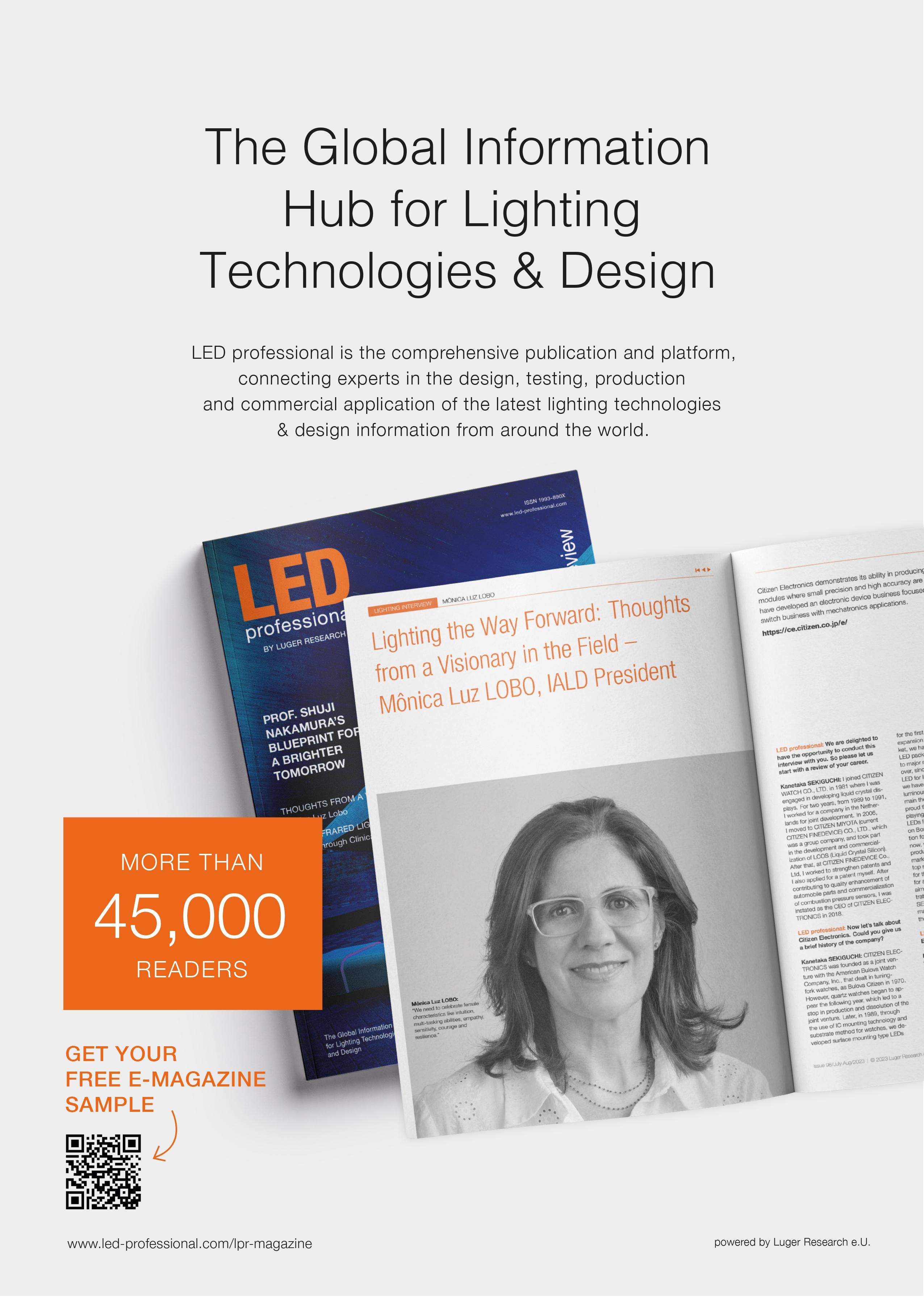
OmidJAVANMARDI,DesignEngineeratLukeRobertsLightingand AlexFISCHER,ProductManagerandCo-FounderatSimScale
Ateamoftechanddesignenthusiasts introducedthe“Luvo,”aMatrixLED lampthatletsuserscontrolthelight’s directionandadjustbrightnessand colordynamicallythroughafewtaps ontheiriOSandAndroidapp.This patentedtechnologyenablesindependentcontrolofthelamp’supperand lowerLEDs,allowingforcustomizable lightingwhetheroveradiningtable,a readingcouch,orforambientrelaxation.Thelampalsolearnstheuser’s lightingpreferencesandautomaticallyadjuststopreferredsettingsfor maximumconvenience.Engineering simulationusingcloud-nativetechnologywasextensivelyusedinthedesign ofthenewlamp.
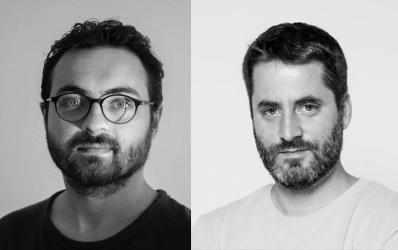
OmidJavanmardi,DesignEngineeratLuke RobertsLightingsince2018.Omidisthelead mechanicalengineerandthermalanalysisspecialistatLukeRobertsLightingandwasalsothe productionmanagerfortheLuvopendantlamp. LukeRoberts(shortLR),foundedin2014in Vienna,isaninnovativesmartlightingcompany thatcombinesadvancedtechnologywithmoderndesigntoimprovethelightingexperiencein homesandoffices. (left)
AlexFischer,ProductManagerandCoFounderatSimScaleWithabackgroundin computationalmechanicsandcontroltechnology,AlexFischerhasworkedfortenyearsina rangeofproductandengineeringroles,building afullycloudandweb-basedsimulationplatform. Heisaco-founderofSimScaleandleadsthe company’sthermalmanagementandelectronics solutions. (right)
TheLuvopendantlampwasdeveloped usingafullycloud-nativedesignstack includingOnshapeandSimScale.With Luvo,usersnolongerjustturnthelight onandoff.Theusercandecideexactly whereitshouldshine,howbright,warm, orcolorful.Thisbringsultimateflexibilityto lightingandtherightlightforeverymood andspace.TheLuvolamps’mainfunctionisasmartLEDlampwithover300 multi-coloredLEDsgiving4400lumensat acolortemperatureof2700-4000Kelvin thatdirectslightinanydirection.

Luvopendantlampwithintegratedsensorsand AI-poweredlearningfeaturestoenhanceuser experience.
andCFDSimulationofHeatSink DesignsintheLuvoLEDLamp Byleveragingadvancedsimulationtools, LRevaluatedimprovementsinLEDperformanceandlongevitythroughoptimized heatsinkdesigns,emphasizingtheimportanceofeffectivethermalmanagementin LEDlamps.
Theteamemployedthermalanalysisand computationalfluiddynamics(CFD)simulationtoevaluatetheperformanceoftwo heatsinkdesignsindissipatingheatfrom theLuvopendantlamp.Thetwodesigns
includedaheatsinkwithstraightfinsand aheatsinkwithaspiralfinlayout,both madefromdie-castaluminum.Thesimulationsetupincorporated84LEDsasaheat sourcewithatotalheatloadof40watts. Theobjectivewastocomparetheeffectivenessoftheseheatsinksinreducingthe temperaturewithintheLEDlamp,whichis crucialformaintainingefficiency,extending operationallifetime,andpreventingpotentialfailure.Theperformanceandlongevity ofLEDsarehighlydependentoneffective thermalmanagement.Inadequateheat dissipationcanleadtoincreasedjunction temperatures,reducedefficiencyandlifespan,andpotentiallyleadtofailure.
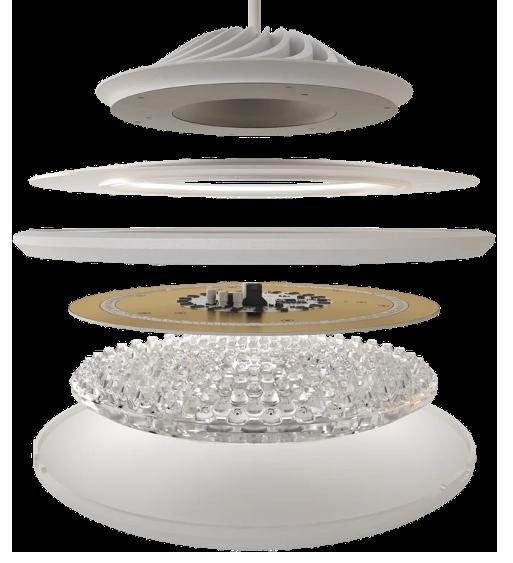
ExplodedviewoftheLuvopendantlampshowingitscomponentparts.
Twoheatsinkdesignswereconsidered:
• DesignOption1:Straightfins
• DesignOption2:Spiralfinslayout
Bothproprietarydesignsareconstructed fromaluminum,amaterialwithexcellent thermalconductivity.Thecomparisonaims todeterminewhichdesigndissipatesheat moreeffectivelythroughnaturalconvection. TheCFDsimulationsareperformedusing
SimScale,acloud-basedengineeringsimulationplatform.Thesetupincludes:
• HeatSource:84LEDsgeneratingatotal heatloadof40watts.
• BoundaryConditions:Naturalconvectioninanambientenvironment.
• MaterialProperties:Aluminumforthe heatsinks.
Thesimulationsareusedtogenerateinsightsintothetemperaturedistributionand heatdissipationratesinsidetheLEDlamp. LRcoulddeterminethebetterdesignwith thesesimulationresults:
• HeatDissipationEfficiency—thespiralfinlayoutenhancesairflowaround theheatsink,promotingbetternaturalconvectioncomparedtothestraight fins.Theimproveddesignleadstomore efficientheatdissipation,preventingexcessivetemperaturebuildupwithinthe LEDlamp.
• TemperatureDistribution—thethermal analysisrevealsthatthespiralfindesign maintainsatemperatureof2degrees Celsiuslowerthanthestraightfindesign underthesameloadconditions.This temperaturedifferenceissignificantfor LEDperformanceandlongevity.
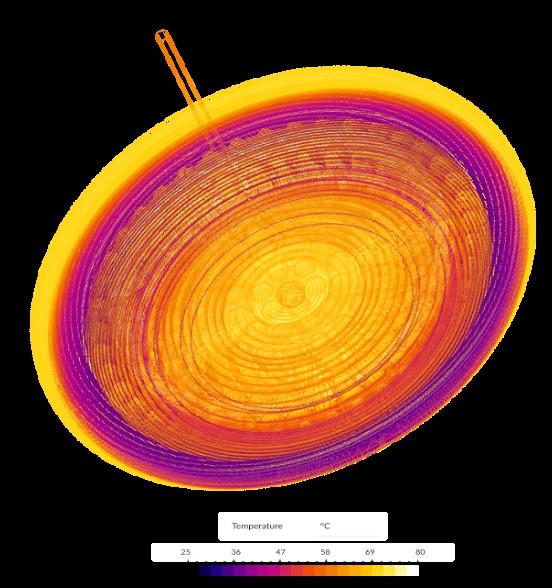
Luvopendantlampheattransfersimulationusing SimScale.
Thereducedtemperatureachievedbythe spiralheatsinkdesignensuresamore reliableoperationoftheLEDs.Lowertemperaturescorrelatewithhigherefficiency, alongerlifespan,andareducedriskof thermal-inducedfailures.Thealuminum materialisfurtherevaluatedusingtheextensivematerialslibraryavailableinmodern simulationtoolstoconsideralternatives. Reducingtheoverallweightandamount ofaluminumusedisimportantforcostefficiencyandalsotheembodiedcarbon intheproduct,somethinglightingmanufacturersincludingLRareincreasingly consciousof.
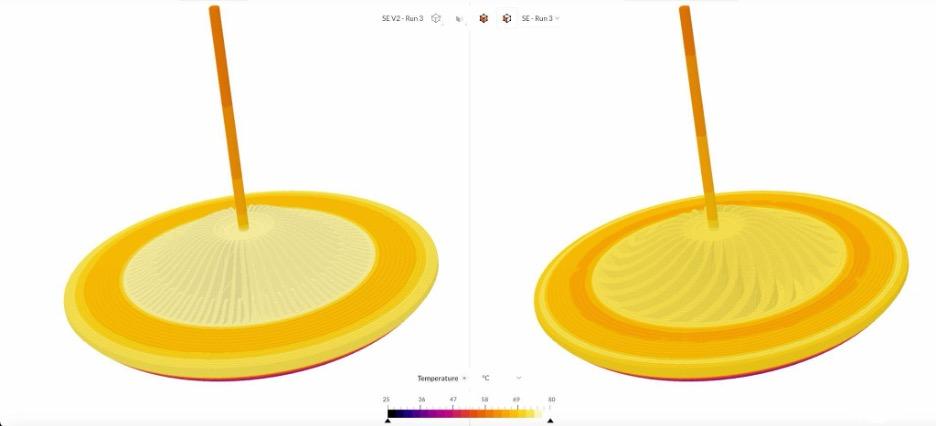
Straightheatsink(left)andspiralheatsinkdesign(right).

Temperaturevisualizationofthestraightheatsinkdesign(left)andmarginalimprovementwiththespiral heatsink(right).
Usingsimulation,theteamsavedmonths inthedesignanddevelopmentworkflow -fromconceptoverprototyping,testing, redesign,andretesting.Thecorresponding costsavingcanbethousandsofEurosfor eachofthedesignoptionsforaproduct indevelopment.Thecumulativesavings forawholeproductpipelinearesignificant.Muchofthesavingscomefromnot havingtoprototypeeveryiterationordoa thermaltest.Designengineerscansimply refinetheCADdesignandsimulateit.In thiscasethedesignteamatLRregularly simulatedtendesignsinparallelwhichwas possibleusingfullycloud-nativesimulation tools. ■
Formoreinformationvisitthefollowing websites:
www.luke-roberts.com
www.simscale.com
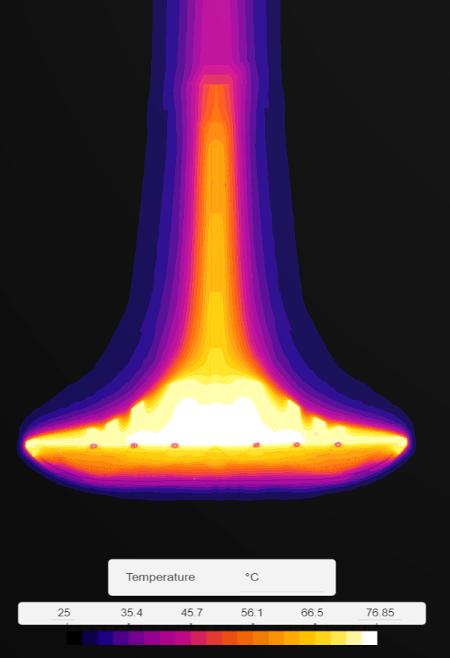
TimKÖBEL1,2,M.Sc.,MasterThesisatKarlsruheInstituteof Technology(KIT)
Theaimofthisprojectwastodevelopanapplicationthatenablesthe retrievalofmusicmetadatafroma serverandusesittocontrolvarious dynamiclighteffectsonanLEDpanel, featuringa3Dlighteffectandopen APIwithlowlatency.AwebapplicationexecutableonAndroidandWindowsoperatingsystemswaschosen asthefoundation.Toachievethis,a RepresentationalStateTransfer(REST) APIwasimplementedforcommunicationandabinarysearchalgorithmfor dataprocessing.Additionally,aWebRTCpeer-to-peerconnectionwas integratedforreal-timeaudiodata transmission.Thecontrolismanaged throughacustom-developeduserinterface.
Theopenarchitectureandconfigurablesettingswithintheapplication ensurethatitispreparedforfuture expansionsandadaptations.Thisprovidesabasisforfurtherresearchand developmentintheareaofparametric controloflightingeffects.Futurework couldintegrateadvancedalgorithms orAIforpatternrecognitionintothe backendservers,allowingtheapplicationtoextenditsusebeyondmusic recognition.
Dynamiclightingeffectsplayacentralrole inmusicalperformances,nolongerserving solelyforilluminationbutvisuallyenhancing themusic.Toenablesuchlightingeffects outsideoflargestages,technicalsolutions thatreacttomusicalreadyexist.Another keydevelopmentinrecentyearsistheadvancementofdataprocessing,whichnow includestheuseofcomplexalgorithms andartificialintelligence.Thisallowsforthe recognitionofmusicbyalgorithmsandits evaluationbasedonvariouscriteriabyAI.
Thecombinationoflightingeffectswith algorithmicpatternrecognitionandthe analyticalcapabilitiesofAIenablestheimplementationoflightshowswheredifferent effectsareautomaticallychangeddependingonthesong,artist,ormusicmetadata. Thiswouldallowforautomatedcontrol ofthelightshowanditseffects,reducing personnelrequirementsforlargeperformances.Additionally,customizablelight showswouldbecomemoreaccessibleto smallerartistsorforpersonaluse.
Torealizethisconcept,anapplicationwas developedthatenablesreal-timecommunicationbetweenthelightfixtureandthe correspondingbackendserverfordata processing.Theapplicationretrievesrelevantmusicmetadata,processesit,and thencontrolsthelightfixtureaccordingto theeffectspredefinedintheapplication.
Theadaptationandcontroloflightingto musicisalreadyafeatureofmanyapplicationstoday.Oneofthemostwell-known systemsforcontrollinglightsinprivate householdsisthecombinationof“Philips Hue+Spotify”from“Signify”and“SpotifyAB.”Thissystemadjuststhelighting tothebeatofthemusic,allowingusersto freelymodifythelightingambianceandthe intensityoftheeffect.However,thisrequiresbotha“PhilipsHue”anda“Spotify” account [1].Usingtheopen-sourcesoftware“WLED”byChristianSchwinne [2], itisalsopossibletocreatesimilarlighting effectswithoutneedingsuchanaccount. “WLED”formsthefoundationofthe“lixl” firmwareandsupportsvariouslightingeffectsthatreacttofrequenciesorvolume changes [3].Itservesasarepresentative ofmanyotherapplicationsandlightingsystemsthatrespondtovolume,frequency, andbeatsperminute(bpm).
Therearealsosuchapplicationsforcomputers.Intheprofessionalfield,“Madrix” by“inoageGmbH”isanotableexample. Thissoftwaresupports“SoundtoLight” (S2L)effectsandallowstheconversion ofdifferentfrequenciesandvolumesinto lightingeffects [4].However,thespecific effectmustbeselectedbytheuserand thenreactstothemusic,whichapplies equallytoallplatforms.Thesameprincipleistrueforthe“SignalRGB”application, thoughitisdesignedforprivateusers [5], unlike“Madrix.”
Themaster’sthesiswassupervisedby ProfessorDr.Neumann,andDr.Chris Herboldwastheadvisor.
1 KarlsruheInstituteofTechnology(KIT), Gebäude30.34,Engesserstraße13,76131 Karlsruhe,Germany
2 udvvw@student.kit.edu
Theplatformforthewebapplicationrequiresbothanetworkconnectionand amicrophoneforaudiodatatransmission.ThelightfixtureusedisanLEDpanel, whereseveralLEDstripsarearrangedbehindaspecialfabric.Thefabriccreatesa three-dimensionaleffect,wherethelight fromtheLEDpointstransitionsintocurves. Thenameoftheselightsis“lixl”,asshown in Figure 1.Theeffectsofthelightscanbe controlledviatheapplication,depending onthemusictrack.
Aspartofthiswork,themusic-reactive effectswillbeexpanded.Theaimwasto developacontrolsystemthatenablesthe automaticexchangeofeffectsandtheir adaptationtocorrespondingmetadata, withoutrequiringmanualintervention.This willbeachievedthroughtheuseofAIoran algorithm.Asaconsequence,nohuman interventionwouldberequiredinthecontroloftheeffects.
Figure 2 showstheschematicstructureof allkeyfunctions.TheCOREservesasthe storageforglobalvariables.Itisnotdirectly accessiblethroughtheUIbutonlythrough thecorrespondingfunctionsandtheirUI elements.Alargeportionofthefunctions buildononeanother.The“LightingAPI” andthe“MusicRecognitionAPI”formthe foundationforthemainpartoftheapplication.“
TheUIdesignisbasedonthreefundamentalprinciples:theKISS(KeepItSimple andStupid)principle [6],theISOstandard 9241-110fortheergonomicsofhumansysteminteraction [7],andtheUIdesignof thewebinterfacefor“lixl”lights.
TheKISSprincipleisappliedinthemenu structureshownin Figure 3.Itisdesigned toensureeaseofuseandincludesthe followingitems:“MusictoLight,”“Music RecognitionAPI,”and“LightingAPI.”The namesofthemenuitemscorrespondto theapplication’ssettingsoptions.Additionally,therelevantconditionsoftheISO standard9241-110havebeentakeninto account,contributingtoaclearmenunavigationandcounteractingthecomplexityof theapplication.
Theapplicationwasprimarilydevelopedfor usewith“lixl”lights,withafocusoncreatinganAPIconnectionthatisasopenas possibletoenableintegrationwithother systems.However,theadditionaleffortrequiredforenteringAPIcommandsposesa disadvantage.Toaddressthis,suggestions forthestandardbodyofthe“lixl”APIhave alreadybeenincorporated.Theoretically,it ispossibletocontrolavanory“Estelle”or PhilipsHuelightwiththeAPI.
Thesubsections“LightingAPIsettings” and“Brightnessandcolorsettings”are solelyforinputtingthecorrespondingAPI body.Additionally,inthe“LightingAPI Settings”subsection,thereisabutton thatsendsatestAPIcall.Thisallowsthe connectiontobetestedimmediatelyafter input,andanyerrorsintheAPIcallcan becorrected.Inthe“Brightnessandcolor settings,”suchabuttonisomitted,asthe relevantfunctionscanalreadybetriggered andverifiedindependentlythroughthebuttonsinthe“MusictoLight”menu.

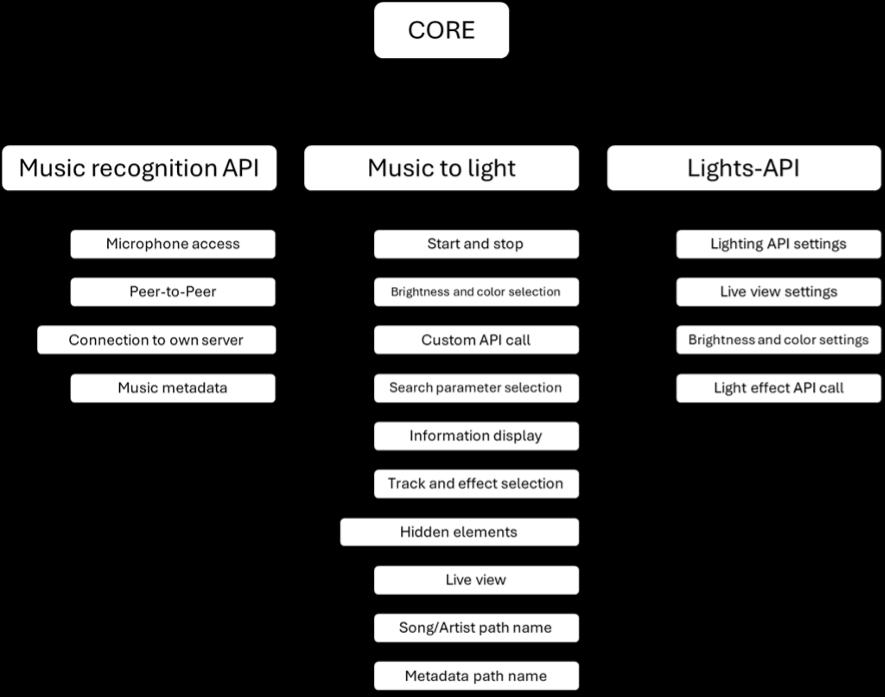

Ifareal-timeviewofthelightisrequired ordesired,the“liveview”functioncanbe activated.However,thisrequiresaseparateAPIcall.Ifthefunctionisnotusedor notsupportedbythelight,itcansimplybe turnedoff.Thebottomsection,“Effect,”is alistthatstorestheJSONcommandsfor triggeringtheeffects.Theelementsofthe listareunordered,asthecommandsdo notfollowasortablestructure.Theseare simplycommandsthatareexecutedbythe correspondinglight.Additionally,eachelementinthelistcanbedeletedindividually, enhancingeaseofuse.
ThissectionaddressestheAPIformusic recognitionandthecorrespondingservers. Theapplicationisdesignedtobeusedwith itsownAIoralgorithm.Itwouldhavebeen possibletotailoreverythingtoaspecificAI oralgorithm,butthatwouldlimittheuser’s options.InadditiontoprovidingtheAPI URLforqueryingtheserver,theusermust specifythestoragelocationfortherelevant information.Thisisdefinedinthesection “ConnectingtoownServers.”Anindividual identificationtokencanalsobeaddedto theAPIcallhere.
Inthiscontext,thequestionarisesasto howthecorrespondingservergainsaccesstotheaudiodataforanalysis.The transmissionofaudiodataisdonethrough apeer-to-peerconnection.Tolaunchthe applicationonanAndroidsmartphone, microphoneaccessmustfirstbegranted. Onceconfirmed,themicrophoneisrechecked, andtheaudiosignalisplayedthroughthe speakers.Thisfeatureisalsoavailablein thePCversion,wherethePCprimarily servesasareceiverforthepeer-to-peer connection.Accesstoalltransmittedaudio dataishandledviathecomputer’sstandardoutputsystem.Thisallowsforthe creationofaserveronthePCwiththecorrespondingalgorithmorAIbycapturingthe standardaudiooutputsignal.
Theadvantageofthepeer-to-peerconnectionisthepossibilityofaserverless connection.Thiscansaveservercosts andensureindependencefromthirdparties.Inthefinalmenuitem,titled“Music metadata,”userscanconfiguresettings formusicmetadata.Here,thereistheoptiontointegrateanonlinedatabaseoftheir choicetoretrieveadditionalinformation aboutanartistortheirsong.
“Musictolight”isthehomescreenofthe application.Usingthe“Start”and“Stop” buttons,theapplicationcanbelaunchedin thebackground.Iftheoption“Connecting CustomServers”hasbeenselectedand configuredinthe“MusicrecognitionAPI” menu,requestsarenowautomaticallysent toaserveratregularintervals,whichanalyzestheaudiodata.Theserequestssent fromtheapplicationtotheserverinclude, forexample,thesongtitleandartistname. Thedrawbackofthispollingmethodisthat requestsaresenttotheserverrepeatedly overauser-definedperiod.Processing theserequestsrequirescorresponding computationalresourcesfromtheserver. However,theusercansetthetimeinter-
valinsuchawaythattherequestsdonot overloadthesystem.Anadvantageisthe easeofswitchingandreplacingservers.
Thefunctionsforadjustingbrightnessand colorselectiondifferinthattheAPIcallfor changingbrightnessissentwiththemovementoftheslider.Forcolorselection,this isnotthecase.Instead,colorsarefirst mixedusingtheRGBsliders.Whenanumberisclicked,thebuttonwillappearinthe selectedcolor,andapreviewofthecolor isdisplayed.Thecolorcanthenbesent viathebuttons,anduptothreeRGBcolor spacescanbetransmitted.Thisisthe maximumnumberthatcanbeprocessed bythe“lixl”softwareasanAPIcall.
BelowtheRGBslidersisanadditional functionthatallowstheusertosenda custombody.Thismakesitpossibleto sendAPIcallsthatarenotcoveredbythe app.
Next,thesearchparameterisselected. Thecriteriathatchangethelightingeffects aresetbychoosingasongtitleorartist. Ifmetadataanalysisisactivated,these canalsobeselected.Informationsuch astheartist’snameandsongtitlecanbe displayedintheinformationview.
Forthemainfunctionoftheapplication, thesearchparameterdataisstoredina list.Here,aneffectcanbeassignedtothe songtitleparameter.Whenthealgorithm orAIrecognizesthesong,theapplication queriesitandtriggersthecorresponding effect.TheAPIcall,alongwiththecorrespondingbody,issenttothelight.The aforementionedinformationviewserves asanerrorcheck.Ifthedisplayedsong titleisnotavailable,thisisindicatedinthe informationview,andthequeryiscanceled.Theusercanthenaddthemissing title.Sincethelistcontainssearchparameterssuchassongtitlesorartistnames,it makessensetosortit.Thisprovidesbetter clarityandallowstheuseofabinarysearch algorithm [8]
Thehiddenelementsarefunctionsonly neededondemand,suchasthe“liveview” feature.Song/artistpathandmetadata pathsettingsareusedtodefinethepath fortherelevantinformation.Sinceeach interfacediffersinhowittransmitsinformation,theusercanchooseacustompath toaccessthedesireddata.However,this requirestheusertobefamiliarwiththecorrespondinginterfaces.
Toensuretheproperfunctioningoftheapplication,acomprehensiveevaluationand analysisoftheapplicationdelayandstabilityoftheappisconducted.Application delayreferstothelatencythatexistsbetweenmusicrecognitionandthecontrolof thelighting.
Toconductbothtests,adatabaseof95 randomlyselectedsongsiscreated.The individualsongsdifferintermsofsound qualityandduration.Forthetestscenario, itisassumedthatthecorrespondingserver isoperatedbyaprivateuserathome.Regardingthetotaldurationofthemusic,itis notedthatitamountsto5.34hours,which issignificantlyabovetheaveragemusic consumptionof2.11hoursforpurchased musicdata/physicalmedia,asoutlinedin the“MusikindustrieinZahlen”studybythe BundesverbandesMusikindustrieeV.from 2023 [9].Forthepurposesofthiswork,it issimplisticallyassumedthatallmusicdata fromthevariousmediaarealsoavailable asMP3filesandcanbeusedtocreatea musicfingerprint.Streamingservicesare notconsideredhere,asthefilemustbe physicallypresenttocreateafingerprint.
Toavoiderrorsduetothenetwork,thecorrespondingdevicesarepingedbeforethe twoteststoensureerror-freedatatransportandtodetermineanyexistingnetwork latencies.Networklatencyreferstothe timetakenforthetransportofindividual datapacketsbetweensenderandreceiver. Thisinformationisnecessaryforthelater evaluationoflatencymeasurements.
Thepresenttestisdesignedtoevaluate thestabilityoftheapplicationinconnectionwiththemusicrecognitionalgorithm andthelightingAPI.Tothisend,aserveris usedthathandlesboththemusicrecognitionandthequeryingofmusicdata.Additionally,itactsastheAPIinterfaceforthe light.AreallightcontrolledviatheAPIis notused.Iftherewereanerrorinsucha lightortheAPI,itwouldnotbepossibleto determinewhethertheerrorisduetothe apporthelightbecauseoftheclosedsystem.Furthermore,automatingthetesting processallowsforefficientexecution.
Themusicpiecesareplayedthreetimes insuccession.Thisincreasesthetotaldurationofthetestand,thus,thenumberof queriesmadebytheapp.Fortheapplication,onlythechangeofthemusicpieceis relevant.Onlythendoesthesearchalgo-
rithmandthelightingAPIcomeintoplay. Therefore,themusicpiecesareonlyplayed forthirtysecondsbeforestartingthenext piece.Inthefirstrun,themusicrecognition algorithmisstartedwiththebeginningof thecorrespondingsong.Thesecondrun takesplaceinthemiddleofthesong.In afinalsequence,thelastfivesecondsof eachmusicpieceareplayed.Afterward, detectionandprocessingofthemusic piecetakeplacethroughtheapplication.If themusicrecognitionalgorithmmistakenly recognizesthewrongsongbuttheapplicationrespondscorrectlytotheincorrectly recognizedsong,thiswillnotbecounted asanerroroftheapplication.Ultimately, theapplicationfulfillsitsfunction.
Thesecondtestaimedtocapturethedelaybetweentheinformationretrievalbythe appandthecontrolofthelights.Forthis purpose,thesameserverwasusedthat hadalreadybeenemployedinthestability test.OnceaGETrequestismadebythe app,itisdisplayedintheconsolealong withthecorrespondingtime.Thisincludes thehours,minutes,andmillisecondswhen therequestoccurs.Forthetest,onlythe secondsandmillisecondsarerelevant.The deviationhereislessthanonemillisecond andcanthereforebeneglected.Thesame appliestothePOSTrequestofthelights API.ThedifferencebetweenthefirstGET requestandthesendingofthePOSTrequest,minustheaveragenetworklatency, subsequentlyresultsintheapplication’s latency.
TheserverisacomputerrunningUbuntu version22.04.Acondensermicrophone hasbeenconnectedtoitviaUniversalSerialBus(USB).Themicrophonewasoperatedatasamplerateof192kHzandispositionedonemeterawayandatthesame heightasthespeakers.Theoriginallyintendeduseofthesmartphonemicrophone viaWebRTCwasflawed,asthenetwork connectionwasinterruptedontheserver sideafterestablishingthepeer-to-peer connection.ThespeakersaretheTeufel CINEBARPROoperatinginstereomode. Thevolumeofthespeakersatadistance ofonemeteris64dB.
TheapplicationwasinstalledonaGoogle Pixel6Pro,whichisconnectedviaawirelessconnection.Theserverwasconnectedtoarouter,specificallytheFritzbox 6660Cable,viaa1,000Mbit/sLANconnection.
Duringthecontinuoustest,atotalof285 successfulquerieswereexecutedbythe application.Theprocessingofallqueries andtheidentificationofthecorresponding effectforthedetectedmusicpiecewere successfullycarriedoutandsubsequently forwardedtothesimulatedlightAPI.Noerrorswerefoundintheapplication,norwere thereanycrashesorotherimpairments.In contrast,severalmisassignmentsbythe fingerprintalgorithmwerenoted.Group 1representsthefirstrun,whereboththe songandthefingerprintwerestartedsimultaneously.Therecognitionprobability forthefirst5secondswas71.25%.In Group2,thealgorithmhadthehighesthit rateat74.1%.However,inthefinalrunof Group3,onlyarecognitionrateof43.7% wasachieved(Figure 4).
ThelowrecognitionrateinGroup3canbe explainedbythefactthatsomeofthemusictracksendprematurely,meaningthat thereisnosoundinthelastfiveseconds. Consequently,thealgorithmcannotanalyzetheaudiodata.Toreducethiserror, anambientrecordingcouldbemadewhile nomusicisplaying.Thiswouldthenserve asabaselineandwouldnotresultinany modificationoftheeffect.
Anotherfactorcontributingtothepoor performanceofthefingerprintalgorithmis thepooraudioqualityorbitrateoftheunrecognizedmusictracks.Themajorityof theunrecognizedtrackshaveabitrateof lessthan64kBit/s.Furthermore,itshould benotedthatthemusictracksarefurther degradedbybeingplayedandrecorded throughthemicrophone,makingthem moresusceptibletointerference.Toavoid thisproblem,themusictracksusedshould haveahigherquality/bitratetoensurebetterdetection.
Thelatencyoftheapplicationiscalculated bysubtractingthemeasuredlatencyvalue betweenthefirstGETrequestfromthe appandthereceiptofthePOSTcallatthe simulatedlight,aswellassubtractingthe averagenetworklatency.Foreachrequest, halfofthenetworklatencyisdeducted sincethetimesweredeterminedthrough theserverusingtheAPI.
(ArrivaltimeofPOSTcall)−(Arrival timeofGETrequest)−Networklatency=Latencyoftheapp
Thus,theaveragelatencyoftheapplication is:
Latencyoftheapp =604ms−76.6ms= 527.4ms
Whenexaminingthevaluesofgraph5, withacorrespondingminimumvalue of195.4msandamaximumvalueof 746.4ms,itisnoticeablethattheapplicationhasveryfewoutliers.Thetwovaluesthatareaboveaveragecanlikelybe attributedtonetworklatencies,astheydo notcorrespondtothetheoreticalmaximumvalueofthebinarysearchalgorithm. Theminimumvaluecorrespondstothe theoreticalminimumofthebinarysearch algorithm,wherethefirstvaluechecked isthedirecthit.Ultimately,itcanbesaid thattheapplication,asaclosedsystem, exhibitsrelativelyconsistentlatency,which isdesirable.Anothercrucialfactorforpracticalapplicationisthequeryintervalofthe application.Inthepresentmeasurement, thequeryoccursevery600ms.Thisimpliesthat,ideally,thefingerprintalgorithm recognizesthesong,andthequeryfollows immediatelyafterward.Intheworst-case scenario,theGETqueryoccursjustbefore thealgorithmrecognizesthemusicpiece andhandsitovertotheserver.Consequently,thedurationofthequeryinterval isaddedtotheapplatency,resultingina totallatencyofapproximately1,127.4ms. Dependingonthenetworkandserverconditions,thequeryintervalcanbeindividuallyadjustedviatheappUI,potentially reducingthisvaluefurtherinthebestcase (Figure 5).
Aspartofthismaster’sthesis,acomprehensivesystemforsynchronizingmusic andlightingwasdevelopedandevaluated. ThemaingoalwastocreateanapplicationthatallowsanAIoralgorithm,usinga server,toadjustthelightingof“lixl”lights inrealtimetomatchthemusic.Aweb applicationwasdesignedanddeveloped forthispurpose,withthe“lixl”lights’web interfaceservingasatemplatefortheUI design.Themenunavigationwasalso adaptedtomeettherelevantISOstandard.
VariousITcomponentswereintegratedto ensurefunctionality.Amongotherthings, asearchalgorithmwasimplementedthat canefficientlyfindandsearchfortherelevanteffectdatainalist.Additionally,a connectiontoaRESTAPIwasintegrated forcommunicationandtheretrievalofadditionalmetadata.Apeer-to-peerconnectionforreal-timeaudiotransmissionwas alsoincluded.

Comparisonoftherecognitionprobabilityofthealgorithm(orange)andthefunctionalityprobability oftheapp(blue).

Figure5: LatencyoftheapplicationbetweentheserverquerythroughaGETrequestandaPOSTcallto thesimulatedlightinginterface.
Themainoutcomesofthethesisinclude thesuccessfulimplementationofarobustandflexibleapplicationforcontrollingvariouslightingeffectsusingaserver, whereauser-definedAIormusicrecognitionalgorithmcanbeemployed.Thetests conductedshowthattheapplicationruns withouterrorsorcrashes.Furthermore, thelatencyoftheapplicationwasmeasuredandfoundtobewithinanacceptable range,allowingforquickandappropriate adjustmentstothelightingeffects.
Akeyaspectofthesystemistheopenarchitectureofthedevelopedapplication, whichenablesthecontrolofotherlighting systemsviaAPIandtheuseofdifferent backendservers.Thisprovidesafoundationforfurtherresearchanddevelopment inthefieldofcontrolledlightingsystems. Inthefuture,variouspromisingpossibilitiesforfurtherdevelopmentarisefromthis work.Forexample,theapplicationcould
beextendedtoincludeafeaturethatintegratesamusicstreamingserviceaccount, allowingthedirectretrievalofallrelevant datafromthestreamingservice.TheadvantageofthisapproachisthatnoalgorithmorAIisneededformusicrecognition, andthelightingeffectscanbesynchronizedwiththestreamedmusicwithoutany delay.Thenecessarylogicforthisisalreadyimplementedintheapplication—only theaccountqueryandthestreamingservice’sAPIwouldneedtobeadded.Additionally,itwouldbeofinteresttoadaptan algorithmorAIforfastandaccuratemusic recognition.Inthiscontext,specialattentionshouldbepaidtomusictransitions andavoidingunwantedfalsedetections.
Theapplicationcouldalsobeusedbeyond musicrecognition.Duetoitsopendesign, itisconceivabletouseaspeechrecognitionAItoanalyzeverbalexpressionsand theassociatedemotions.Theinforma-
tioncouldthenbeprovidedtotheappby aserverviaanAPI,enablingthelighting moodtobeadjustedtomatchtheemotionsoftheconversationparticipants.The peer-to-peerconnectionensuresthetransmissionofaudio,meaningonlyacorrespondingserverwithAIwouldberequired.
Inconclusion,theapplicationprovidesa logicthatsupportsawiderangeofuse casesbeyondthesynchronizationoflight andmusic.Itcanbeusedonstage,ina privatelivingroom,orinrelevantresearch projects. ■
[1] SignifyHolding,SynchronisiereDeineLampenmit DeinerMusik, https://www.philips-hue.com/de-de/ex plore-hue/propositions/entertainment/sync-with-mus ic [17.05.2024]
[2] ChristianSchwinne,WLED, https://github.com/Airco ookie [24.06.2024]
[3] SoundreactiveWLED, https://github.com/atuline/W LED [17.05.2024]
[4] inoageGmbH,[S2L]SOUND2LIGHTEFFECTS, https://help.madrix.com/m5/html/madrix/index.html? hidd_effects_s2l_link.html [13.10.2024]
[5] SignalRGB,AudioVisualizers, https://docs.signalrgb .com/gettingstarted/effect-types [17.05.2024]
[6] ChristianMoser,UserExperienceDesign,MiterlebniszentrierterSoftwareent-wicklungzuProdunkten, diebegeistern,SpringerVieweg,2012
[7] DINENISO9241-110:2020,Ergonomieder Mensch-System-Interaktion–Teil110:Interaktionsprinzipien(ISO9241-110:2020)
[8] HelmutKnebl,AlgorithmenundDatenstruckturen, GrundlagenundprobabilistischeMethodenfürden EntwurfunddieAnalyse,Auflage2.SpringerVieweg, 2021
[9] DrFlorianDrück,SigirdHerrenbrück,GeorgSobbe, SylviaReitz,andEmmaBudde.Musikindustriein Zahlen.BundesverbandMusikindustrie,2023.
info@kit.edu

TheKarlsruheInstituteofTechnology(KIT) isbothatechnicaluniversityandanational researchcenterwithintheHelmholtzAssociation.ItisoneofGermany’sUniversities ofExcellence.As“TheResearchUniversity intheHelmholtzAssociation,”KITcreates andsharesknowledgeforthebenefitof societyandtheenvironment.Itsmissionis tomakesignificantcontributionstoglobal challengesinthefieldsofenergy,mobility, andinformation.

FromOctober2021toOctober2024, TimKöbel pursuedaMasterofScience inElectricalEngineeringandInformation Technology,specializinginmicro-,nano-, andoptoelectronics,attheKarlsruheInstituteofTechnology(KIT),Karlsruhe.His master’sthesisfocuseson“Automated Server-BasedLightingControlThrough MusicMetadata.”Priortothat,fromOctober2016toSeptember2021,hecompletedaBachelorofScienceinElectrical EngineeringandInformationTechnology atKIT,withhisbachelor’sthesistitled“DynamicallyCalculatedRuntimeLightEffects.”Intermsofpracticalexperience, sinceNovember2021,Timhasbeenemployedasaworkingstudentatvanory GmbHinKarlsruhe,wherehisresponsibilitiesincludeprototypeconstruction, softwareandhardwaredevelopment,and thedesignanddevelopmentofdynamic andstaticlighteffects.Additionally,from October2020toMarch2021,hecompletedaninternshipatMercedes-BenzAG inSindelfingen,whereheworkedonthe conceptualizationandprogrammingofvarioustoolsandtaillightanimations,aswell asthedevelopmentofatoolforcalculating WLTPconsumption.

Dr.-Ing.ChrisHerbold
ChrisHerbold isoneofthefoundersof vanoryGmbH,acompanythatemerged asaspin-offfromtheLightingTechnology
InstituteatKITandhasbeendeveloping andmanufacturingsmartlightingsystems sinceearly2017.Hecompletedhisstudies inElectricalEngineeringandInformation Technologywithafocusonhigh-power UV-LEDmodules.Inthefollowingyears, heconductedresearchduringhisdoctorateattheLightingTechnologyInstitute inKarlsruhe,focusingonefficientthermal managementforLEDsystems.Duringthis time,hecombinedhispassionforinnovativetechnologyandhigh-qualityproduct design,apassionthatisnowreflectedin theprojectsofhisowndevelopmentstudio,kary.studio.Thestudiocreatessystemsthatintegratethelatestlightingtechnologywithinnovativecontrolstodeliver exceptionalproductexperiences.Products fromthestudiohavealreadybeenrecognizedwithawards,includingthe“German DesignAwardforExcellentProductDesign inLighting”andthe“InternationalDesign AwardBaden-Württemberg.”
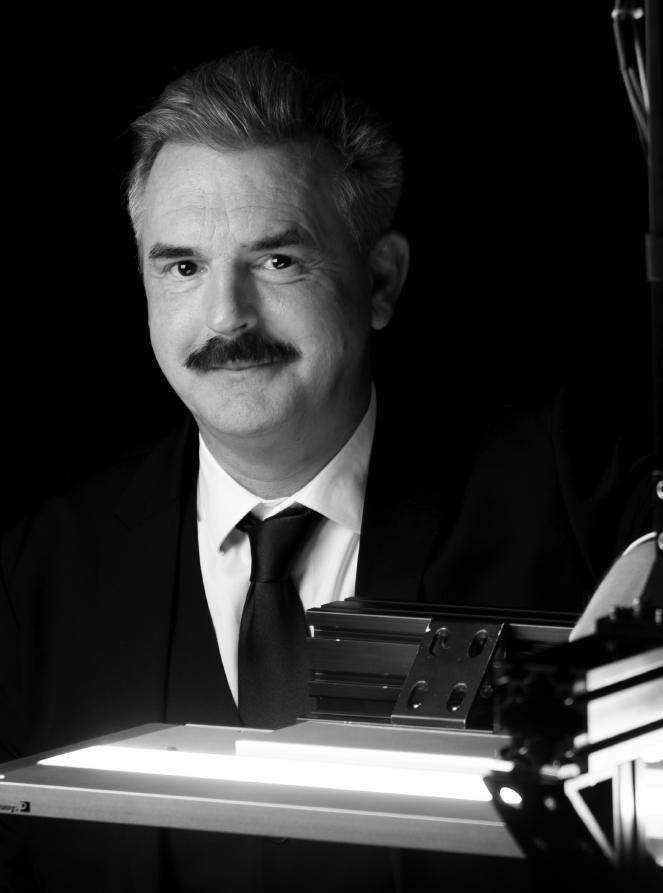
ProfessorDr.CorneliusNeumann
CorneliusNeumann studiedPhysicsand PhilosophyattheUniversityofBielefeld, Germany.AfterhisPhD,heworkedforthe automotivesupplierHellaintheadvanced developmentforAutomotiveLighting.DuringhistimeatHellahewasresponsible forsignallighting,LEDapplicationand actedasadirectoroftheL-LAB,alaboratoryforlightingandmechatronicsinpublic privatepartnershipwiththeUniversityof Paderborn,Germany.In2009,hebecame ProfessorforOpticalTechnologiesinAutomotiveandGeneralLightingandoneof thetwodirectorsoftheLightTechnology InstituteattheKarlsruheInstituteofTechnology,Germany.
Dr.PratibhaSHARMA,DirectorofApplicationsResearchand DevelopmentandSayaHAN,DirectorBusinessDevelopmentat Violumas
Ultravioletlight-emittingdiodes(UV LEDs)havegainedsignificantpopularityinthepastdecadeandare beingusedinmanydiverseapplications,fromwaterandairdisinfection tocuringandhorticulture [1].However,thechoiceofasuitableUVLED isapplication-drivenandcanbechallengingduetothenumeroussetsof specificationswhichneedtobeexaminedwhendesigningasystem.This articleaimstoprovideaguidelineto systemdesignerstoselectLEDsusingtechnicalspecificationsandmake informeddecisionsbasedontheirapplication.
CommercialUVLEDsareprimarilyavailable inthreewavelengthbands:UVA,UVBand UVC.Thelongerwavelengthsbetween 314nmand400nmfallundertheUVA band.TheUVBcategoryiscomposedof ≈ 280–315nmlightwhileUVCrepresents 100–280nmUVlight.
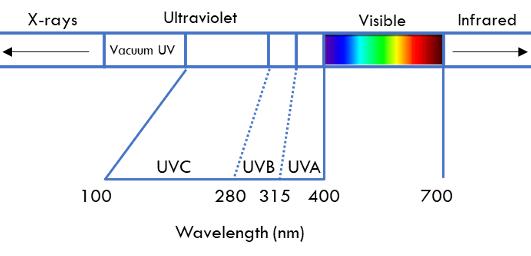
Figure1: Ultravioletlightwavelengthbands. WhilepopularapplicationsofUVALEDs includecuring,fluorescencespectroscopy, forensicscience,photocatalysis,security andauthentication,morerecentapplicationsincludephototherapy,visiblelight disinfection,andartconservation [2]
UVBLEDsareprimarilyemployedforphototherapy(forskinconditions),analytical chemistry(fluorescencespectroscopy),and
plantgrowth [3].UVCLEDswithshorter wavelengthsareknowntoreducemicrobial loadsbydenaturingmicrobialDNA.Hence, theseLEDsofferapromisingsolutionfor variousdisinfectionapplications,specificallyinwater/airtreatment,foodsafety, andmedicaldevicedisinfection [4]
Giventhevarietyinthewavelengthtypes, itisimportanttounderstandapplication requirementstoselectthemostoptimal UVLEDwavelength.Itisimportantto notethatUVLEDsemitinabandofwavelengths,mostlyrangingaround10–12nm, centeredaroundapeakwavelength(λp). So,thepeakwavelengthmustbechosen inalignmentwiththespectralrequirements oftheapplication.Forexample,foradisinfectionsystem,a265nmpeakwavelength LEDwillperformbetterthana365nmLED, astheDNAactionspectrumalignswiththe 265nmpeak.Whileforsomeapplications, thischoicemaybestraightforward,others benefitfromusingahigherefficiencyLED withadifferentpeakwavelength.
CommerciallyavailableUVLEDscome inseveraldifferentpackagetypes.The suitabilityofthepackagedependsonthe application.Mostpopularpackagetypes include:
• Transistor-Outline-Can(TO-Can): TO-cansareavailableinmetalcanswith orwithoutlenses,mostlyinhermetic packages.UVLEDTO-canstypically havelowopticaloutputsandaremost commonlyusedinopticalsensingapplications.
• Surface-MountTechnology(SMT): SMTdevicesareidealforapplications requiringmultipleLEDs,assurface mountdevices(SMD)canbedirectly solderedontoPCBs,offeringdesign flexibilityandenablingcountlessapplica-
tions.Well-suitedformassproduction, SMTsoffercompetitivepricing.
• Chip-on-Board(COB): COBpackagesfeaturesingleormultipleLEDchips directlymountedonacommonsubstrate,providinghighopticaloutputand customizationoptionsforlarge-area applications.UnlikeSMDs,COBsare ’plug-and-play’solutions,eliminatingthe needforadditionalPCBdesignandconfiguration.ManufacturersofferCOBsin variousforms,suchasrings,rectangles, andlinearbars,toaccommodatediverse applicationneeds.
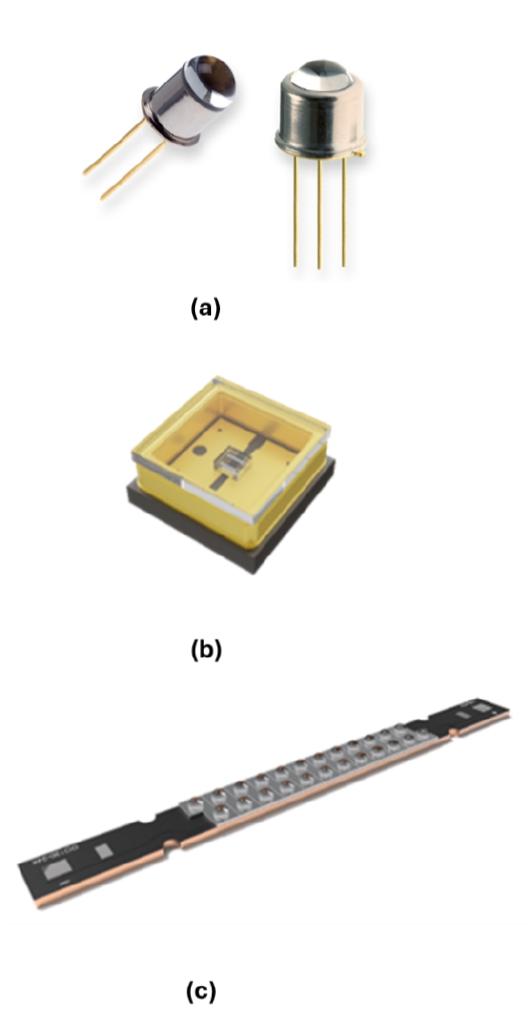
Figure2: Exampleofa(a)TO-Canpackage[5], (b)anSMTpackage[6]and (c)aCOBpackage[6].
Thechoiceofpackagetypemaydepend ontheopticaloutputneeds,thermalperformance,mechanicalconstraints,and lifetimes.
Opticaloutput,oftenreferredtoas“radiantflux”intechnicalspecifications,isthe totalamountoflightemittedbyaUVLED inalldirectionsandistypicallymeasured inmilliwatts(mW)orwatts(W).Thisvalue isdirectlyinfluencedbytheLEDdriving currentandaffectssystemperformance, systemdesign,anddevelopmentcosts andthereforeneedstobeevaluatedprecisely.
Radiantfluxvaluesaretypicallymeasured inanintegratingsphereandactasametric forcomparisonwithLEDsfromdifferent manufacturers.However,lackofstandardizedsensorsandtestingprotocolscan causeambiguityanddiscrepancyinvalues acrossmanufacturersleadingto2–10× theerror [7].Thus,designersmustseek informationonhowtheopticaloutputis measuredorperformtheirownmeasurementsbeforefinalizinganLED.Inaddition, sincethelightemittedismeasuredinalldirections,sideemissionswouldbeincluded inthesevaluesbutmaynotbeapplicableforapplicationsinwhichtheemitted lightisdirecteddowntoacertaintarget area.Therefore,whileradiantfluxvalues maygiveaninitialreferencepointforselection,irradiancevaluesmeasuredatspecific throwdistancesmaygiveabetterideaof theintensityreceivedonatargetarea.
Opticalsimulationscangreatlyaidinestimatingirradiancevalueswithoutdevelopingprototypesandperformingactual measurements. Figure 3 showsirradiance mapsgeneratedusingopticalsimulationof a365nmUVALEDatdifferentthrowdistances.
Beamanglecontrol: EngineeringtheirradiancedistributionofanLEDisviableby usingspecificopticalcomponentstofocus lightoncertainareas.Beamanglesrefer totheangularspreadoflightemittedbyan LED.Typicallymeasuredindegrees,itis mostlydefinedindatasheetsnumericallyor bymeansofapolarplot,thefull-widthhalf maximumofwhichisdefinedasthe beam angle.BaredieLEDsspreadlightover130 to140deg.anglesandsohighirradiances overasmalltargetareamaybedifficult toachievewiththisbroaddistribution.It isalsoimportanttolookatuniformityand throwdistanceconsiderationswhenselectingopticalcomponents.Whilenarrow beamanglesarenecessarytofocuslight overlongerthrowdistances,widerbeam anglespromiseamoreuniformdistribution atshorterthrowdistances.Applications suchasUVspotcuringand3Dprintingoftenrequirenarrowerbeamanglestofocus

Irradiancemapsgeneratedusingopticalsimulationsofa365nmUVALEDatdifferentthrow distances.Irradiancevaluesin mW/cm2
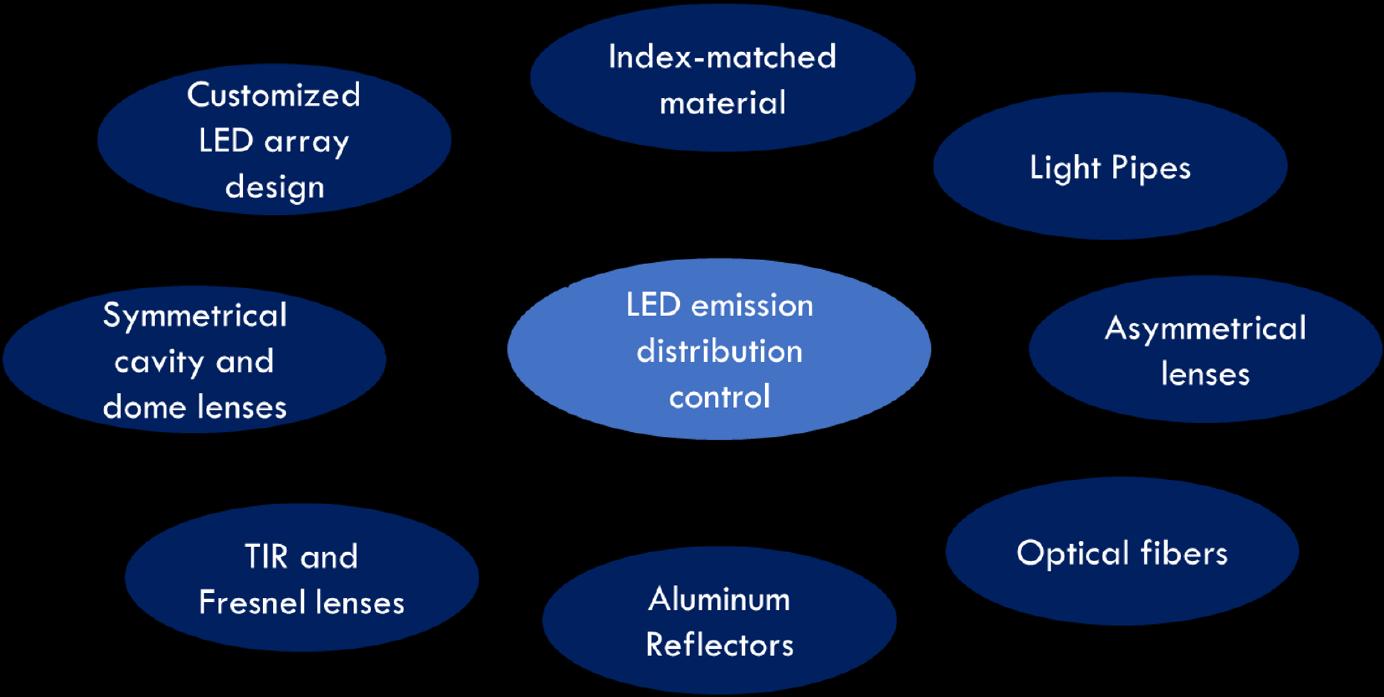
CommerciallyavailablemethodstooptimizeLEDemissioncharacteristics.
lightonatightspot,butapplicationssuch asdisinfectionandhorticulturecanwork withmoredistributedsources.
Opticssuchasdifferenttypesoflenses, lightpipes,andreflectorsenableavariety ofbeamanglesallowingformanyunique distributionsusingthesameLEDdie.Opticaloutputmaybeboostedusingindex matchedmaterialsincombinationwith specificlenstypes.Additionalsecondary optics(notapartoftheLEDpackage)may alsobeusedtoobtainaspecificbeam profile.However,wavelength-dependent materialpropertiesmustbetakenintoconsiderationwhenselectingsuchoptics.If asecondaryopticisused,thetransmissionlossesmustbeconsidered,andcost trade-offsmustbeevaluated(Figure 4).
UVLEDspecificationsheetstypically includedetailedelectricalcharacteristics,suchasforwardvoltageandrecommendeddrivingcurrent.Thesedevicesoperateondirectcurrent(DC),andsomostly requireanexternalpowersupplyunit(PSU)
toconvertACwallpowertoaconstantcurrentDCsupply.EvenformultipleUV LEDs,asinglePSUmightsuffice.However,thedesignermustcarefullyanalyze series/parallelcircuitconfigurationstoensure:
• VoltageCompatibility: ThetotalforwardvoltageoftheLEDarrayshouldfall withinthePSU’soutputvoltagerange. UVLEDsmaybecategorizedbyforward voltagebins,andthedesignershould selectappropriatePSUstomeettherequirementofthedifferentbins.
• SafetyLimits: Forsafetyreasons,itis recommendedthatthecircuitconfigurationshouldnottypicallyexceedatotal voltageof60VDC.
• CurrentProtection: Thedrivecurrent flowingthrougheachindividualUVLED mustneverexceedthemanufacturer’s specified“absolutemaximum”.
ThedimensionsandweightofthePSU mayalsobeconsideredifthereareany mechanicaldesignrestrictions.
TheremaybeapplicationswheretheLED needstoberunatalowerpowerthanthe typicalvalues.Inthosecases,dimmingen-
abledPSUsmustbeused.Opticaloutput ofUVLEDsistypicallydirectlyproportional tothedrivecurrent.So,itisimportantto lookattheopticaloutputvs.drivecurrent curve,usuallyincludedindatasheetsto seehowtheLEDcanbedimmed.Analog dimmingoptionsincluderesistivecontrolor 0-10Vcontrol.
Anothermethodofdimmingisbyusing pulsewidthmodulation(PWM)whichallowsforgreatergranularityandaccuracyin dimming.Thefrequencyanddutycycleof aPWMsignalcanbevariedtodimatdifferentcurrentlevels.NotethatsomePSUs mayprovideaPWMoptionfordimming butmaynotbeusingthePWMsignalin thetrueformtovarythecurrent.Instead, theoutputcurrenttotheLEDsmaybe constantbutproportionaltothePWMsignal.OperatingtheLEDusingaPWMsignal mayalsohelpinloweringtheoperating temperature [8]
Duetotheirmaterialcompositionandhigh sensitivitytotemperature,UVLEDsare particularlysusceptibletothedetrimental effectsofheat.Properthermalmanagementiscrucialforsuccessfulintegrationof UVLEDsintovarioussystems.
Importantmetricstoconsiderwhenevaluatingthermalcharacteristicsinclude:
• JunctionTemperature isthetemperatureattheactive,light-emittingregionof theLEDchip.Elevatedjunctiontemperaturescansignificantlyshortenlifespan andcompromisereliability.Junction temperaturedirectlyinfluencesbothradiantflux(lightoutput)andLEDlifetime. Therefore,accurateestimationofsystem junctiontemperaturesisessentialwhen interpretingradiantfluxvalues.While directmeasurementofjunctiontemperatureischallenging,manymanufacturers provideatestpoint(Tc)onthedevice itselftomeasurethechiptemperature. Systemdesignerscanrequestmanufacturerstovalidatetherelationship betweenTcandjunctiontemperature(Tj) toenablemoreaccurateestimations.
• Thermalresistance defineshoweffectivelyheatcanbeextractedoutof theLED.Junctiontemperaturescan bereducedsignificantlyifthethermal resistanceisminimized.Specification sheetsoftenlistthermalresistancevalues,facilitatingcomparisonsbetween differentLEDpackagetypes.Some packagesmayofferanadditionalthermalpadwhichreducestheoverallther-

malresistanceandallowsforefficient heatextraction [6].Thesevaluescanbe usedtoestimatethermalbudgetsfora systemandselectappropriatepassive oractivecoolingsolutions(Figure 5). Thermalsimulationsofthesystemcan greatlyassistinestimatingjunctiontemperatures,potentiallyreducingdevelopmentcostsandtimelines.
LEDlifetimeistypicallycalculatedasthe operatingtimeatwhichtheLEDoptical outputataspecificwavelengthdropsto 70%oftheinitialvalue(L70).WhilelonglastingLEDsaredesirable,itisimportant toexaminethespecificoperatingconditionsunderwhichtheselifetimeswere measured.Higherjunctiontemperatures (Tj)andincreasedcurrentdensitiescan potentiallyshortenLEDlifetimes.Forinstance,amanufacturermightadvertisea 20,000-hourlifetimeforaparticularLED, butthisfiguremightbebasedontestingataTjof45°Candadrivecurrentof 350mA.Whilethisdataoffersageneral guideline,itisinsufficientforestimatinglifetimesforsystemswithoperatingconditions suchasaTjof60°Candadrivecurrentof 500mA.Thus,in-houselifetimetestingat theintendedoperatingconditionsishighly recommended.
Othertrade-offstobeconsidered whenselectingUVLEDs
• Wavelengthvs.Efficiency: TheconversionefficiencyofUVLEDdevicescan beexpressedintheformofthewall-plug efficiencies(WPE)definedasfollows:
WPE = POUT I V (1)
Where POUT istheopticaloutputpower, I istheforwardcurrent, V isthevoltage ofoperation
Electricalefficiencyincreasemaycome atthecostofswitchingtoalonger wavelength.However,ifWPEsarecomparablefortwodifferentwavelengths, itisbettertousethewavelengththat providesahigheroverallperformance. Forexample,between280nmand 265nmsystems,the280nmmayhave amarginallybetterWPEthanthe265nm LED.However,whenusedforadisinfectionapplication,the265nmshowsa muchbetterlogreductionascompared tothe280nmandwouldbetheLEDof choice.
• Uniformityvs.Cost: Uniformirradiancedistributionsarehighlydesirablefor mostapplications.Inmanyapplications suchascuring,suchmetricsarearequirement.Toensurehighuniformity,the LEDcountmustbeincreasedandthe costtodevelopsuchsystemscanbe veryhigh.Insuchcases,atrade-offbetweenuniformityandcostmustbecarefullyconsidered.However,bystrategicallyadjustingfactorslikeLEDspacing, employingmultiplelenses,andvarying throwdistances,itispossibletomitigate costsandreducetherequirednumber ofLEDswhilemaintainingacceptable levelsofuniformity.CustomLEDarray designoptionscanaidinachievingsuch targets.
• Currentdensityvslifetime: Higher drivecurrentsimplyhigherjunctiontemperatures.Ifthermalsolutionsarenot optimized,highjunctiontemperatures canreduceLEDlifetimes.So,thetarget lifetimesmustbeconsideredwhenlookingathighdrivecurrents.
• Spectralpurityvscost: Someapplicationssuchasfluorescencespectroscopy,UV-visiblespectrophotometry, andphotodynamictherapyrequirea higherspectralpurity(shorterwavelengthemissionrange)thanotherswhich canaddtoproductioncostsandcan affectUVLEDselection.
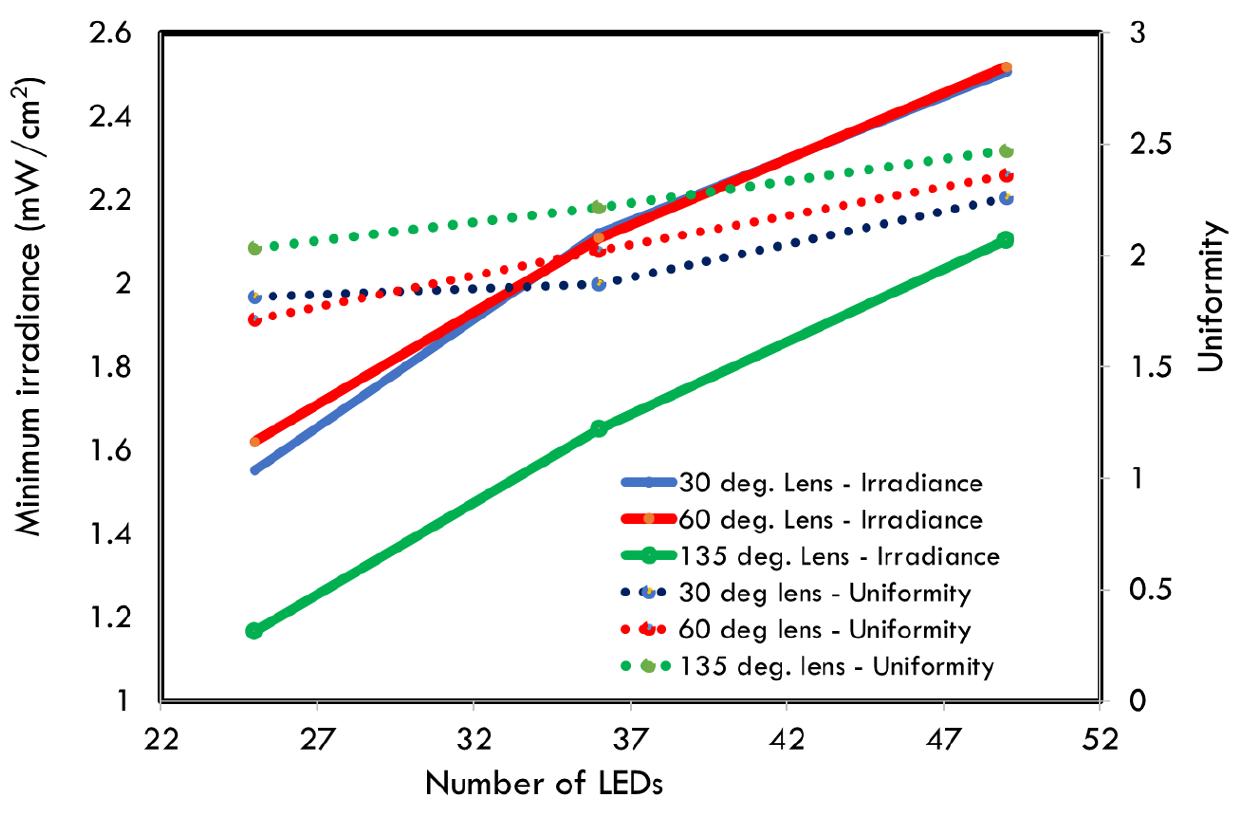
Figure6: Comparisonofvariousopticstypesforadisinfectiondevicedesignwithcustomarraysusing265 nmLEDs[9].
Whilestandard,commerciallyavailableUV LEDproductsmaysufficeforcertainapplications,customarraydesignenablesthe developmentofnicheproductsandprovidesgreaterflexibilityandadaptabilityto producetailor-made,application-specific solutions.Suchsolutionsrequireclarity intermsoftheapplicationrequirements, thoroughnessonthesystemdesignaspect aswellasadeeperunderstandingofhow theLEDswouldbeintegratedintothesystem/product.WhileSMDsandCOBsmay besuitableforprototypingneeds,custom arraysaresoughtmoreoftenforfinaldesignsgearedforproduction(Figure 6).
PricingofUVLEDsdependsheavilyon theemissionwavelength,withUVCLEDs typicallybeingsignificantlymoreexpensivethanUVALEDspermilliwattofoptical power.Inaddition,systemcostsincrease withtheadditionofopticalelements,correspondingPSUs,thermalsolutionsas wellasmechanicalcomponents.System designers,whenevaluatingcostsshould considerthesysteminitsentiretyasopposedtoindividualLEDcosts,although LEDcostsmaybeadominantfactorinthe overallsystemcosts.Inadditiontotheinitialcosts,itisalsoimportanttofactorin LEDlifetimesaswellasreliabilitydependingontargetedsystemlifetimes.Asteeper degradationcurvewouldhighlightagreater decayintheoutputovertime.Thismeans thattheexposuretimesmayhavetobe
changedmorerapidly,specificallyfordisinfectionandcuringapplications,which couldleadtoasignificantchangeinsystemdesignparameters.ForvisibleLEDs, wallplugefficiencyisusuallyakeyfactor indeviceselection.However,forUVLED systems,considerationslikedevicelifetimesandoverallsystemcostsoftentake precedenceoverefficiencycomparisons.
UVLEDshavemadesignificantstrides, reachinghundredsofmilliwattsinopticaloutputandfindingapplicationsacross variousindustries.However,selectingUV LEDsremainschallengingduetovarying specificationstandardsandcharacterizationmethods.Systemdesignersmust carefullyconsidermultiplefactors,includingopticaloutput,efficiency,opticalelements,andthermalsolutions,toselect LEDsbasedontheirapplication. ■
Author Dr.PratibhaSHARMA isthe DirectorofApplicationsResearchandDevelopmentatViolumas/CofanThermal. SheholdsaPh.D.inelectricalengineering fromUniversityofOttawa,Canada,andan M.A.Sc.degreeinelectricalengineering fromtheUniversityofVictoria,Canada.Her currentresearchinterestsincludeoptoelectronicdesignofLED-basedsystems andtheapplicationofLEDsfordisinfection, foodprocessing,andgenerallighting.
Author Ms.SayaHAN istheDirectorof BusinessDevelopmentatViolumas,Inc., specializinginmanagingprojectsforhigh power,industrialultravioletapplications. SheisagraduatefromNorthwesternUniversityandhasbeenamemberoftheInternationalUltravioletAssociation(IUVA) since2018.
[1] Kneissl,M.,Seong,TY.,Han,J.etal.Theemergenceandprospectsofdeep-ultravioletlight-emitting diodetechnologies.Nat.Photonics13,233–244 (2019). https://doi.org/10.1038/s41566-019-0359-9
[2] Kioyi,Ed.TheStateofUV-LEDCuring:AnInvestigationofChemistryandApplications.Phoseon Technology https://phoseon.com/wp-content/uploa ds/2019/10/UV-LED-Curing-Chemistry-and-Applicati ons_RadTech-Intl_7-10-2013.pdf
[3] BouceiroMendesRMDA,AlpalhãoMDB,FilipePL. UVBphototherapyinthetreatmentofvitiligo:State oftheartandclinicalperspectives.Photodermatol PhotoimmunolPhotomed.2022;38:215–223. https://doi.org/10.1111/phpp.12740
[4] Hsu,T.-C.;Teng,Y.-T.;Yeh,Y.-W.;Fan,X.;Chu, K.-H.;Lin,S.-H.;Yeh,K.-K.;Lee,P.-T.;Lin,Y.;Chen, Z.;etal.PerspectivesonUVCLED:ItsProgress andApplication.Photonics2021,8,196. https: //doi.org/10.3390/photonics8060196
[5] Website: https://www.roithner-laser.com/deepuv/to _325.html
[6] Website: https://violumas.com/
[7] StandardizationofaUVLEDPeakWavelength, EmissionSpectrum,andIrradianceMeasurementand ComparisonProtocol,KariSholtes,RyanKeliher,and KarlG.Linden,EnvironmentalScience&Technology 201953(16),9755-9763.DOI: 10.1021/acs.est.9b 02567
[8] MicrosoftWord-RuiZhou_CWandPWM_Feb2020.doc(radtech2020.com)
[9] P.Sharma,P.Chen,S.HanandP.Chung,“OptimizingUVLEDemissioncharacteristicsforan efficientmoduledesign,”2022PhotonicsNorth (PN),NiagaraFalls,ON,Canada,2022,pp.1-1,doi: 10.1109/PN56061.2022.9908416
Formoreinformationvisit violumas.com

RobertdeJonge,VPofSales&BusinessDevelopmentforthe EMEAregion,presentsthecompanyanditsproductsinthree experttalks,explainingapplicationsofthelatestLED developmentsandtechnologies.
https://youtu.be/JCDNHgOOM6c
Luminus,a photonicsinnovator,offers high-performancelighting and LED solutions acrosssectors,utilizing advancedtechnology toimpactmarkets like healthandwell-being, metaverse applications, automotive,and consumerlighting.Theirtargetedproducts supportapplicationsin medicalimaging, sanitation,and augmentedreality
Backedby San’anOptoelectronics, Luminusmaintainsa scalablesupply chain forefficient,high-volumeproduction. Knownfor market-leadinginnovations, includingthe brightestlightsources and long-lifeproducts,Luminusemphasizes precisewavelengthtargeting and high photondensity.Theirproductsmeet ISO certifications andcomplywith RoHS and REACH,underscoringtheir reliability and performance.
https://youtu.be/8966w6jGLn4
Luminusisa pioneeringphotonicscompany focusedon specialtylighting with high fluxdensity and coloraccuracy Theirportfolioincludesinnovative LEDsolutions fordiverseapplications,suchas architecturallighting, directionallighting,and portablelighting.Productslike the LUXCOBLEDs offersuperior color quality and highCRI,whilethe Robusto COB seriesprovidesenhanced reliability andlongevity.
Luminus’stechnologyemphasizes spectrumengineering,withphosphorinnovationsandawiderangeof wavelengths Their globalsupplychain andpartnershipsensureproductionscalabilityand performance.Compliantwith ISOcertifications and RoHS/REACHstandards, Luminusproductsaretrustedforapplicationsdemanding qualitylightoutput, thermalefficiency,andcompactdesign acrossindustrial,medical,andcommercial sectors.
https://youtu.be/YlwRRQ-ngXQ
Luminusspecializesin high-intensity specialtylighting solutions,withproductsthattargetdiverseapplicationssuch as medicalimaging, 3Dprinting,
stagelighting, nightvision,and horticulture.Theirofferings,including highpowerLEDs and lasers,provideprecise wavelengthtargeting andexceptional fluxdensity,optimizedfor thermalmanagement andlong-lastingperformance.
Luminus’s UVCandUVALEDs serve high-demandsectorslike sanitation and industrialcuring,whiletheir IRLEDs support biometrics, sensing,and nightvision.Theportfolio’s highCRILEDs ensurevividcolorfidelity,criticalfor studiolighting and medicalapplications Leveraginga scalablesupplychain and in-house chiptechnology,Luminusremainsaleaderindurable,precisionlighting solutionsacrossspecializedmarkets.
Supportedby
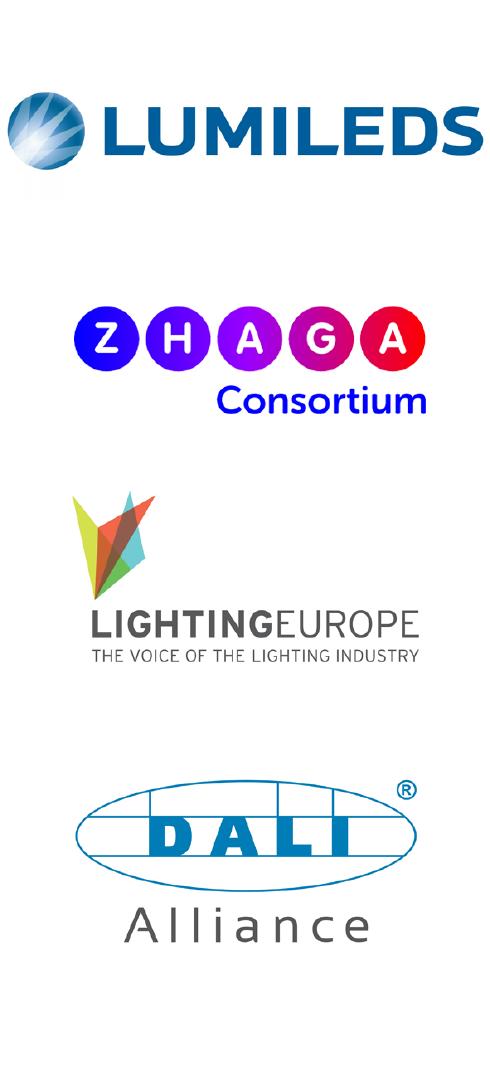
Formoreinformationvisit: https://www.luminus.com/





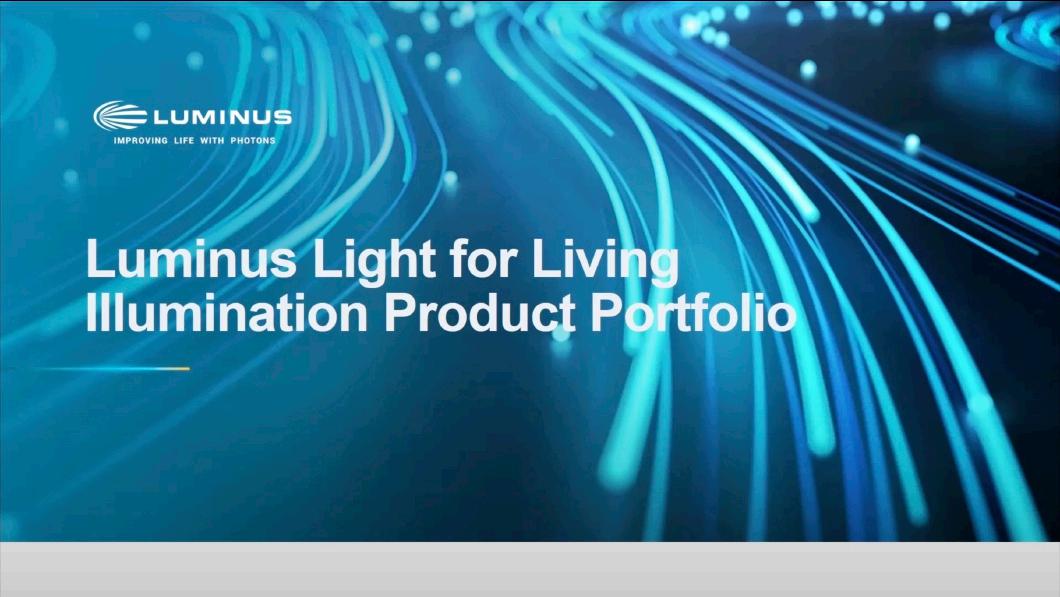


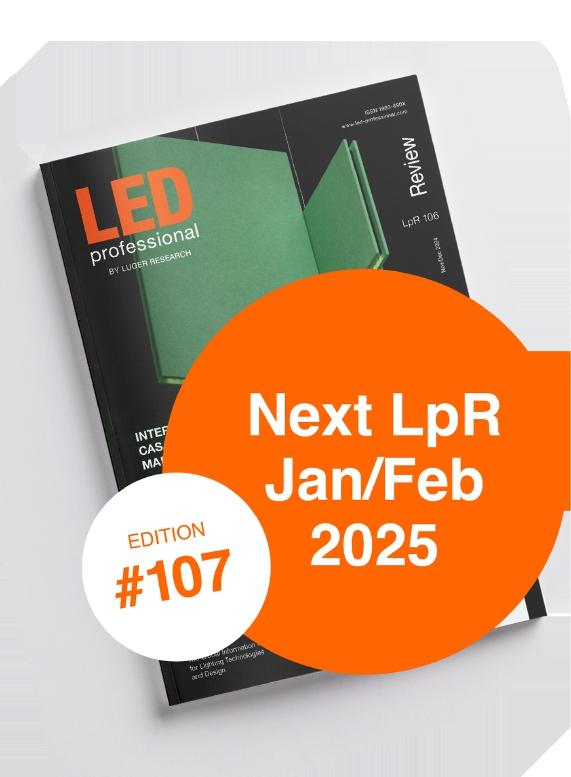
ADCLOSE
January15,2025
MATERIALDUE
January15,2025
DIGITALPUBLICATION
January31,2025
PRINTPUBLICATION
February15,2025
info@lugerresearch.com
InnovationsinControlsandPerformance ThenextissueofLEDprofessionalReview, LpR#107,featuresexclusiveinterviewswith keyleadersinthelightingsector.Wedive intoadiscussionwithaDALIAllianceexpert onthelatestadvancementsinDALItechnology,withafocusonwirelesscommunication. Anotherinterviewprovidesinsightsfroma lightingindustryrepresentativeontheopportunitiesandchallengesforthecoming year,exploringpotentialforgroundbreaking innovations.Thisissuewillincludeparttwo ofBartenbach’sresearchstudyonenergy efficiency.Fortheautomotivesector,we highlightcutting-edgedevelopmentsincontrolsystemsandchipdesign.Inadditionto allthat,youcanlookforwardtoanin-depth articleonDCsystemsinlightingarchitecture. And,asusual,wewillbebringingyouthelatestupdatesfromthegloballightingindustry, alongwithacommentaryfromaprominent figureinthefield.
∗ Subjecttochangewithoutnotice.
LEDprofessionalReview(LpR) ISSN1993-890X
PublishingCompany
LugerResearche.U.|©2001–2024 InstituteforInnovation&Technology Moosmahdstrasse30,A-6850Dornbirn,Austria,Europe info@lugerresearch.com|www.lugerresearch.com P+435572394489|F+43557239448990
Publisher
SiegfriedLuger
Editors
Dr.GüntherSejkora
Subscribe
https://www.led-professional.com/misc/sub scribe
Advertise
https://www.led-professional.com/advertise
LpRDigitalMagazine
• eMagazine(PDFdownload)
• 6IssuesperYear(Bi-monthly)
• FullArchiveAccess (allpreviouseMagazineissues)
• BusinessIssuetoshareandusewithin organizations
• EUR78.80
LpRPrinted&DigitalMagazine
• PrintMagazineincludingshipping
• eMagazine(PDFdownload)
• 6IssuesperYear(Bi-monthly)
• FullArchiveAccess (allpreviouseMagazineissues)
• Shippingcostsincluded
• EUR97.80
CoverPage: TheLULLABYcombines minimalistdesignwithsuperioracoustic properties,offeringbothlightingandsound absorption,idealformodernspacesseeking tranquility. www.prolicht.at/en/ Image:(c)PROLICHT.
+4369911335570 s.luger@lugerresearch.com
+43557239448970 editors@led-professional.com
TheresaKönig +43557239448970 editors@led-professional.com
ElioA.Farina +43557239448970 editors@led-professional.com
Art&Design
SarahLuger +436802305445 hallo@moments-of-aha.com
AccountManager
ChristineLuger +4369911335520 c.luger@lugerresearch.com
China,Hong-Kong
LoloYoung +85297922081 lolo@castintl.com
Germany,International ArminWezel +493052689192 armin@eurokom-media.de
India
PriyankaRai +911244787331 priyanka.rai@binarysemantics.com
SouthKorea Jung-WonSuh +8227858222 sinsegi@sinsegimedia.info
Taiwan
LeonChen +886225681786-10 Jeon@jkmedia.com.tw
Benelux,France,Ireland,Scandinavia,UK ZenaCoupé +441923852537 zena@expomedia.biz
USA&Canada
LesleyHarmoning +12186866438 lesley@lhmandco.com
JillThibert +12182802821 jill@lhmandco.com
Theeditorsmakeeveryreasonableefforttoverifytheinformation published,butLugerResearche.U.assumesnoresponsibilityforthe validityofanymanufacturers,nonprofitorganizationsorindividuals claimsorstatements.LugerResearche.U.doesnotassumeand herebydisclaimsanyliabilitytoanypersonforanylossordamage causedbyerrorsoromissionsinthematerialcontainedherein, regardlessofwhethersucherrorsresultfromnegligence,accident oranyothercausewhatsoever.Youmaynotcopy,reproduce, republish,download,post,broadcast,transmit,makeavailableto thepublic,orotherwiseuseLEDprofessionalReview(LpR)content withoutpriorwrittenconsentfromLugerResearche.U.
©2001–2024LugerResearche.U.–InstituteforInnovation&Technology–VATNo.ATU50928705,EORINo.ATEOS1000046213, CommercialRegisterFN316464p,RegionalCourtFeldkirch,Austria, Europe ■
